Fujitsu Client Computing WL0011 AR5B6 XB62 ATHEROS WLAN IN FUJITSU NOTEBOOKS User Manual USERS MANUAL 1
Fujitsu Limited AR5B6 XB62 ATHEROS WLAN IN FUJITSU NOTEBOOKS USERS MANUAL 1
Contents
- 1. USERS MANUAL 1
- 2. USERS MANUAL 2
USERS MANUAL 1

FCC ID: EJE-WL0011 (IC: 337J-WL0011) Report No. M060223_Cert_AR5BXB6_NII
EMC Technologies Pty Ltd – 57 Assembly Drive, Tullamarine VIC 3043 Australia
www.emctech.com.au
EMC Technologies Report Number: M060223_Cert_AR5BXB6_NII
APPENDIX I1
FUJITSU NOTEBOOK USER MANUAL (part 1)
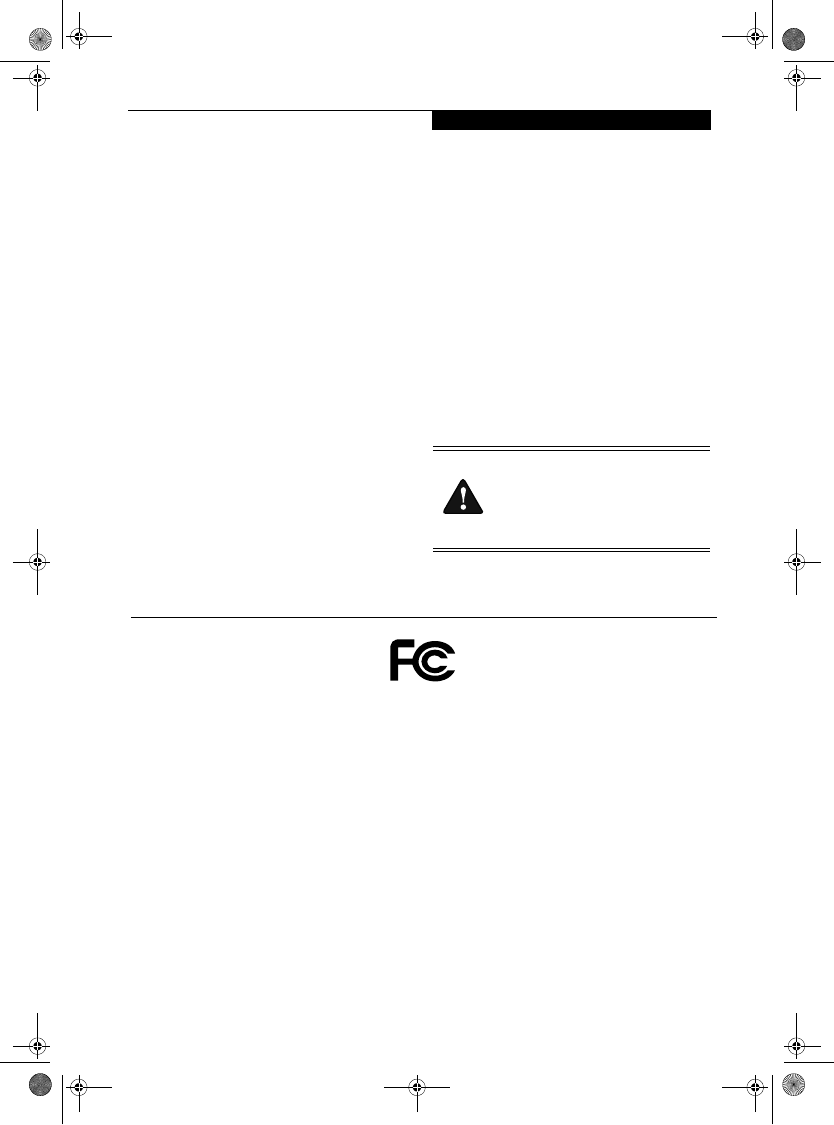
Copyright
Copyright and Trademark Information
Fujitsu Computer Systems Corporation has made every
effort to ensure the accuracy and completeness of this
document. However, as ongoing development efforts are
continually improving the capabilities of our products, we
cannot guarantee the accuracy of the contents of this
document. We disclaim liability for errors, omissions, or
future changes.
Fujitsu, the Fujitsu logo, and LifeBook are registered
trademarks of Fujitsu Limited.
Microsoft, MS-DOS, and Windows are either registered
trademarks or trademarks of Microsoft Corporation in the
United States and/or other countries.
PCMCIA is a trademark of the Personal Computer
Memory Card International Association.
Intel, Pentium, and SpeedStep are trademarks or registered
trademarks of Intel Corporation or its subsidiaries in the
United States and other countries.
Netscape is a registered trademark of Netscape
Communications Corporation.
Adobe, Acrobat, and Acrobat Reader are either registered
trademarks or trademarks of Adobe Systems Incorporated
in the United States and/or other countries.
All other trademarks mentioned herein are the property
of their respective owners.
© Copyright 2005 Fujitsu Computer Systems Corporation
All rights reserved. No part of this publication may be copied,
reproduced, or translated, without prior written consent of
Fujitsu Computer Systems Corporation. No part of this publi-
cation may be stored or transmitted in any electronic form
without the written consent of Fujitsu Computer Systems
Corporation.
B6FH-6061-01EN-00
Warning
Handling the cord on this product will expose
you to lead, a chemical known to the State of
California to cause birth defects or other
reproductive harm.
Was h hands afterhandling.
DECLARATION OF CONFORMITY
according to FCC Part 15
Responsible Party Name: Fujitsu Computer Systems Corporation
Address: 1250 E. Arques Avenue, M/S 122
Sunnyvale, CA 94085
Telephone: (408) 746-6000
Declares that product: Model Configurations:
LifeBook Q2010
Complies with Part 15 of the FCC Rules.
This device complies with Part 15 of the FCC rules. Operations are subject to the following two conditions:
(1) This device may not cause harmful interference, (2) This device must accept any interference
received, including interference that may cause undesired operation.
B Series.book Page 1 Tuesday, April 26, 2005 3:08 PM
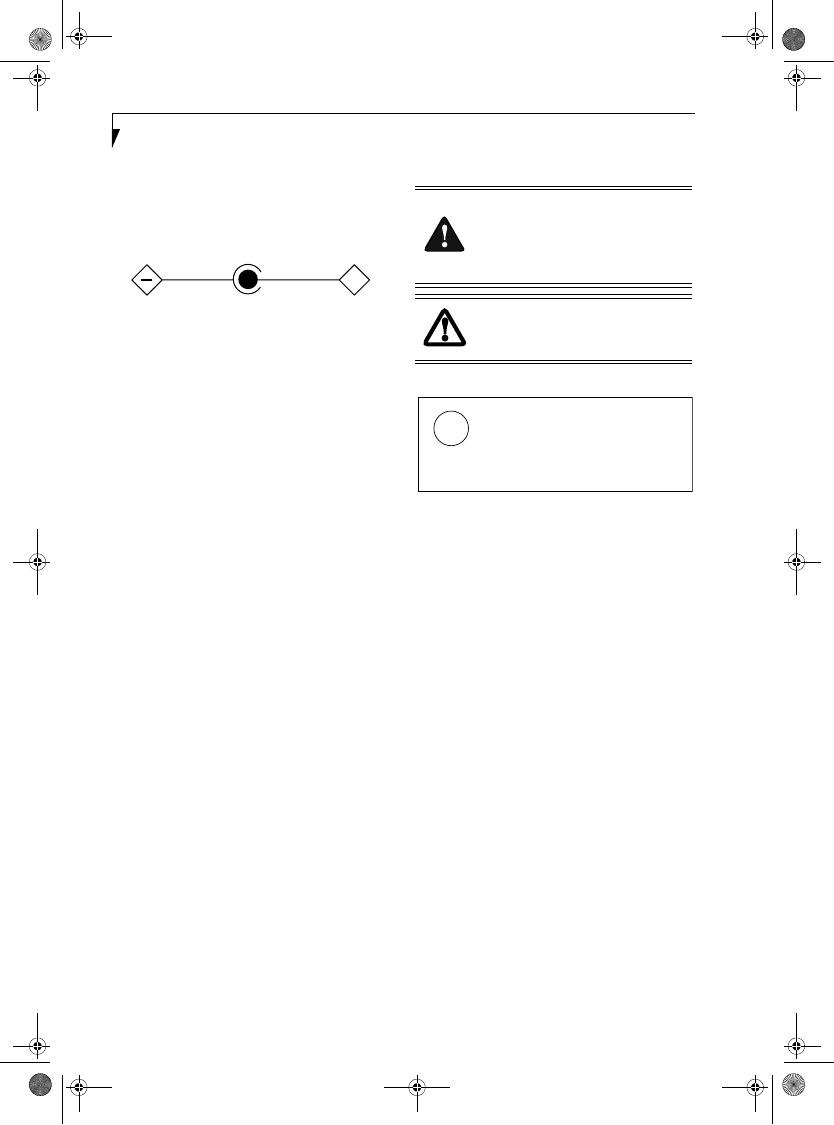
LifeBook B Series
IMPORTANT SAFETY INSTRUCTIONS
This unit requires an AC adapter to operate. Use only UL
Listed Class 2 Adapters with an output rating of 16 V
DC, with a current of 3.75 A.
AC Adapter output polarity:
When using your notebook equipment, basic safety
precautions should always be followed to reduce the risk
of fire, electric shock and injury to persons, including
the following:
■Do not use this product near water for example, near
a bathtub, washbowl, kitchen sink or laundry tub, in a
wet basement or near a swimming pool.
■Avoid using the modem during an electrical storm.
There may be a remote risk of electric shock from
lightning.
■Do not use the modem to report a gas leak in the
vicinity of the leak.
■Use only the power cord and batteries indicated in
this manual. Do not dispose of batteries in a fire. They
may explode. Check with local codes for possible
special disposal instructions.
■To reduce the risk of fire, use only No. 26 AWG or
larger UL Listed or CSA Certified Telecommunication
Line Cord.
SAVE THESE INSTRUCTIONS
For Authorized Repair Technicians Only
System Disposal
+
Danger of explosion if Lithium (clock) bat-
tery is incorrectly replaced. Replace only
with the same or equivalent type recom-
mended by the manufacturer. Dispose of
used batteries according to the manufac-
turer’s instruction.
For continued protection against risk of
fire, replace only with the same type and
rating fuse.
Hg
LAMP(S) INSIDE THIS PRODUCT
CONTAIN MERCURY AND MUST
BE RECYCLED OR DISPOSED OF
ACCORDING TO LOCAL, STATE, OR
FEDERAL LAWS.
B Series.book Page 2 Tuesday, April 26, 2005 3:08 PM

Table of Contents
Fujitsu LifeBook® B Series Notebook
Table of Contents
1
PREFACE
Preface
About This Guide . . . . . . . . . . . . . . . . . . . . . . . . .3
Fujitsu Contact Information . . . . . . . . . . . . . . . . .3
Warranty . . . . . . . . . . . . . . . . . . . . . . . . . . . . . . .3
2
GETTING TO KNOW YOUR
LIFEBOOK NOTEBOOK
Overview
Unpacking . . . . . . . . . . . . . . . . . . . . . . . . . . . . . .7
Locating the Controls/Connectors
Top and Front Components . . . . . . . . . . . . . . . . .8
Left-Side Panel Components . . . . . . . . . . . . . . . .9
Right-Side Panel Components . . . . . . . . . . . . . .10
Bottom Components . . . . . . . . . . . . . . . . . . . . .11
Rear Panel Components . . . . . . . . . . . . . . . . . . .12
Status Indicator Panel
Power Indicator . . . . . . . . . . . . . . . . . . . . . . . . .13
AC Adapter Indicator . . . . . . . . . . . . . . . . . . . . .13
Battery Level Indicators . . . . . . . . . . . . . . . . . . .13
Battery Charging Indicator . . . . . . . . . . . . . . . . .14
Wireless LAN/Bluetooth Access Indicator . . . . . .14
Hard Drive/Removable Media Drive Indicator . .14
PC Card Access Indicators . . . . . . . . . . . . . . . . .14
Compact Flash (CF) Card Access Indicators . . . .14
NumLk Indicator. . . . . . . . . . . . . . . . . . . . . . . . .14
CapsLock Indicator. . . . . . . . . . . . . . . . . . . . . . .14
ScrLk Indicator . . . . . . . . . . . . . . . . . . . . . . . . . .14
Security Indicator . . . . . . . . . . . . . . . . . . . . . . . .14
Keyboard
Using the Keyboard . . . . . . . . . . . . . . . . . . . . . .15
Numeric Keypad. . . . . . . . . . . . . . . . . . . . . . . . .15
Windows Keys . . . . . . . . . . . . . . . . . . . . . . . . . .15
Cursor Keys . . . . . . . . . . . . . . . . . . . . . . . . . . . .15
Function Keys. . . . . . . . . . . . . . . . . . . . . . . . . . .15
Touchpad Pointing Device
Clicking . . . . . . . . . . . . . . . . . . . . . . . . . . . . . . .17
Double-Clicking . . . . . . . . . . . . . . . . . . . . . . . . .17
Dragging . . . . . . . . . . . . . . . . . . . . . . . . . . . . . .18
Touchpad Control Adjustment . . . . . . . . . . . . . .18
Touch Screen . . . . . . . . . . . . . . . . . . . . . . . . . . .18
Volume Control
Controlling the Volume . . . . . . . . . . . . . . . . . . .20
LifeBook Security/Application Panel
Setting up Your LifeBook Security Panel . . . . . . .21
Passwords . . . . . . . . . . . . . . . . . . . . . . . . . . . . .21
Operating Your Security/Application Panel. . . . .22
Precautions. . . . . . . . . . . . . . . . . . . . . . . . . . . . .22
Uninstalling the Security Panel Application . . . . .22
Launching Applications with Application Panel . .23
3
GETTING STARTED WITH
YOUR LIFEBOOK NOTEBOOK
Power Sources
Connecting the Power Adapters . . . . . . . . . . . . .27
Display Panel
Opening the Display Panel . . . . . . . . . . . . . . . . .28
Adjusting Display Panel Brightness . . . . . . . . . . .28
Closing the Display Panel . . . . . . . . . . . . . . . . . .28
B Series.book Page 3 Tuesday, April 26, 2005 3:08 PM

LifeBook B Series
Starting Your LifeBook Notebook
Power On . . . . . . . . . . . . . . . . . . . . . . . . . . . . . 29
Boot Sequence . . . . . . . . . . . . . . . . . . . . . . . . . . 29
BIOS Setup Utility . . . . . . . . . . . . . . . . . . . . . . . 29
Booting the System . . . . . . . . . . . . . . . . . . . . . . 30
Activating Additional Utilities . . . . . . . . . . . . . . . 30
Registering Your LifeBook notebook . . . . . . . . . 31
Power Management
Suspend/Resume Button . . . . . . . . . . . . . . . . . . 32
Standby Mode . . . . . . . . . . . . . . . . . . . . . . . . . . 32
Hibernate Mode. . . . . . . . . . . . . . . . . . . . . . . . . 33
Display Timeout . . . . . . . . . . . . . . . . . . . . . . . . . 33
Hard Disk Timeout . . . . . . . . . . . . . . . . . . . . . . . 33
Windows Power Management . . . . . . . . . . . . . . 33
Restarting the System. . . . . . . . . . . . . . . . . . . . . 33
Power Off . . . . . . . . . . . . . . . . . . . . . . . . . . . . . 34
4
USER-INSTALLABLE FEATURES
Lithium ion Battery
Recharging the Batteries. . . . . . . . . . . . . . . . . . . 37
Replacing the Battery . . . . . . . . . . . . . . . . . . . . . 38
External Floppy Disk Drive
Connecting an External Floppy Disk Drive . . . . . 39
Loading a Disk . . . . . . . . . . . . . . . . . . . . . . . . . . 39
Ejecting a Disk . . . . . . . . . . . . . . . . . . . . . . . . . . 39
Preparing a Disk for Use. . . . . . . . . . . . . . . . . . . 39
PC Cards
Installing PC Cards . . . . . . . . . . . . . . . . . . . . . . . 41
Removing PC Cards . . . . . . . . . . . . . . . . . . . . . . 41
Smart Card Reader. . . . . . . . . . . . . . . . . . . . . . . 41
Compact Flash Cards
Installing Compact Flash Cards. . . . . . . . . . . . . . 42
Removing Compact Flash Cards. . . . . . . . . . . . . 43
Memory Upgrade Module
Installing a Memory Module . . . . . . . . . . . . . . . 44
Removing a Memory Module. . . . . . . . . . . . . . . 44
Checking the New Memory Capacity. . . . . . . . . 45
Port Replicator
Port Replicator Components . . . . . . . . . . . . . . . 46
Attaching Port Replicator . . . . . . . . . . . . . . . . . . 46
Detaching Port Replicator . . . . . . . . . . . . . . . . . 46
Device Ports
Modem (RJ-11) Jack . . . . . . . . . . . . . . . . . . . . . 48
Internal LAN (RJ-45) jack . . . . . . . . . . . . . . . . . . 48
Docking Port . . . . . . . . . . . . . . . . . . . . . . . . . . . 48
Universal Serial Bus 2.0 Ports . . . . . . . . . . . . . . . 48
Microphone/Line-In Jack . . . . . . . . . . . . . . . . . . 48
Headphone/Line-Out Jack. . . . . . . . . . . . . . . . . 48
External Monitor Port . . . . . . . . . . . . . . . . . . . . 49
5
TROUBLESHOOTING
YOUR LIFEBOOK NOTEBOOK
Troubleshooting
Identifying the Problem . . . . . . . . . . . . . . . . . . . 53
Specific Problems . . . . . . . . . . . . . . . . . . . . . . . . 53
Troubleshooting Table . . . . . . . . . . . . . . . . . . . . 54
Power On Self Test Messages . . . . . . . . . . . . . . 61
Modem Result Codes. . . . . . . . . . . . . . . . . . . . . 62
Restoring Pre-installed Software
Restoring the Factory Image . . . . . . . . . . . . . . . 63
Automatically Downloading Driver Updates. . . . 64
6
CARING FOR YOUR
LIFEBOOK NOTEBOOK
Care and Maintenance
LifeBook Notebook . . . . . . . . . . . . . . . . . . . . . . 67
Keyboard . . . . . . . . . . . . . . . . . . . . . . . . . . . . . . 68
Batteries. . . . . . . . . . . . . . . . . . . . . . . . . . . . . . . 68
Floppy Disks and Drives . . . . . . . . . . . . . . . . . . . 68
CDs . . . . . . . . . . . . . . . . . . . . . . . . . . . . . . . . . . 68
PC/CF Cards . . . . . . . . . . . . . . . . . . . . . . . . . . . 69
B Series.book Page 4 Tuesday, April 26, 2005 3:08 PM

Table of Contents
7
SYSTEM SPECIFICATIONS
Specifications
Configuration Label . . . . . . . . . . . . . . . . . . . . . .73
Microprocessor. . . . . . . . . . . . . . . . . . . . . . . . . .73
Memory . . . . . . . . . . . . . . . . . . . . . . . . . . . . . . .73
Video . . . . . . . . . . . . . . . . . . . . . . . . . . . . . . . . .73
Audio . . . . . . . . . . . . . . . . . . . . . . . . . . . . . . . . .73
Mass Storage Device Options. . . . . . . . . . . . . . .73
Integrated Pointing Device . . . . . . . . . . . . . . . . .73
LifeBook Security/Application Panel . . . . . . . . . .74
Security Features . . . . . . . . . . . . . . . . . . . . . . . .74
Communications . . . . . . . . . . . . . . . . . . . . . . . .74
Device Ports . . . . . . . . . . . . . . . . . . . . . . . . . . . .74
Keyboard . . . . . . . . . . . . . . . . . . . . . . . . . . . . . .74
Power. . . . . . . . . . . . . . . . . . . . . . . . . . . . . . . . .74
Dimensions and Weight . . . . . . . . . . . . . . . . . . .74
Environmental Requirements . . . . . . . . . . . . . . .74
Popular Accessories . . . . . . . . . . . . . . . . . . . . . .75
Pre-Installed Software . . . . . . . . . . . . . . . . . . . .75
Learning About Your Software . . . . . . . . . . . . . .75
8
GLOSSARY/REGULATORY
Glossary
Glossary . . . . . . . . . . . . . . . . . . . . . . . . . . . . . . .77
Regulatory
Regulatory Information . . . . . . . . . . . . . . . . . . .84
APPENDIX A: USING THE
WIRELESS LAN DEVICE
Before Using the Wireless LAN
Wireless LAN Modes Using this Device. . . . . . . .90
Wireless Network Considerations . . . . . . . . . . . .91
Deactivating the WLAN Device . . . . . . . . . . . . .91
Activating the WLAN Device . . . . . . . . . . . . . . .92
Configuration of the WLAN Device
Flow of Operations. . . . . . . . . . . . . . . . . . . . . . .93
Configuration Using Atheros Client Utility . . . . .93
Connection to the network. . . . . . . . . . . . . . . . .94
Troubleshooting the WLAN
Troubleshooting Table . . . . . . . . . . . . . . . . . . . .97
Wireless LAN Glossary
Glossary . . . . . . . . . . . . . . . . . . . . . . . . . . . . . . .98
IP address information
About IP Addresses . . . . . . . . . . . . . . . . . . . . .100
Specifications
Specifications . . . . . . . . . . . . . . . . . . . . . . . . . .101
Using the Bluetooth Device
What is Bluetooth. . . . . . . . . . . . . . . . . . . . . . .102
Where to Find Information
About Bluetooth . . . . . . . . . . . . . . . . . . . . . . .102
APPENDIX B: SECURITY
DEVICE USER’S GUIDE
Fingerprint Sensor Device
Introducing the Fingerprint Sensor Device . . . .105
Getting Started. . . . . . . . . . . . . . . . . . . . . . . . .105
Installing OmniPass . . . . . . . . . . . . . . . . . . . . .105
User Enrollment . . . . . . . . . . . . . . . . . . . . . . . .106
Using OmniPass . . . . . . . . . . . . . . . . . . . . . . . .107
Configuring OmniPass . . . . . . . . . . . . . . . . . . .109
OmniPass Control Center . . . . . . . . . . . . . . . . .110
Troubleshooting . . . . . . . . . . . . . . . . . . . . . . . .111
Trusted Platform Module Installation
TPM Installation . . . . . . . . . . . . . . . . . . . . . . . .112
INDEX
Index . . . . . . . . . . . . . . . . . . . . . . . . . . . . . . . 113
B Series.book Page 5 Tuesday, April 26, 2005 3:08 PM

LifeBook B Series
B Series.book Page 6 Tuesday, April 26, 2005 3:08 PM

1
1
Preface
B Series.book Page 1 Tuesday, April 26, 2005 3:08 PM

2
LifeBook B Series
B Series.book Page 2 Tuesday, April 26, 2005 3:08 PM
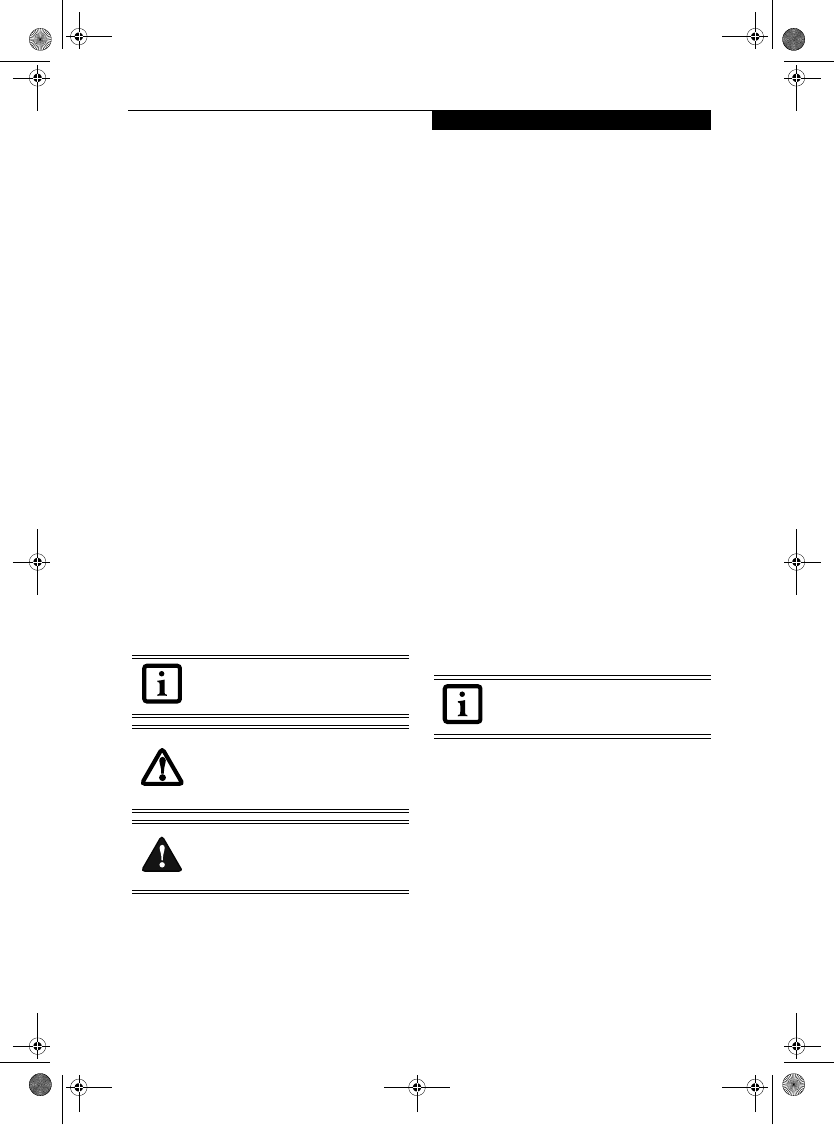
3
Preface
Preface
ABOUT THIS GUIDE
The LifeBook® B Series notebook from Fujitsu
Computer Systems is a powerful notebook computer. It
is powered by an Intel® Pentium® M microprocessor,
has a built-in 12.1" color touch screen display, and
brings the computing power of a desktop personal
computer to a portable environment.
This manual explains how to operate your LifeBook
notebook’s hardware and built-in system software.
Your computer comes with Microsoft Windows® XP
Professional pre-installed.
Your notebook is a completely self-contained unit with
an active-matrix (TFT) color LCD touch screen display.
It has a powerful interface that enables it to support a
variety of optional features.
Conventions Used in the Guide
Keyboard keys appear in brackets.
Example: [Fn], [F1], [Esc], [Enter] and [Ctrl].
Pages with additional information about a specific topic
are cross-referenced within the text.
Example: (See page xx.)
On screen buttons or menu items appear in bold
Example: Click OK to restart your notebook.
DOS commands you enter appear in Courier type.
Example: Shutdown the computer?
FUJITSU CONTACT INFORMATION
Service and Support
You can contact Fujitsu Computer Systems Service and
Support the following ways:
■Toll free: 1-800-8Fujitsu (1-800-838-5487)
■Fax: 408-764-2724
■E-mail: 8fujitsu@us.fujitsu.com
■Web site:
http://www.computers.us.fujitsu.com/support
Before you place the call, you should have the following
information ready so that the customer support
representative can provide you with the fastest possible
solution:
■Product name
■Product configuration number
■Product serial number
■Purchase date
■Conditions under which the problem occurred
■Any error messages that have occurred
■Type of device connected, if any
Fujitsu Online
You can go directly to the online Fujitsu Product catalog
for your notebook by clicking on the Fujitsu Weblinks
-> LifeBook Accessories Web Site link, located in the
Windows Start menu.
You can also reach Fujitsu Service and Support online by
clicking on the Fujitsu Weblinks -> Fujitsu Service and
Support link, located in the Windows Start menu.
WARRANTY
Your LifeBook notebook is backed by an International
Limited Warranty and includes toll-free technical
support. Check the service kit that came with your
notebook for warranty terms and conditions.
The point icon highlights information that
will enhance your understanding of the
subject material.
The caution icon highlights information
that is important to the safe operation of
your computer, or to the integrity of your
files. Please read all caution information
carefully.
The warning icon highlights information
that can be hazardous to either you, your
LifeBook notebook, or your files. Please
read all warning information carefully.
You must have an active internet
connection to use the online URL links.
B Series.book Page 3 Tuesday, April 26, 2005 3:08 PM

4
LifeBook B Series – Section One
B Series.book Page 4 Tuesday, April 26, 2005 3:08 PM

5
2
Getting to Know
Your LifeBook
B Series.book Page 5 Tuesday, April 26, 2005 3:08 PM

6
LifeBook B Series
B Series.book Page 6 Tuesday, April 26, 2005 3:08 PM
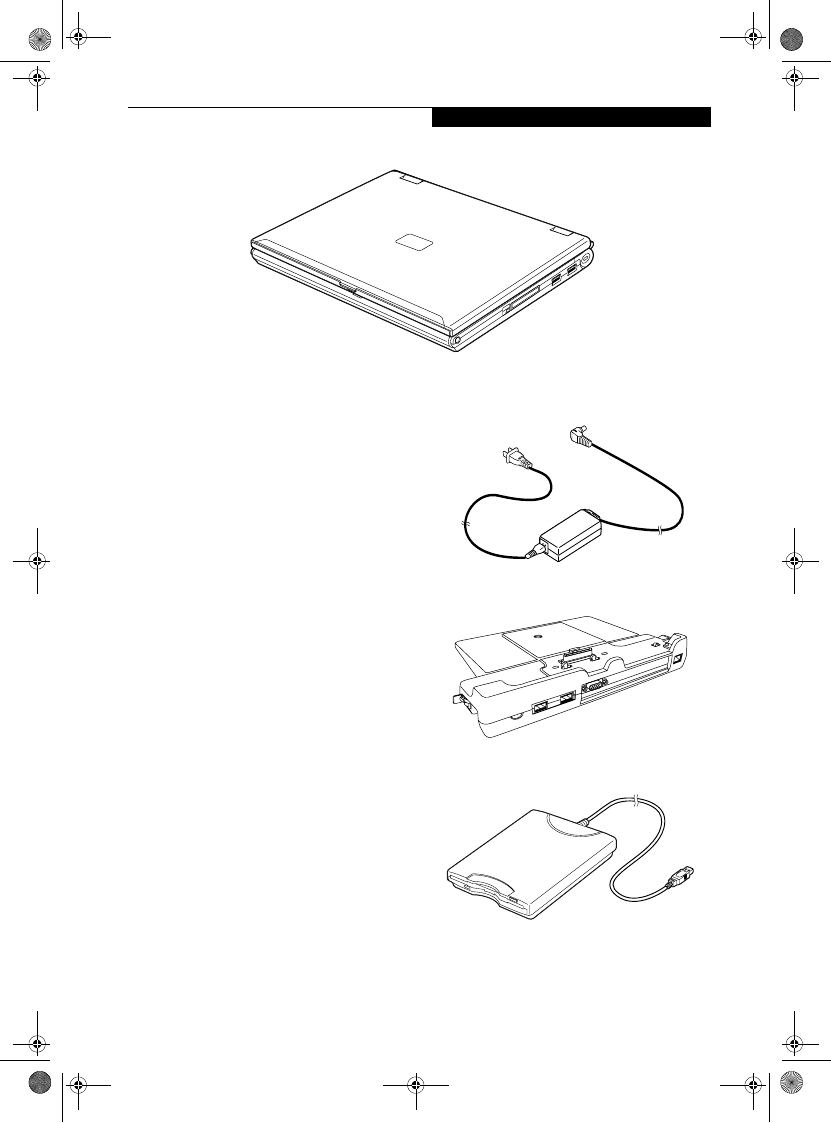
7
Getting to Know Your LifeBook
Figure 2-1. Fujitsu LifeBook B Series notebook
Overview
This section describes the components of your Fujitsu
LifeBook B Series notebook. We strongly recommend
that you read it before using your notebook, even if you
are already familiar with notebook computers.
UNPACKING
When you receive your LifeBook notebook, unpack it
carefully, and compare the parts you have received with
the items listed below.
For a pre-configured model you should have:
■LifeBook B Series notebook (Figure 2-1)
■AC adapter with AC power cord (Figure 2-2)
■Phone/Modem (RJ-11) telephone cable
■Stylus (located in stylus holder)
■Driver and Application Restore CD
■Restore DVD
■Getting Started Guide
■User’s Guide (this document)
■International Limited Warranty Brochure
■Certificate of Authenticity
Depending upon the configuration of your notebook,
you will have one of the following battery
configurations:
■One main high-capacity Lithium ion battery (pre-
installed),
or,
■One main Lithium ion battery pre-installed and one
spare main high-capacity Lithium ion battery
You may also have one or more of the following devices
in the box:
■External USB Floppy Disk Drive (Figure 2-4),
and/or,
■Port Replicator (Figure 2-3)
Figure 2-2. AC Adapter
Figure 2-3. Optional Port Replicator
Figure 2-4. Optional External USB Floppy Disk Drive
B Series.book Page 7 Tuesday, April 26, 2005 3:08 PM
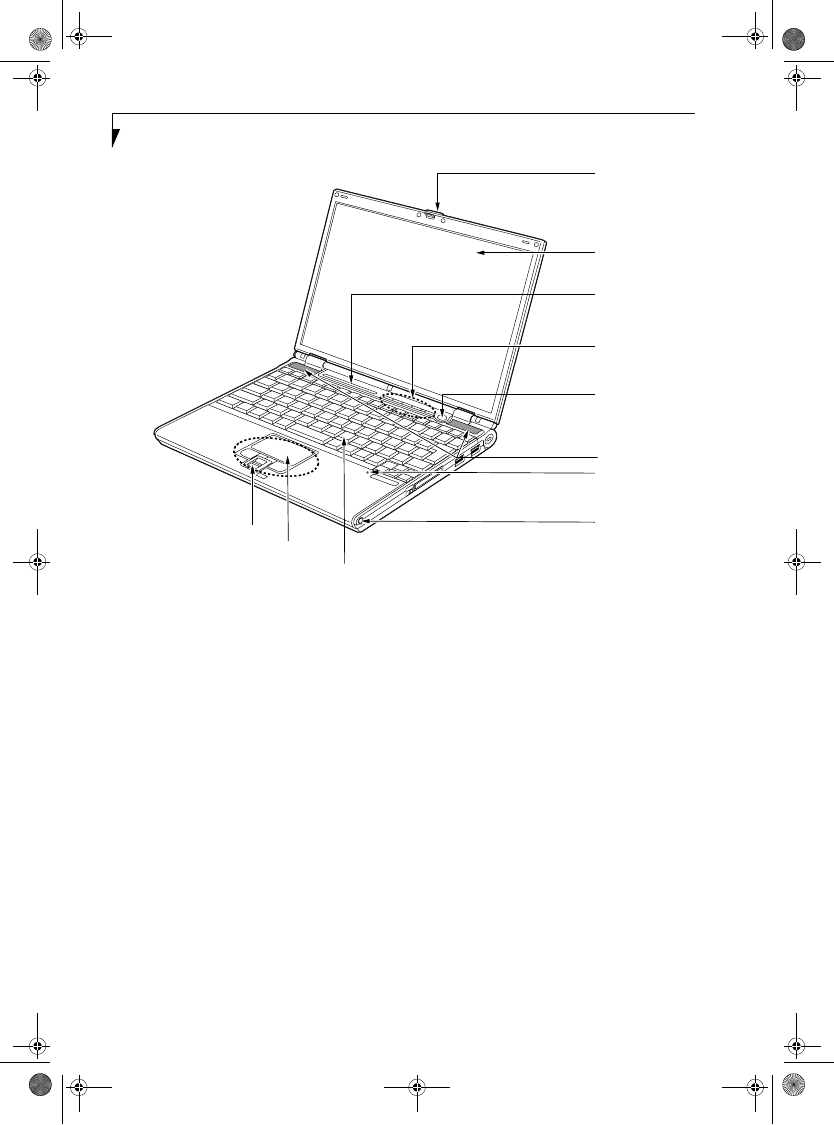
8
LifeBook B Series – Section Two
Figure 2-5. LifeBook notebook with display open
Locating the Controls
and Connectors
TOP AND FRONT COMPONENTS
The following is a brief description of your LifeBook
notebook’s top and front components.
Display Panel Latch
The display panel latch locks and releases the display
panel.
Touch Screen Display Panel
The display panel is a color LCD panel with back
lighting for the display of text and graphics and touch
screen functionality.
Status Indicator Panel
The Status Indicator Panel displays symbols that corre-
spond with a specific component of your LifeBook note-
book. See “Status Indicator Panel” on page 13.
LifeBook Security/Application Panel
The Security/Application Panel provides hardware secu-
rity and one-touch application launch capability. See
“LifeBook Security/ Application Panel” on page 21.
Suspend/Resume Button
The Suspend/Resume button allows you to suspend
notebook activity without powering off, resume your
notebook from standby mode, and power on your note-
book when it has been shut down from the Windows
operating system. See “Power On” on page 29.
Stereo Speakers
The built-in dual speakers allow for stereo sound.
Built-in Microphone
The built-in microphone allows you to input or record
mono audio.
Keyboard
A full-function keyboard with dedicated Windows
keys. See “Using the Keyboard” on page 15.
Touchpad Pointing Device
The Touchpad pointing device consists of two mouse-
like buttons, a scroll button, and a cursor control pad.
Note that the scroll button may be replaced by an
optional fingerprint recognition sensor, depending
upon your system configuration. The optional finger-
print recognition sensor allows you to start your system
by swiping your finger over the sensor. See “Touchpad
Pointing Device” on page 17.
Display
Status
Keyboard
LifeBook
Touchpad
Stereo
Panel Latch
Indicator
Panel
Security/
Application
Panel
Pen Garage
Suspend/
Resume
Button
Tou ch Screen
Display Panel
Scroll Button or optional
Fingerprint Recognition
Sensor (pictured)
Built-in
Microphone
Pointing
Device
Speakers
B Series.book Page 8 Tuesday, April 26, 2005 3:08 PM
(TBD)
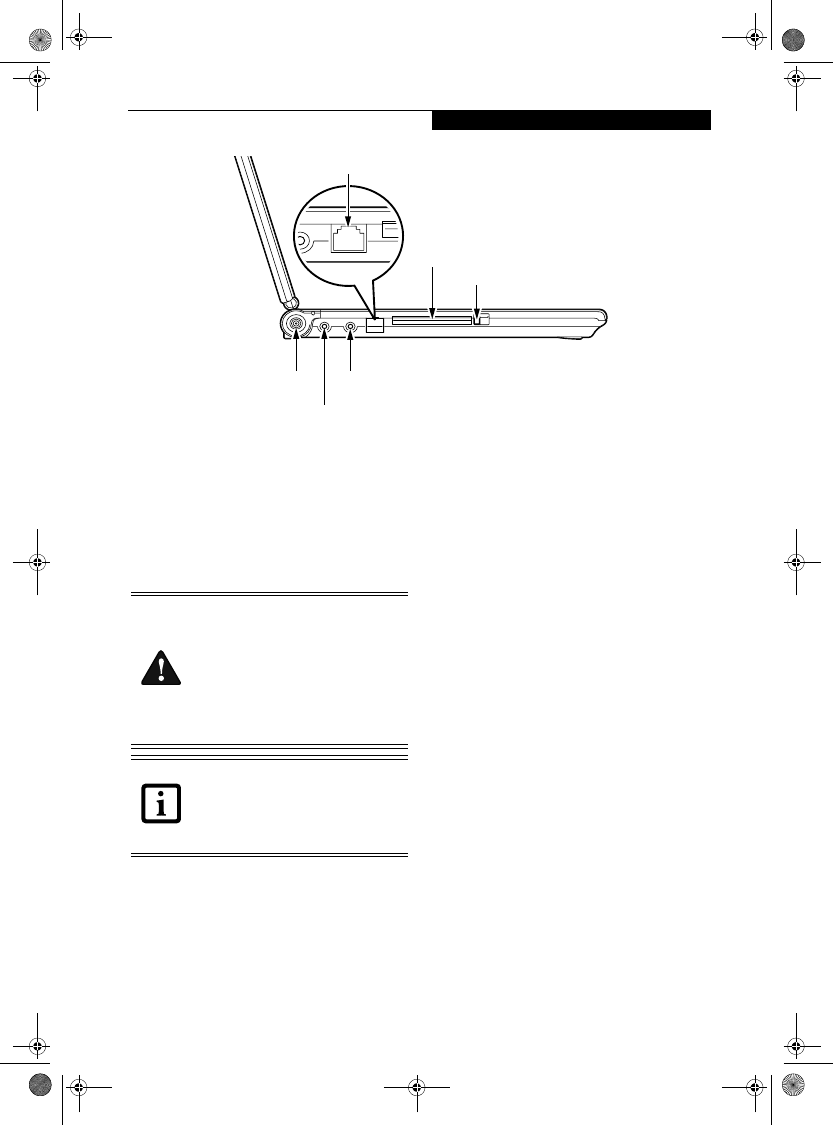
9
Getting to Know Your LifeBook
Figure 2-6. LifeBook notebook left-side panel
LEFT-SIDE PANEL COMPONENTS
Following is a brief description of your LifeBook note-
book’s left-side components.
Modem (RJ-11) Telephone Port
The Modem (RJ-11) telephone port is for attaching
a telephone line to the internal multinational 56K
modem.
PC Card Slot
The PC Card Slot allows you to install a Type I or Type II
PC Card. See “PC Cards” on page 41.
PC Card Eject Button
The PC Card eject button allows you to remove PC
Cards from the PC Card slot. See “PC Cards” on
page 41.
Microphone/Line-In Jack
The microphone/line-in jack allows you to connect an
external stereo microphone. See “Microphone/Line-In
Jack” on page 48.
Headphone/Line-Out Jack
The headphone/line-out jack allows you to connect
headphones or powered external speakers. See “Head-
phone/Line-Out Jack” on page 48.
DC Power Jack
The DC power jack allows you to plug in the AC adapter
or the optional Auto/Airline adapter to power your
notebook and charge the internal Lithium ion Battery.
PC Card Slot
PC Card Eject Button
Headphone/Line-Out Jack
Microphone/Line-In Jack
Modem Port
DC Power Jack
The internal multinational modem is not
intended for use with Digital PBX systems.
Do not connect the internal modem to a
Digital PBX as it may cause serious damage
to the internal modem or your entire
LifeBook notebook. Consult your PBX
manufacturer’s documentation for details.
Some hotels have Digital PBX systems. Be
sure to find out BEFORE you connect your
modem.
The internal modem is designed to the
ITU-T V.90 standard. Its maximum speed
of 53000bps is the highest allowed by
FCC, and its actual connection rate
depends on the line conditions. The
maximum upload speed is 33600bps.
B Series.book Page 9 Tuesday, April 26, 2005 3:08 PM
(TBD)
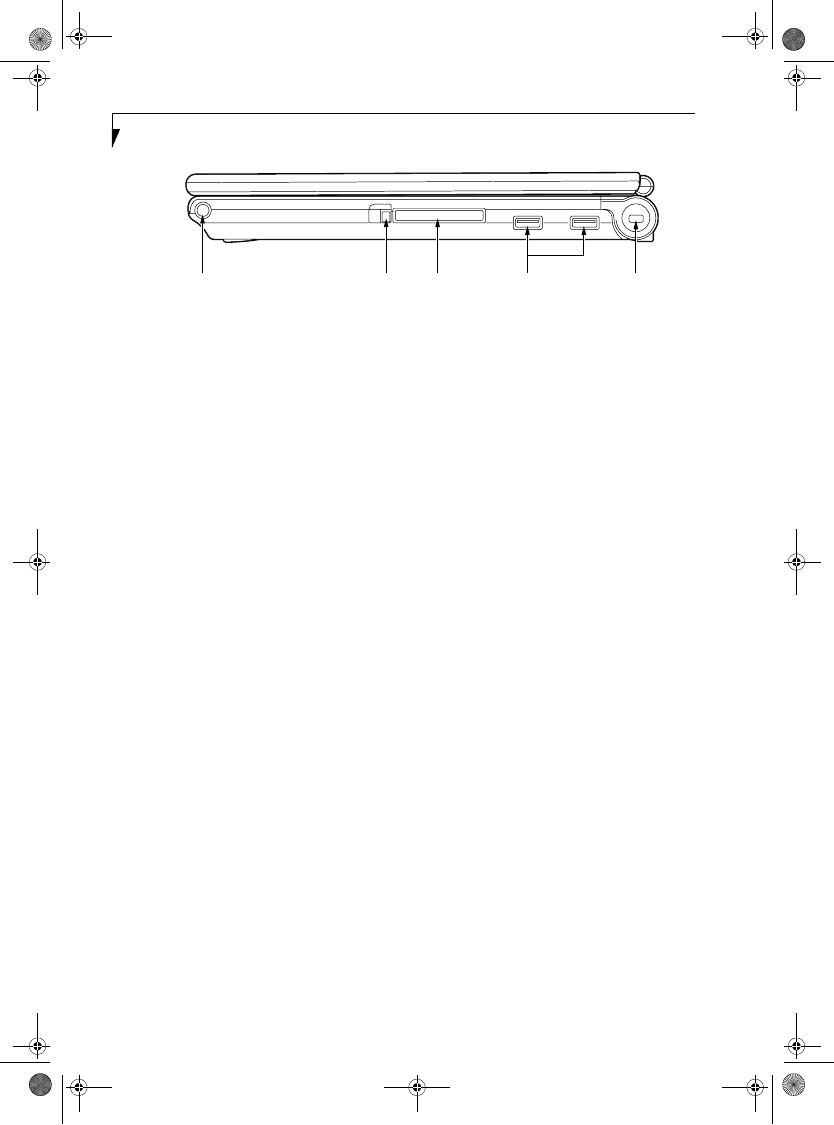
10
LifeBook B Series – Section Two
Figure 2-7. LifeBook notebook right-side panel
RIGHT-SIDE PANEL COMPONENTS
Following is a brief description of your LifeBook note-
book’s right-side components.
Stylus
The stylus is used as the pointing device for the touch
screen.
Compact Flash Card Eject Button
Allows you to eject a compact flash card.
Compact Flash Card Slot
Allows you to insert a compact flash (CF) card. See
“Compact Flash Cards” on page 42.
USB 2.0 Ports
The two Universal Serial Bus (USB) 2.0 ports allow you
to connect Universal Serial Bus devices. See “Universal
Serial Bus 2.0 Ports” on page 48.
Anti-theft Lock Slot
The anti-theft lock slot allows you to attach an optional
physical locking device.
USB 2.0 Ports
Compact Flash
Compact Flash Anti-theft
Card Slot
Card Eject Button Lock Slot
Stylus
B Series.book Page 10 Tuesday, April 26, 2005 3:08 PM
(TBD)
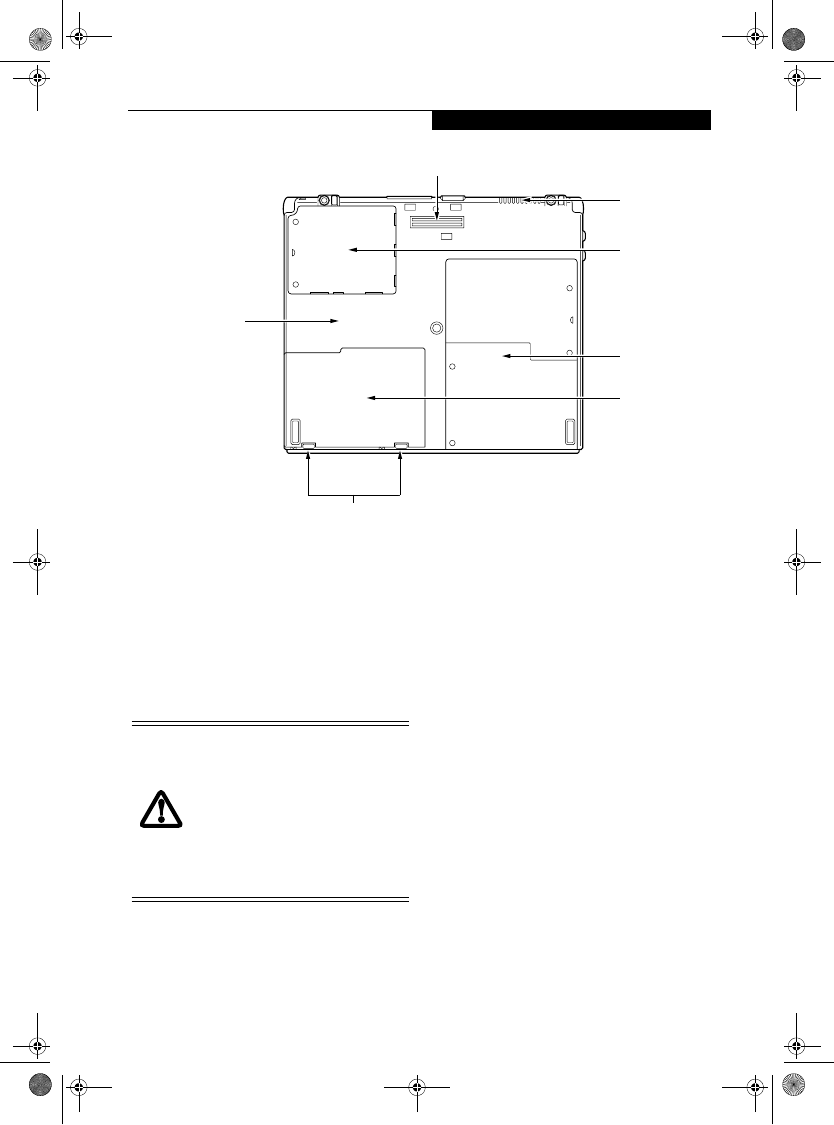
11
Getting to Know Your LifeBook
Figure 2-8. LifeBook notebook bottom panel
BOTTOM COMPONENTS
Following is a brief description of your LifeBook note-
book’s bottom panel components.
Docking Port Connector
This connector allows you to connect the optional Port
Replicator.
Air Vents
The air vents are used to cool the system to prevent over-
heating.
Memory Upgrade Compartment
Your LifeBook notebook comes with high speed
Synchronous Dynamic RAM (SDRAM). The memory
upgrade compartment allows you to expand the system
memory capacity of your notebook, hence improving
overall performance. See “Memory Upgrade Module”
on page 44.
Hard Disk Drive Cover
The hard disk drive cover protects the hard disk drive.
Under normal circumstances, you should never remove
this cover unless you are replacing a hard disk drive.
Lithium ion Battery Pack
The battery bay contains the internal Lithium ion
battery. It can be opened for the removal of the battery
when stored over a long period of time or for swapping
a discharged battery with a charged Lithium ion battery.
See “Lithium ion Battery” on page 37.
Battery Pack Latches
The battery pack latches are used to secure and release
the Lithium ion battery pack. See “Lithium ion Battery”
on page 37.
Main Unit and Configuration Label
The configuration label shows the model number and
other information about your LifeBook notebook. In
addition, the configuration portion of the label has the
serial number and manufacturer information that you
will need to give your support representative. It identi-
fies the exact version of various components of your
notebook.
Memory
Main Unit and
Lithium ion
Battery Pack Latches
Docking Port Connector
Configuration
Label
(approximate location)
Battery Pack
Upgrade
Compartment
Air Vents
Hard Disk
Drive Cover
To protect your notebook from damage
and to optimize system performance, be
sure to keep all air all vents unobstructed,
clean, and clear of debris. This may
require periodic cleaning, depending upon
the environment in which the system is
used.
Do not operate the notebook in areas
where the air vents can be obstructed,
such as in tight enclosures or on soft
surfaces like a bed or cushion.
B Series.book Page 11 Tuesday, April 26, 2005 3:08 PM
(TBD)
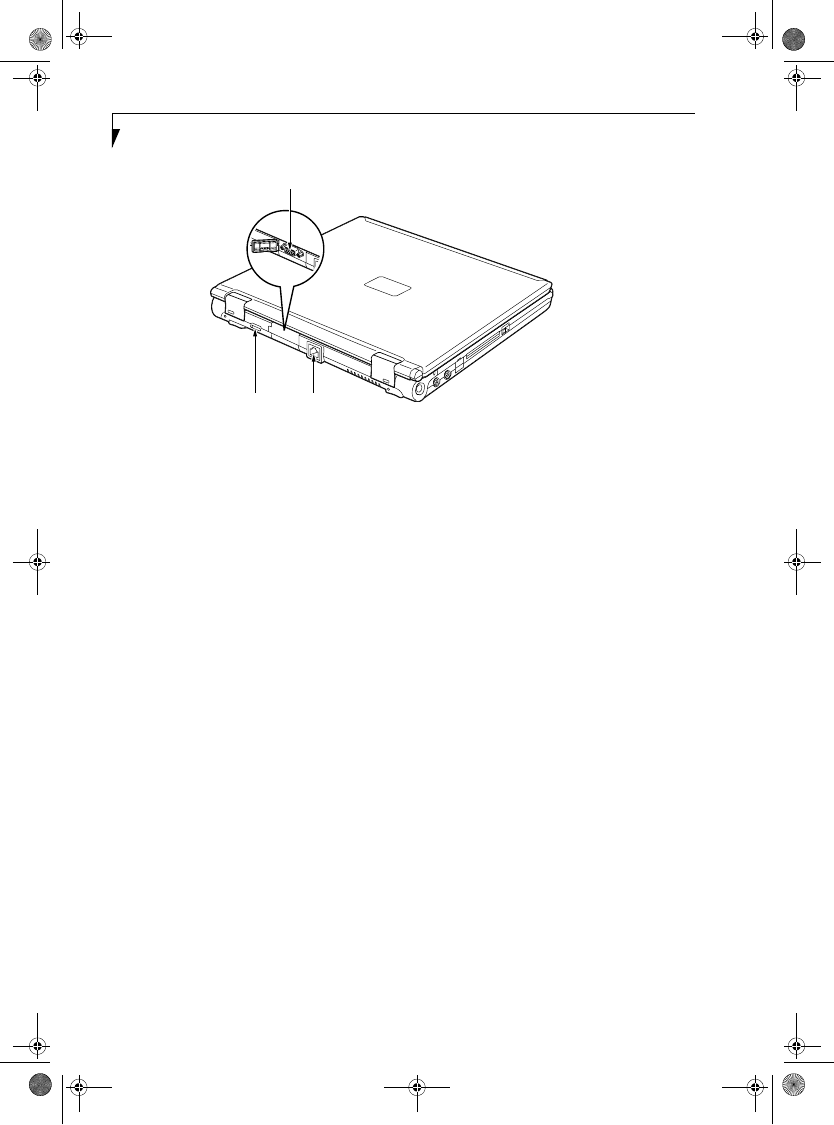
12
LifeBook B Series – Section Two
Figure 2-9. LifeBook notebook rear panel
REAR PANEL COMPONENTS
Following is a brief description of your LifeBook note-
book’s right-side components.
External Monitor Port
The external monitor port allows you to connect an
external VGA or SVGA CRT monitor. Note that when
the optional Port Replicator is attached to the system,
you must use the external monitor port on the Port
Replicator rather than the port on the system. See
“External Monitor Port” on page 49.
LAN (RJ-45) Jack
The optional internal LAN (RJ-45) port is used for an
internal Fast Ethernet (10/100/1000 Base-T/Tx) Gigabit
connection. See “Internal LAN (RJ-45) jack” on page 48.
Wireless LAN/Bluetooth On/Off Switch
Allows you to turn the optional Wireless LAN or Blue-
tooth devices on and off. This is present only on systems
with optional wireless LAN or Bluetooth device
installed.
LAN (RJ-45) Port
External Monitor Port
Wireless LAN/
Bluetooth
On/Off Switch
B Series.book Page 12 Tuesday, April 26, 2005 3:08 PM
(TBD)
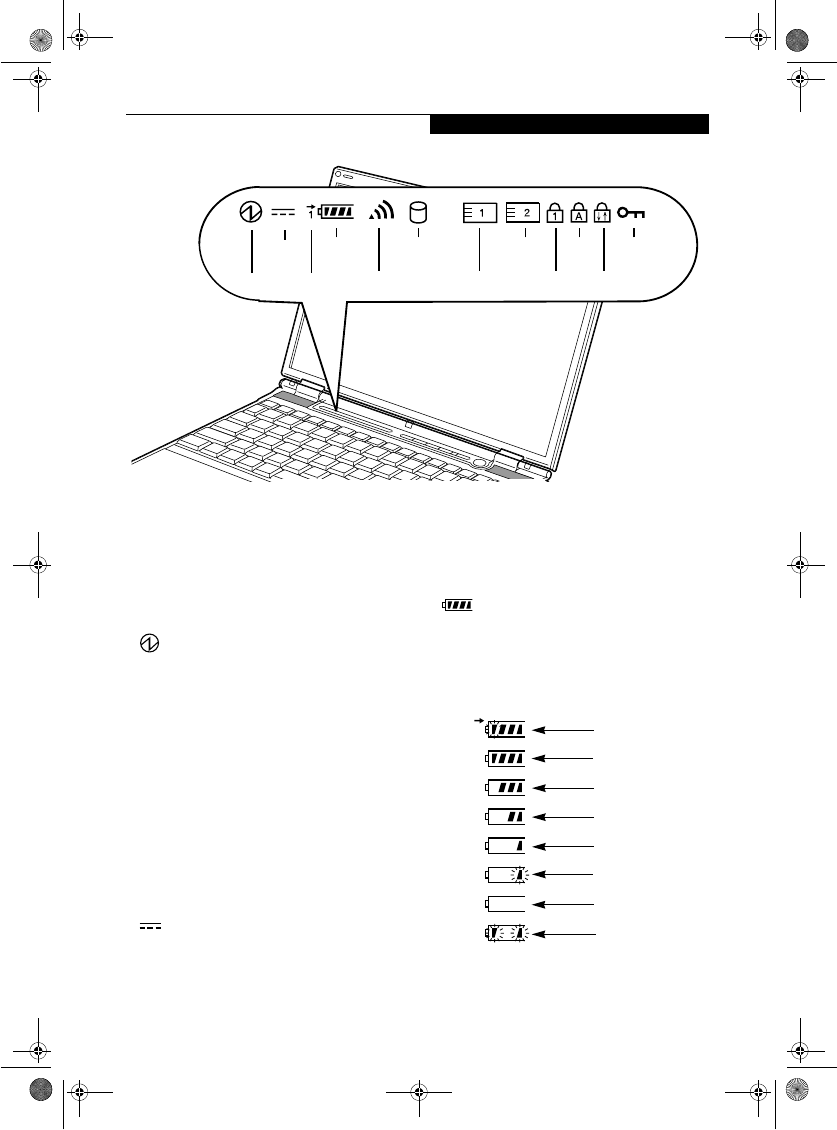
13
Getting to Know Your LifeBook
Figure 2-10. Status Indicator Panel
Status Indicator Panel
The Status Indicator displays symbols that correspond
with a specific component of your LifeBook notebook.
These symbols tell you how each of those components
are operating. (Figure 2-10)
POWER INDICATOR
The Power indicator symbol states whether your system
is operational. It has several different states, each of
which tells you what mode your notebook is in at that
time.
Steady On: This means that there is power to your
notebook and that it is ready for use.
Flashing: This means that your notebook is in Standby
mode.
Steady Off: This means that your system is either in
Hibernate mode, or that your notebook has been
turned off.
If you are charging your battery, the Power indicator
symbol will remain on even if your LifeBook notebook
is shut off. The Power indicator symbol will also remain
on if you have either adapter connected.
AC ADAPTER INDICATOR
The AC Adapter indicator states whether your notebook
is operating from the AC adapter, the Auto/Airline
adapter or the batteries. This icon has two different
states that can tell you what power source your note-
book is using.
On: This means that either of the adapters are
currently in use.
Off: Power is only coming from the batteries, and
you do not have an adapter connected.
BATTERY LEVEL INDICATORS
The Battery Level indicators state whether or not the
primary Lithium ion battery is installed. In addition,
this symbol states how much charge is available within
the installed battery. The symbol will only be displayed
for a battery that is currently installed in your notebook.
(Figure 2-11)
Figure 2-11. Battery Level Indicator
Battery Hard
PC Card Access NumLk ScrLk
SecurityCapsLk
Power
Compact Flash
AC Adapter
Battery
Charging
Level Card Access
Drive
Access
WLAN/
Bluetooth Access
76%–100% Charging
76%–100%
51%–75%
26%–50%
11%–25%
Low Warning <11%
Critical Low or
Dead Battery
Shorted Battery
B Series.book Page 13 Tuesday, April 26, 2005 3:08 PM
6$&
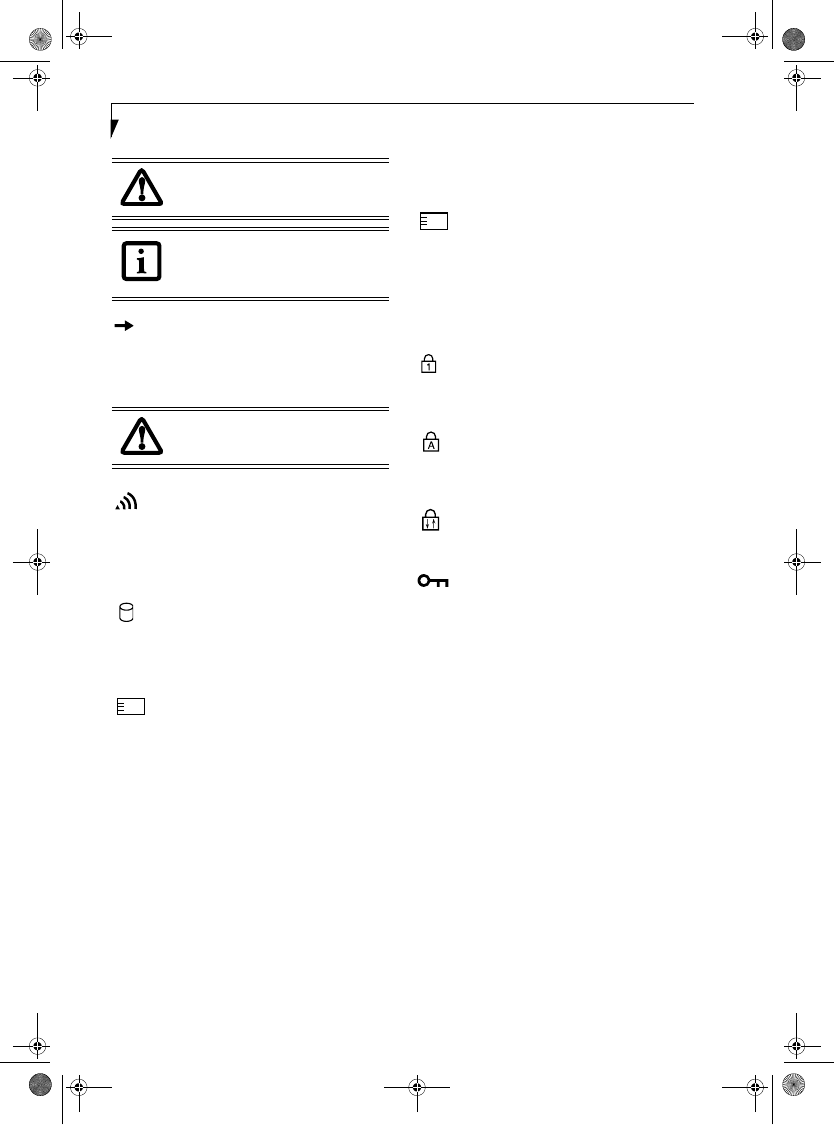
14
LifeBook B Series – Section Two
BATTERY CHARGING INDICATOR
Located to the left of the Battery Level indicator is a
small arrow symbol. This symbol states whether the
battery is charging. This indicator will flash if the battery
is too hot or cold to charge.
WIRELESS LAN/BLUETOOTH
DEVICE ACCESS INDICATOR
The Wireless LAN/Bluetooth Access indicator shows
whether the WLAN/Bluetooth switch is turned on and
the WLAN module is in active mode.
HARD DRIVE OR REMOVABLE
MEDIA DRIVE ACCESS INDICATOR
The Hard Drive Access indicator states whether your
internal hard drive is being accessed.
PC CARD ACCESS INDICATORS
The PC Card Access indicator states whether or not your
notebook is accessing a PC Card. The indicator will flash
if your software tries to access a PC Card even if there is
no card installed. See “PC Cards” on page 41.
COMPACT FLASH (CF) CARD
ACCESS INDICATORS
The Compact Flash Card Access indicator states whether
or not your notebook is accessing a Compact Flash Card.
The indicator will flash if your software tries to access a
Compact Flash Card even if there is no card installed. See
“Compact Flash Cards” on page 42.
NUMLK INDICATOR
The NumLk indicator states that the integral keyboard is
set in ten-key numeric keypad mode.
CAPSLOCK INDICATOR
The CapsLock indicator states that your keyboard is set
to type in all capital letters.
SCRLK INDICATOR
The ScrLk indicator states that your scroll lock is active.
SECURITY INDICATOR
The Security Indicator flashes (if a password was set)
when the system resumes from Off or Standby modes.
You must enter the password that was set in the Security
Panel before your system will resume operation.
A shorted battery is damaged and must be
replaced. (Figure 2-11)
If there is no battery activity, the power
adapters are not connected, and the
power is Off, the Battery Level indicators
will also be off.
Batteries subjected to shocks, vibration or
extreme temperatures can be permanently
damaged.
1
2
B Series.book Page 14 Tuesday, April 26, 2005 3:08 PM
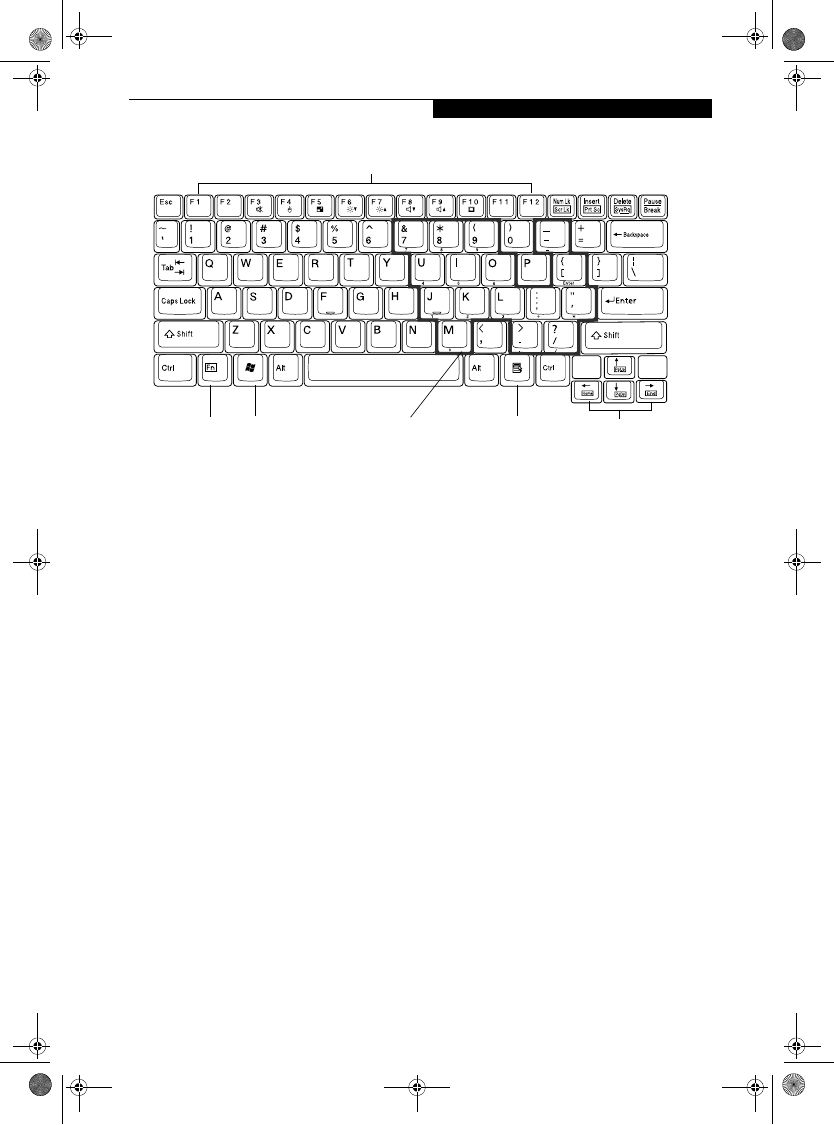
15
Getting to Know Your LifeBook
Figure 2-12. Keyboard
Keyboard
USING THE KEYBOARD
Your LifeBook notebook has an integral 82-key
keyboard. The keys perform all the standard functions of
a 101-key keyboard, including the Windows keys and
other special function keys. This section describes the
following keys. (Figure 2-12)
■Numeric keypad: Your notebook allows certain keys to
serve dual purposes, both as standard characters and
as numeric and mathematical keys. The ability to tog-
gle between the standard character and numerical keys
is controlled through the [NumLk] key.
■Cursor keys: Your keyboard contains four arrow
keys for moving the cursor or insertion point to the
right, left, up, or down within windows, applications
and documents.
■Function keys: The keys labeled [F1] through [F12],
are used in conjunction with the [Fn] key to produce
special actions that vary depending on what program
is running.
■Windows keys: These keys work with your Windows
operating system and function the same as the
onscreen Start menu button, or the right button on
your pointing device.
NUMERIC KEYPAD
Certain keys on the keyboard perform dual functions as
both standard character keys and numeric keypad keys.
NumLk can be activated by pressing the [NumLk] key.
Turning off the NumLk feature is done the same way.
Once this feature is activated you can enter numerals 0
through 9, perform addition ( + ), subtraction ( - ),
multiplication ( * ), or division ( / ), and enter decimal
points ( . ) using the keys designated as ten-key function
keys. The keys in the numeric keypad are marked on the
front edge of the key to indicate their secondary func-
tions. (Figure 2-12)
WINDOWS KEYS
Your LifeBook notebook has two Windows keys: a Start
key and an Application key. The Start key displays the
Start menu. This button functions the same as your
onscreen Start menu button. The Application key func-
tions the same as your right mouse button and displays
shortcut menus for the selected item. (Please refer to
your Windows documentation for additional informa-
tion regarding the Windows keys.) (Figure 2-12)
CURSOR KEYS
The cursor keys are the four arrow keys on the keyboard
which allow you to move the cursor up, down, left and
right in applications. In programs such as Windows
Explorer, it moves the “focus” (selects the next item up,
down, left, or right). (Figure 2-12)
FUNCTION KEYS
Your LifeBook notebook has 12 function keys, F1
through F12. The functions assigned to these keys differ
for each application. You should refer to your software
documentation to find out how these keys are used.
(Figure 2-12)
[Fn] Key
The [Fn] key provides extended functions for the
notebook and is always used in conjunction with
another key.
Fn Key
Function Keys
Numeric Keypad Application Key Cursor
Start Key
Keys(outlined in black)
B Series.book Page 15 Tuesday, April 26, 2005 3:08 PM

16
■[Fn+F3]: Pressing [F3] while holding [Fn] will toggle
the Audio Mute on and off.
■[Fn+F4]: Pressing [F4] while holding [Fn] will toggle
the touch pad on and off. Note that the [Fn+F4] com-
bination only works if Manual Setting is selected in the
BIOS.
■[Fn +F5]: Pressing [F5] while holding [Fn] allows
you to toggle between video compensation and no
compensation. (Video compensation controls spacing
on the display. When it is enabled, displays with less
than 1024 x 768 or 800 x 600 pixel resolution will still
cover the entire screen.)
■[Fn+F6]: Pressing [F6] repeatedly while holding [Fn]
will lower the brightness of your display.
■[Fn+F7]: Pressing [F7] repeatedly while holding [Fn]
will increase the brightness of the display.
■[Fn+F8]: Pressing [F8] repeatedly while holding [Fn]
will decrease the volume of your LifeBook notebook.
■[Fn+F9]: Pressing [F9] repeatedly while holding [Fn]
will increase the volume of your LifeBook notebook.
■[Fn+F10]: Pressing [F10] while holding [Fn] allows
you to change your selection of where to send your
display video. Each time you press the combination
of keys you will step to the next choice. The choices,
in order, are: built-in display panel only, both built-in
display panel and external monitor or external moni-
tor only.
B Series.book Page 16 Tuesday, April 26, 2005 3:08 PM
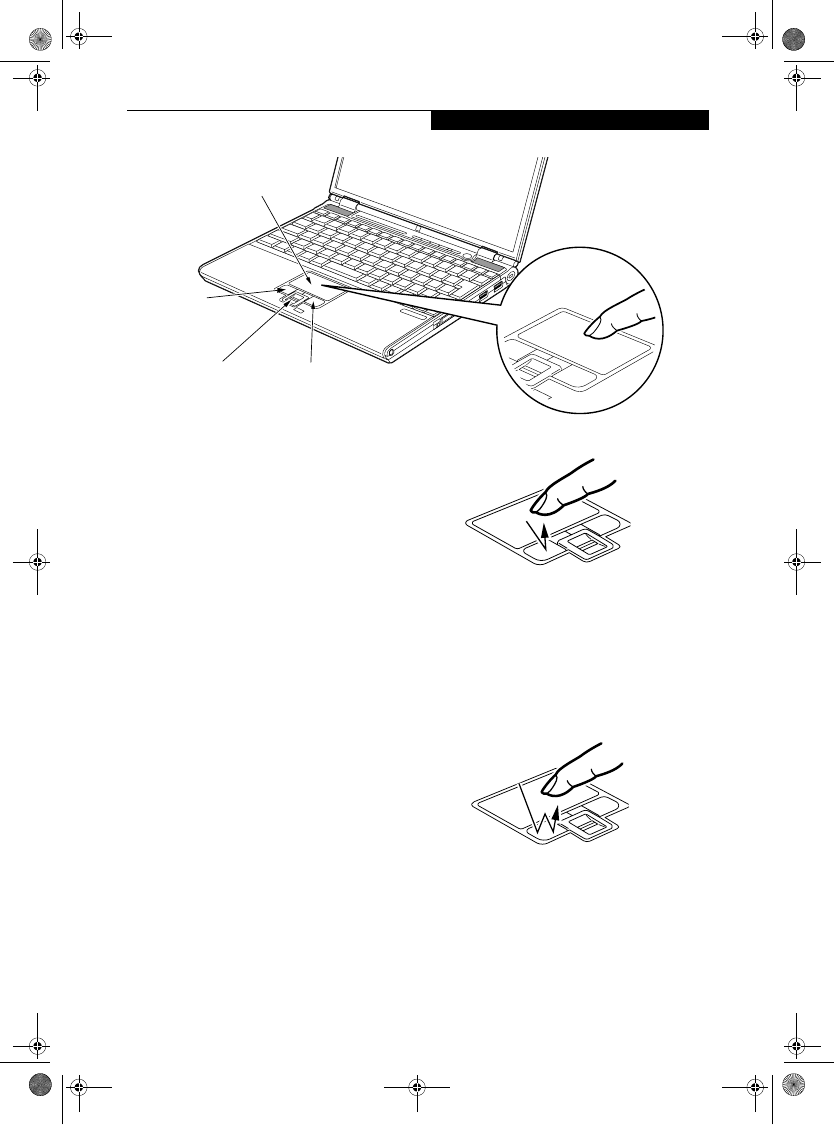
17
Getting to Know Your LifeBook
Figure 2-13. Touchpad pointing device
Touchpad Pointing Device
The Touchpad pointing device comes built into your
LifeBook notebook. It is used to control the movement
of the pointer to select items on your display panel. The
Touchpad is composed of a cursor control, a scrolling
button, and left and right buttons.
The cursor control works the same way a mouse does,
and moves the cursor around the display. It only
requires light pressure with the tip of your finger.
The scrolling button allows you to navigate quickly
through pages (Note that in some LifeBook configura-
tions, the scrolling button is replaced by a Fingerprint
Recognition Sensor.
The left and right buttons function the same as mouse
buttons. The actual functionality of the buttons may
vary depending on the application that is being used.
(Figure 2-13)
CLICKING
Clicking means pushing and releasing a button.
To left-click, move the cursor to the item you wish
to select, press the left button once, and then immedi-
ately release it. (Figure 2-14) You can also perform the
clicking operation by tapping lightly on the Touchpad
once. To right-click, move the mouse cursor to the item
you wish to select, press the right button once, and then
immediately release it.
Figure 2-14. Clicking
DOUBLE-CLICKING
Double-clicking means pushing and releasing the left
button twice in rapid succession. This procedure does
not function with the right button (Figure 2-15). To
double-click, move the cursor to the item you wish to
select, press the left button twice, and then immediately
release it. You can also perform the double-click opera-
tion by tapping lightly on the Touchpad twice.
Figure 2-15. Double-clicking
Cursor Control
Left Button
Right Button
Scrolling button or
optional Fingerprint
Recognition Sensor
(pictured)
B Series.book Page 17 Tuesday, April 26, 2005 3:08 PM
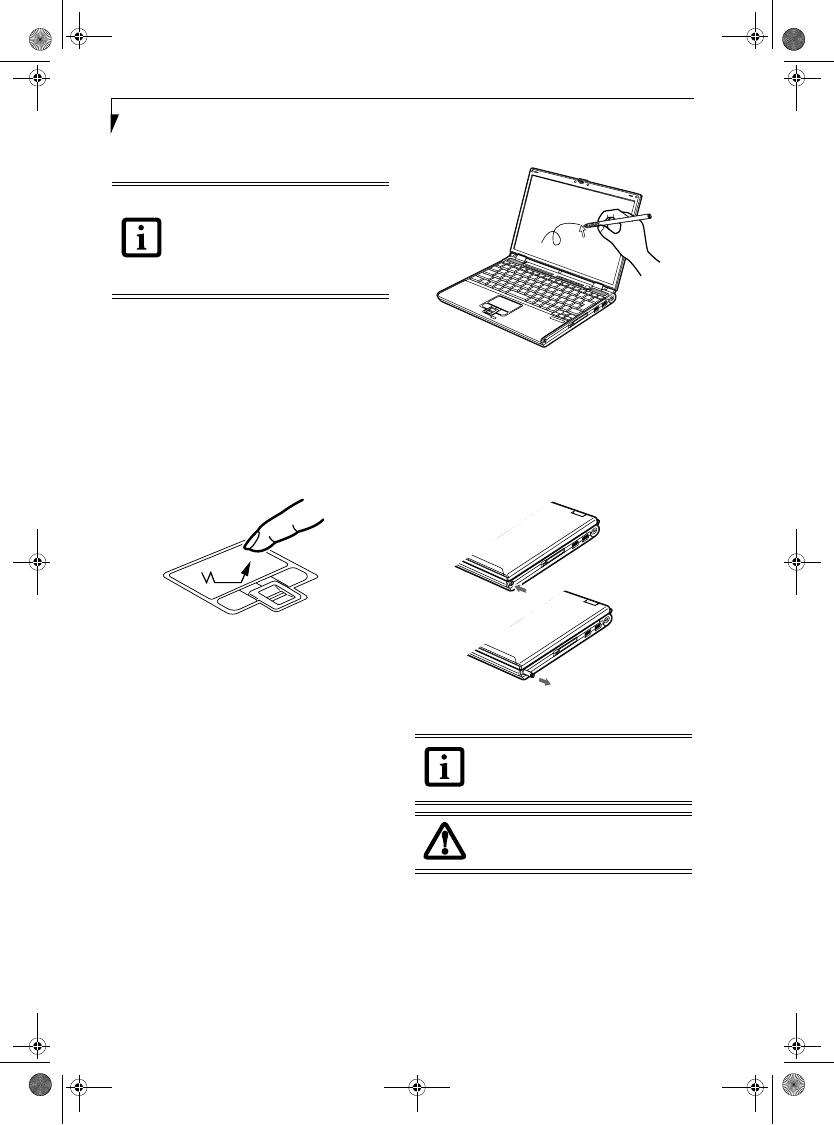
18
LifeBook B Series – Section Two
DRAGGING
Dragging means pressing and holding the left button,
while moving the cursor. To drag, move the cursor to
the item you wish to move. Press and hold the left
button while moving the item to its new location and
then release it. Dragging can also be done using the
Touchpad. First, tap the Touchpad twice over the item
you wish to move making sure to leave your finger on
the pad after the final tap. Next, move the object to its
new location by moving your finger across the
Touchpad, and then releasing your finger. (Figure 2-16)
Figure 2-16. Dragging
TOUCHPAD CONTROL ADJUSTMENT
If you need to change or adjust any of the touchpad
control functions, you can customize them from the
Mouse properties dialog box in the Control Panel. Click
on Start, select Settings > Control Panel, then double-
click Mouse.
TOUCH SCREEN
The integrated touch screen allows you to use either the
included stylus, or your fingertip, as a pointing device.
You can use the stylus to click, double-click, drag items
and icons, or to draw like a pen or pencil in applications
that support this behavior, such as drawing or painting
programs. See the documentation that came with your
application for details. (Figure 2-17)
Figure 2-17. Using the Stylus with the Touch Screen
Removing the Stylus
The stylus is located on the right side of the system,
towards the front (Figure 2-18). To remove the stylus,
press the end of it into the stylus holder; this will disen-
gage it, allowing it to pop out.
Figure 2-18. Removing the Stylus
Clicking
To left-click, touch the object you wish to select, then lift
the stylus tip immediately. You also have the option to
perform the left-click operation by tapping lightly with
your finger on the touch screen once. (Figure 2-19)
To right-click, go to Start -> Control Panel -> Touch
Panel. From that window, you can specify a right button
■If the interval between clicks is too
long, the double-click will not be
executed.
■Parameters for the Touchpad can be
adjusted from the Mouse Properties
dialog box located in the Windows
Control Panel.
To purchase additional or replacement
styluses, visit Fujitsu’s accessories web site
at: http://us.fujitsu.com/computers.
To avoid potential scratching and damage,
never use anything but the included stylus
or your finger with the touch screen.
B Series.book Page 18 Tuesday, April 26, 2005 3:08 PM
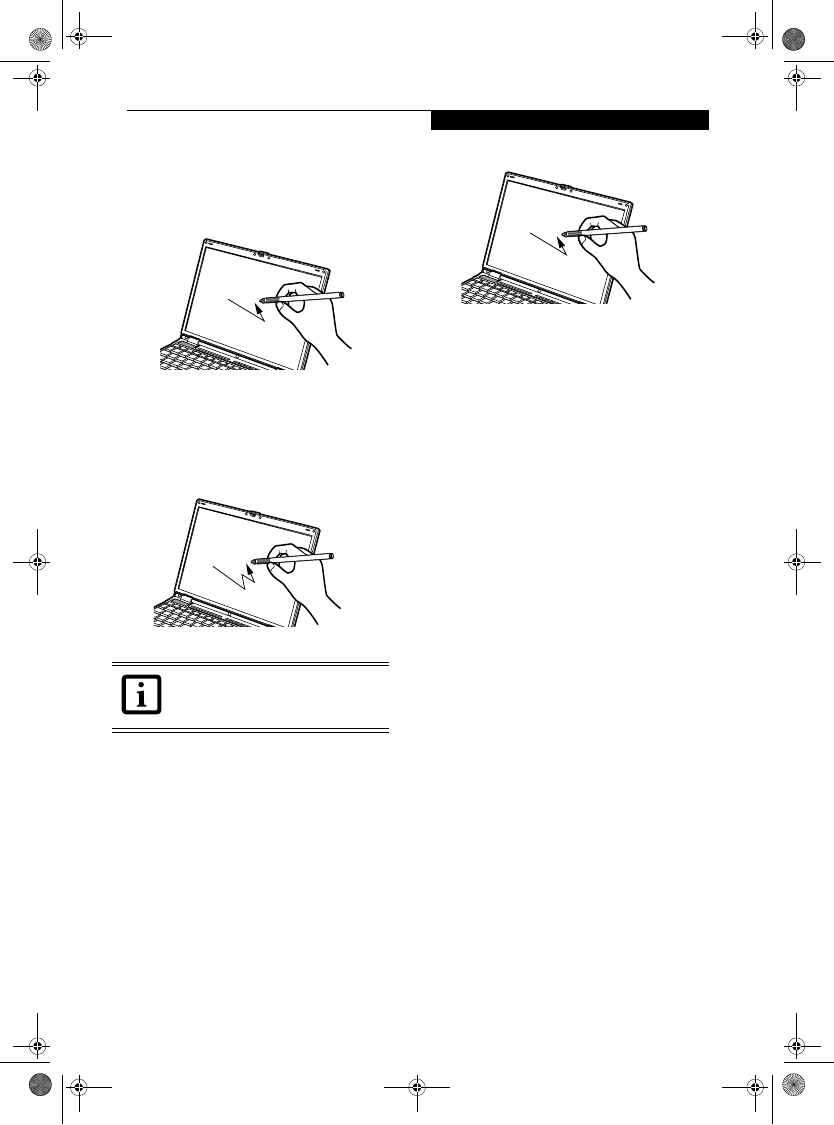
19
Getting to Know Your LifeBook
tool by using the Touch Panel Configuration Control
button prior to the desired right mouse click. It can be
used two ways: by holding down the key or by pressing
the key once.
Figure 2-19. Clicking the Touch Screen
Double-Clicking
To double-click, touch the item twice, and then immedi-
ately remove the stylus tip. You also have the option to
perform the double-click operation by tapping lightly
with your finger on the touch screen twice. (Figure 2-20)
Figure 2-20. Double-clicking the Touch Screen
Dragging
Dragging means touching the screen with the stylus,
moving and then lifting the stylus. To drag, tap the touch
screen twice with your stylus over the item you wish to
move, making sure to leave the stylus on the screen after
the final tap. Next, move the item to its new location by
moving the stylus across the screen, and then lifting the
stylus to release it. Dragging can also be done using your
fingertip. (Figure 2-21)
Figure 2-21. Dragging on the Touch Screen
Right-clicking
It is possible for you to perform right-click functions
with the stylus.
1. Click Start -> Control Panel -> Touch Panel.
2. Select the Right button simulation tab.
3. Check the "Enable the right click simulation" box.
4. Choose which key you prefer to enable the right-
click function: Ctrl Key, Shift Key, or Alt Key.
Calibrating the Touch Screen
In order to ensure accurate tracking between the stylus
and cursor, you should run the Touch Screen Calibra-
tion Utility before you use the touch screen for the first
time, or after you change the display resolution.
To run the calibration utility:
1. Go to [Start] -> Control Panel, and double-click on
the Touch Panel icon.
2. Select the Calibration tab and click the [Calibrate
Now] button.
3. Adjust the display of your notebook to a comfortable
angle and find the red (+) symbol in the upper-left
corner of the display.
4. Using the stylus, touch the screen directly on the (+)
symbol, then lift the stylus. When you lift the stylus
tip, the (+) symbol will move to the next location.
4. Repeat step 4 until you have selected a total of nine
symbols. This is the minimum number of points
necessary to calibrate your touch screen.
5. Once you have selected the nine symbols, click the
[Update] button to return to the Touch Panel
Settings screen.
If the interval between taps is too long, the
double-click will not be executed.
B Series.book Page 19 Tuesday, April 26, 2005 3:08 PM
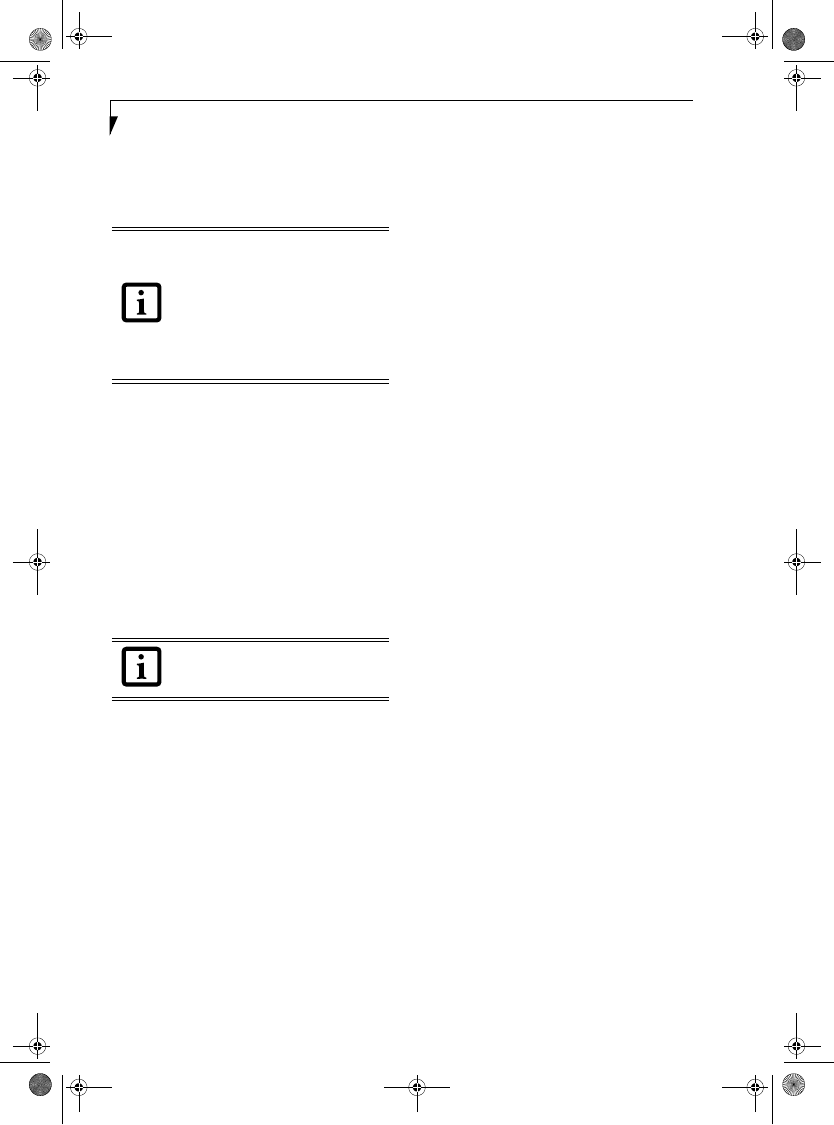
20
LifeBook B Series – Section Two
Volume Control
Your Fujitsu LifeBook notebook has multiple volume
controls which interact with each other.
CONTROLLING THE VOLUME
The volume can be controlled in several different ways:
■Volume can be set from within the Volume Control on
the Taskbar.
■Volume can be controlled from the Control Panel by
selecting the Sounds and Audio Devices icon. Select
the Volume tab and move the slider bar to the desired
volume level.
■Volume can be controlled with the F8 and F9 function
keys. Pressing [F8] repeatedly while holding [Fn] will
decrease the volume of your notebook. Pressing [F9]
repeatedly while holding [Fn] will increase the volume
of your notebook. Volume can be controlled by many
volume controls that are set within individual applica-
tions.
■Certain external audio devices you might connect to
your system may have hardware volume controls.
Each source discussed above puts an upper limit on the
volume level that must then be followed by the other
sources.
We recommend that you experiment with the various
volume controls to discover the optimal sound level.
Any software that contains audio files will
also contain a volume control of its own. If
you install an external audio device that
has an independent volume control, the
hardware volume control and the software
volume control will interact with each
other. It should be noted that if you set
your software volume to Off, you will
override the external volume control
setting.
There are twenty-six levels through which
the volume function keys cycle.
B Series.book Page 20 Tuesday, April 26, 2005 3:08 PM
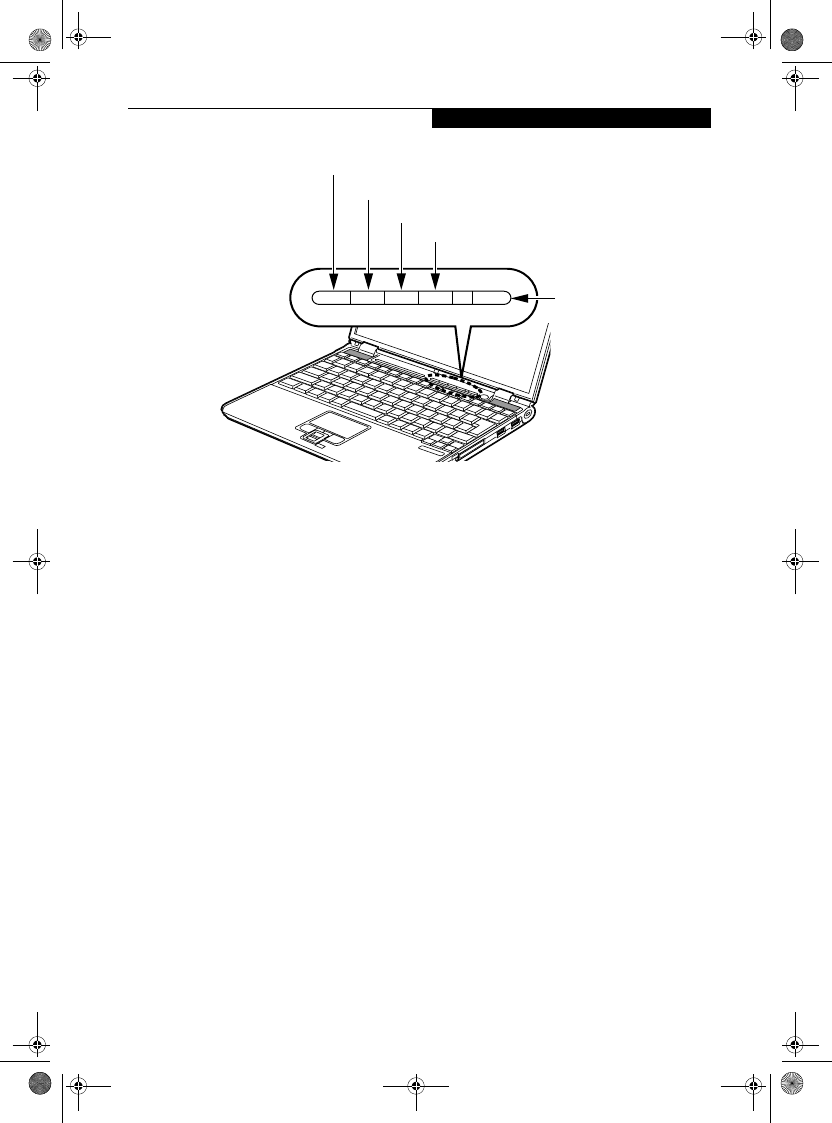
21
Getting to Know Your LifeBook
Figure 2-22. LifeBook Security/Application Panel
LifeBook Security/
Application Panel
A unique feature of your LifeBook notebook is the Secu-
rity/Application Panel that allows you to secure your
notebook from unauthorized use. The Security/Applica-
tion Panel also allows you to launch applications with the
touch of a button when your system is on.
If the security system is activated, upon starting your
notebook or resuming from Standby mode the security
system requires you to enter a password code using the
buttons on the Security/Application Panel. After entering
a correct password, your notebook resumes system
operation. (Figure 2-22)
SETTING UP YOUR LIFEBOOK SECURITY
PANEL
When you receive your LifeBook notebook, the security
panel application is pre-installed without any pass-
words. The following sections provide detailed informa-
tion on your security panel, how to set, change or
remove passwords.
Numbered Buttons
Use these buttons to enter your password.
Enter Button
After entering the button strokes, push this button to
enter the password into the LifeBook notebook.
PASSWORDS
The user and supervisor password may be set on this
notebook. A supervisor password is typically the same
for all LifeBook notebooks in a working group, office, or
company to allow for system management. Individual
LifeBook notebooks in a group environment should not
use a common password. A password consists of one to
five button strokes plus the enter button. A valid stroke
consists of pushing one or up to four buttons simulta-
neously. The following are valid button strokes:
■Pushing [4] by itself
■Pushing [2] and [3] at the same time
■Pushing [1], [2], and [4] at the same time
■Pushing [1], [2], [3], and [4] at the same time
The following are valid passwords. The numbers
within braces ({ }) are button strokes using more
than one button.
■{[2]+[3]}, [1], [enter]
■[4], [enter]
■{[1]+[3]}, {[2]+[3]+[4]}, [1], [4], [2], [enter]
Setting Passwords
When shipped from the factory, no passwords are set.
You have a choice of having no password or setting a
supervisor and user password. You must set the super-
visor password before the user password.
(1) Application A Button
(3) Internet Button
(2) Application B Button
(4) E-Mail Button
Enter Button
B Series.book Page 21 Tuesday, April 26, 2005 3:08 PM
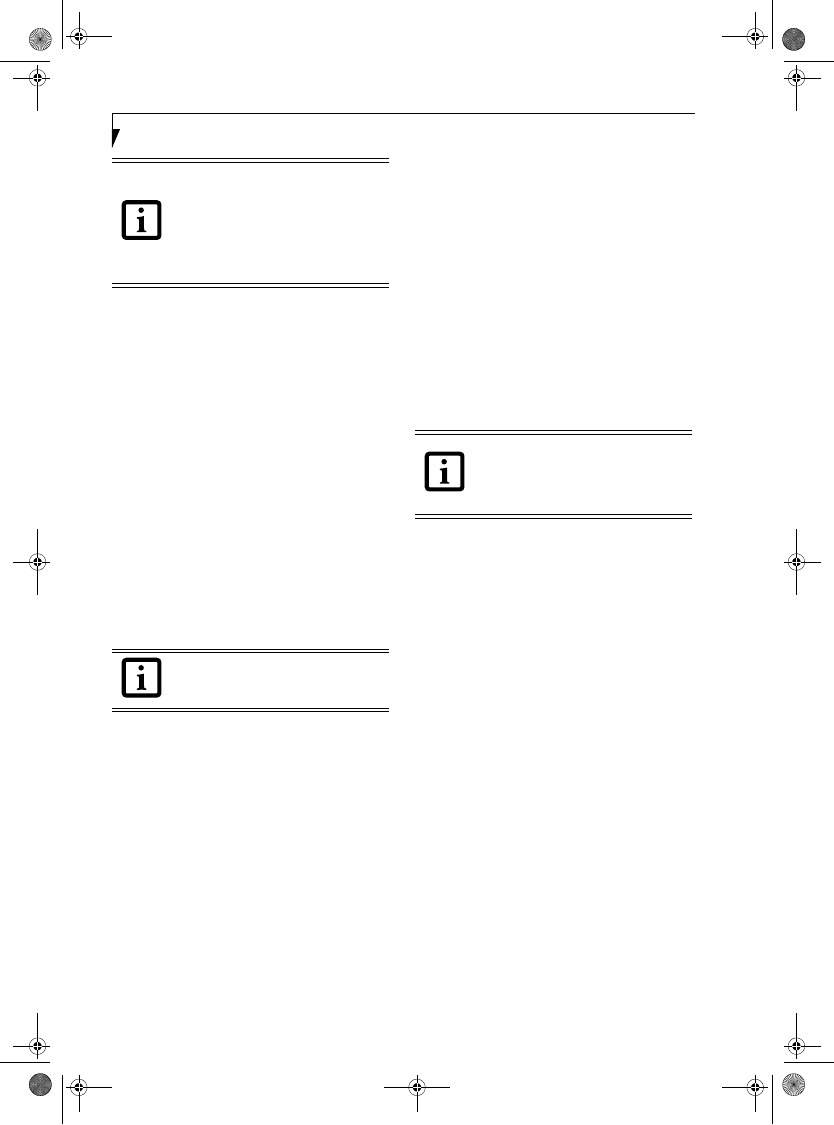
22
LifeBook B Series – Section Two
Setting Supervisor Password
You must have set a supervisor password before setting
any user passwords. The supervisor password can bypass
the user password.
1. Go to the Start menu.
2. Click on Run.
3. Type in:
C:\Program Files\Fujitsu\
Security Panel Application\
Supervisor\FJSECS.EXE,
then press [Enter]
4. Follow the on-screen instructions to set the
Supervisor password.
Setting User Password
1 Go to the Start menu.
2. Click on Programs.
3. Click on Security Panel Application and
Set User Password.
4. Follow the on-screen instructions to set the
user password.
OPERATING YOUR LIFEBOOK SECURITY/
APPLICATION PANEL
The security lock feature is in effect both when the system
resumes from Off or Standby state. You always need to
push the Suspend /Resume button to input the user pass-
word. Your system will not begin the boot sequence
without entering your supervisor/user password.
From Off State
1. Turn on your system.
2. When the Security Indicator flashes, enter the pass-
word and press Enter button.
For example, if the password is 22222,
Press Button Number 2 five times and press Enter
button.
The LifeBook notebook will boot to normal opera-
tion.
From Standby State
1. Press your Suspend/Resume button.
2. When the Security Indicator flashes, enter the pass-
word and press Enter button.
The notebook should resume normal operation.
Incorrect Password Entry
If an invalid supervisor or user password is entered three
times in succession, the system will “beep” for about one
minute. If a valid password is entered within a minute
(while system beeps), the beeping will stop and the note-
book will resume normal operation. If no or an invalid
password is entered while the system beeps, the system
will return to its previous locked state (standby or off)
and the Security Indicator will go off. To reactivate the
notebook after a password failure, you must press the
Suspend/Resume button, then enter a correct password.
PRECAUTIONS
Opening and Closing the Cover
Closing the cover automatically places the notebook into
Standby mode. Opening the cover does not automati-
cally place the notebook into normal operation. Instead,
you must enter the proper security password after
pushing the Suspend/Resume button.
Low Battery Operations
If your LifeBook notebook has low battery, pushing the
suspend/resume button only turns on the Security Indi-
cator. Your notebook does not unlock, the Security Indi-
cator turns off after one minute. To resume normal
operation, first attach a power supply to the notebook.
Then you may unlock the notebook.
UNINSTALLING THE SECURITY
PANEL APPLICATION
You have two options when uninstalling the security
panel application:
■Uninstall the security panel application software.
This will disable all security feature.
■Uninstall the security panel application with password
still active. This will not allow any changes to the
password.
Uninstalling the Security Panel
Application Software
Remove passwords when User wants no password
protection whatsoever and doesn’t want to give anybody
the utility to set a password on their computer. In this
■The purpose of supervisor password is
to be able to bypass the user password
in case the user password is forgotten.
The supervisor password alone will not
lock the system.
■You have to set both the supervisor
and user passwords for the security
panel to work.
You may change or remove the supervisor
or user password by repeating the steps
defined above.
Remember the user password you
specified on the Security Panel Application.
If you forget the password you will not be
able to use your computer. The supervisor
password can override the user password.
B Series.book Page 22 Tuesday, April 26, 2005 3:08 PM
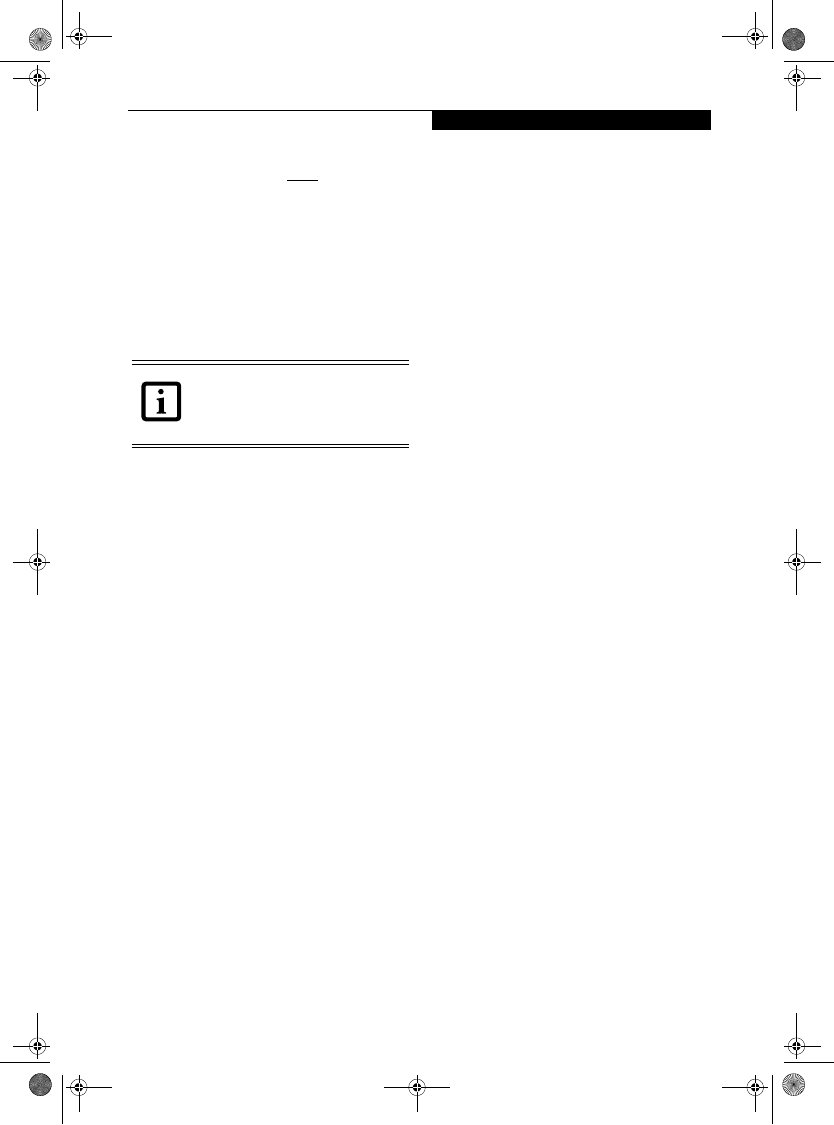
23
Getting to Know Your LifeBook
case, if passwords (supervisor, user, or both) are set, the
passwords must first be cleared before removing the
application. To clear passwords, follow same procedure
in setting the passwords, except this time, check the
“Remove Supervisor (and/or) User Password” box, as
appropriate. Click [Next]. Enter the password. When
asked to confirm that you want to remove the password,
click [OK], then click [Finish].
Removing Security Panel Application with
Passwords Still Active
Using this feature will not allow any changes to
the password.
User:
1. Go to Start Menu, Click on Control Panel.
2. Open Add/Remove Programs Properties in the
Control Panel.
3. Select the Security Panel Application in the list, and
click Add/Remove.
4. When the Confirm File Deletion box appears,
click Ye s .
Supervisor:
1. Go to Start Menu, Click on Control Panel.
2. Open Add/Remove Programs Properties in the
Control Panel.
3. Select the Security Panel Application for
Supervisor in the list, and click Add/Remove.
4. When the Confirm File Deletion box appears,
click Ye s .
Reinstalling the Security/Application Panel
To reinstall supervisor or user security application, you
will need your Drivers and Applications CD. The
Utilities\Security Application Panel folder contains two
separate folders: Supervisor and User. The setup files for
supervisor and user security applications are contained
in those folders.
1. Go to the Utilities\Security Application
Panel\Supervisor folder on the CD and double-click
the setups.exe file. The Installing Security Panel
Application window will appear. Follow the instruc-
tions on the screen.
2. Go to the Utilities\Security Application Panel\User
folder on the CD and double-click the setup.exe file.
The Installing Security Panel Application window
will appear. Follow the instructions on the screen.
Supervisor and user passwords can be set via Windows
software using the FJSECS.exe and FJSECU.exe files,
respectively. FJSECU.exe for the user password cannot
run without first setting a supervisor password. You
need to run FJSECS.exe first to set the supervisor pass-
word. Follow instructions under Setting Passwords on
page 21.
If you forget both passwords, please contact Fujitsu
Computer Systems Service and Support at 1-800-
8FUJITSU (1-800-838-5487). Fujitsu Computer Systems
Corporation charges a service fee for unlocking a pass-
word restricted LifeBook notebook. When calling please
have a valid credit card and provide proof of ownership.
You will then be given instructions on where to ship
your notebook.
LAUNCHING APPLICATIONS WITH
THE SECURITY/APPLICATION PANEL
The security panel also enables you to launch applications
with the touch of a button when your system is on.
Pressing any of the buttons will launch a user-defined
application. Your notebook is pre-installed with software
utilities that let you operate and configure your LifeBook
Security /Application Panel. These utilities are found
under the Start menu, under Programs, then under Life-
Book Application Panel. They include Application Panel
Setup, Application Panel Guide, Activate Panel and Deac-
tivate Panel.
Configuring your LifeBook Application Panel
When you start Windows, the LifeBook Application
Panel is automatically activated. An icon resembling a
finger pressing a button will appear in the system
Control Panel. When you see this icon you will know
that LifeBook Application Panel is active.
As an application launcher, the LifeBook Application
Panel is very flexible, giving you a variety of options. To
set up the Panel to best suit your needs, we have
provided the Application Panel Setup utility that quickly
and easily helps you make the most of this valuable
feature.
To configure your LifeBook Application Panel with
Application Panel Setup:
1. Click on [Start].
2. Click on Control Panel.
3. Double-click on the Application Panel icon.
The Application Panel setup utility will appear. There
are tabs that correspond to the application buttons on
the LifeBook Application Panel. When you receive your
notebook, these buttons are pre-configured to launch
specific programs, as referenced in Chapter 7 of this
document.
Removing the applications does not
remove the password. It simply removes
the utility to change/add/remove
passwords. To change your password you
must reinstall the application.
B Series.book Page 23 Tuesday, April 26, 2005 3:08 PM
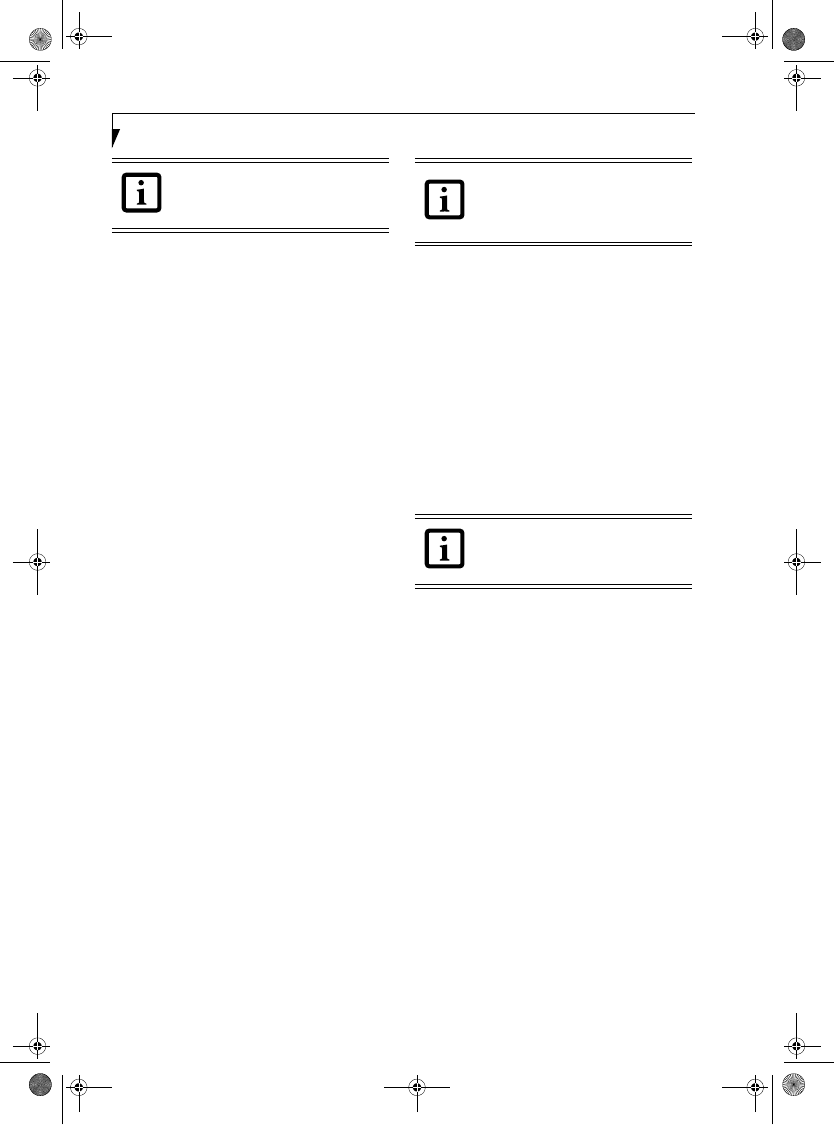
24
LifeBook B Series – Section Two
To change an application associated with the Application
buttons, click on the tab for the button you would like to
reconfigure – for example, Application A. Click on
[Browse] or [Go to Start Menu...], scroll down the list of
applications, click on the application you wish to launch
with this button, and then click OK. The button will
now launch the new application.
The Internet tab is different. It comes set to launch your
Windows default Internet browser (Internet Explorer),
unless you have changed this in Windows. In order to
reconfigure it to launch another program follow these
easy steps:
1. Select “Start Other Program” from the “Specify the
button action:” box.
2. Click on [Browse] or [Go to Start Menu...].
3. Scroll down the list of applications, and then click
on the application you wish to launch with this
button.
4. Click [OK].
The button will now launch the new application. If you
want to return to launching your Windows default
Internet browser with this button, you need only click
on “Default Internet Browser” from the Internet browser
box. Be aware that you will erase the settings for the
“other application”. If you wish to go back to launching
the “other application” from this button, you will need
to reconfigure it as described above.
When you have finished with Application Panel Setup
click OK, and the new settings will take effect. You can
reconfigure your LifeBook Application Panel as often as
you like.
Deactivating and Activating the LifeBook
Application Panel
To deactivate the LifeBook Application Panel, follow
these easy steps:
1. Click on [Start].
2. Click on Programs.
3. Click on LifeBook Application Panel.
4. Click on Stop Application Panel.
To reactivate, follow the same procedure, except for
step 4. Click on Restart Application Panel instead.
The tabs in Application Panel Setup may
not be in the same order as the buttons on
your LifeBook notebook, please select the
tab you wish to change carefully.
If your system has dedicated one of the
application launcher buttons to be an
Internet launcher, the button can still be
configured to launch any application you
wish, not just an Internet browser.
Every time you start Windows the
LifeBook Application Panel is activated,
even if you deactivated it before you shut
down.
B Series.book Page 24 Tuesday, April 26, 2005 3:08 PM

25
3
Getting Started
B Series.book Page 25 Tuesday, April 26, 2005 3:08 PM

26
LifeBook B Series
B Series.book Page 26 Tuesday, April 26, 2005 3:08 PM
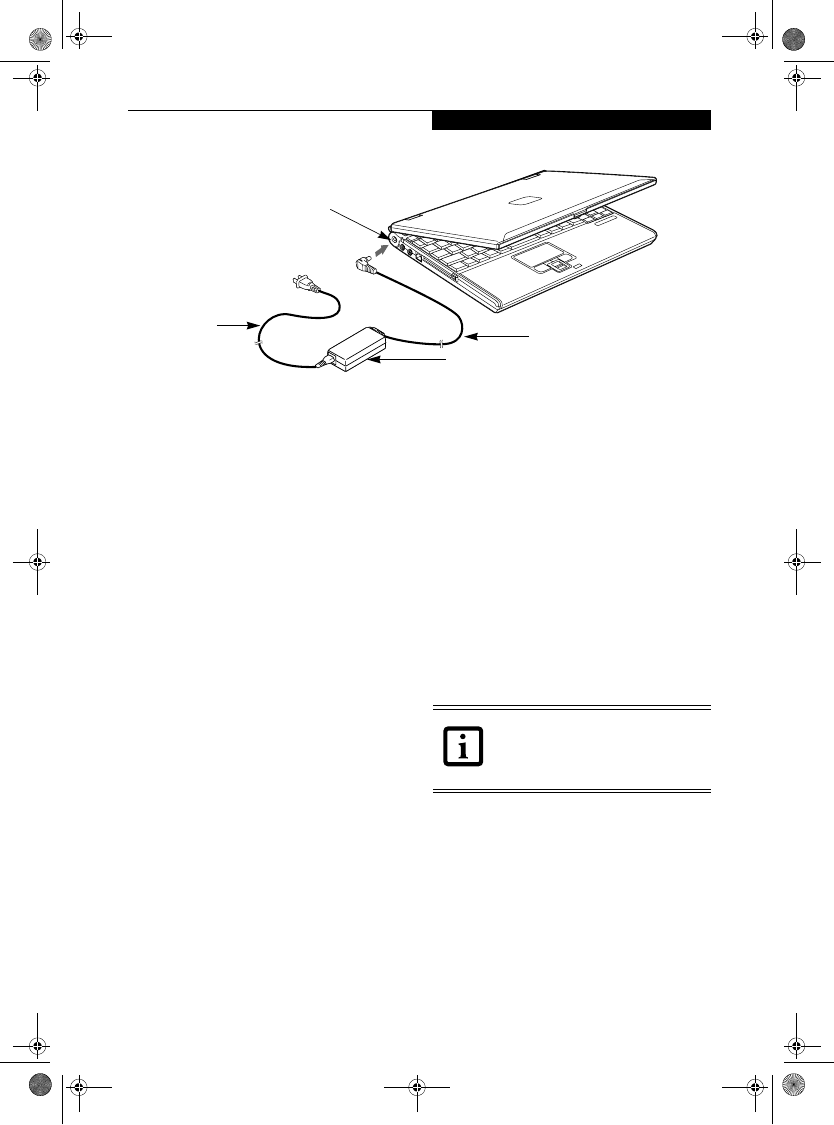
27
Getting Started
Figure 3-1. Connecting the AC Adapter
Power Sources
Your LifeBook notebook has three possible power
sources: a primary Lithium ion battery, an AC adapter
or an optional Auto/Airline adapter.
CONNECTING THE POWER ADAPTERS
The AC adapter or optional Auto/Airline adapter
provides power for operating your notebook and
charging the batteries.
Connecting the AC Adapter
1. Plug the DC output cable into the DC power jack
of your notebook.
2. Plug the AC adapter into an AC electrical outlet.
(Figure 3-1)
Connecting the Optional Auto/Airline Adapter
1. Plug the DC output cable into the DC power jack
on your notebook.
2. Plug the Auto/Airline adapter into the cigarette
lighter of an automobile with the ignition key in
the On or Accessories position.
OR
3. Plug the Auto/Airline adapter into the DC power
jack on an airplane seat.
Switching from AC Adapter Power or the
Auto/Airline Adapter to Battery Power
1. Be sure that you have at least one charged
battery installed.
2. Remove the AC adapter or the Auto/Airline adapter.
DC Power Jack
DC Output Cable
AC Adapter
AC Cable
The Lithium ion battery is not charged
upon purchase. Initially, you will need to
connect either the AC adapter or the
Auto/Airline adapter to use your
notebook.
B Series.book Page 27 Tuesday, April 26, 2005 3:08 PM
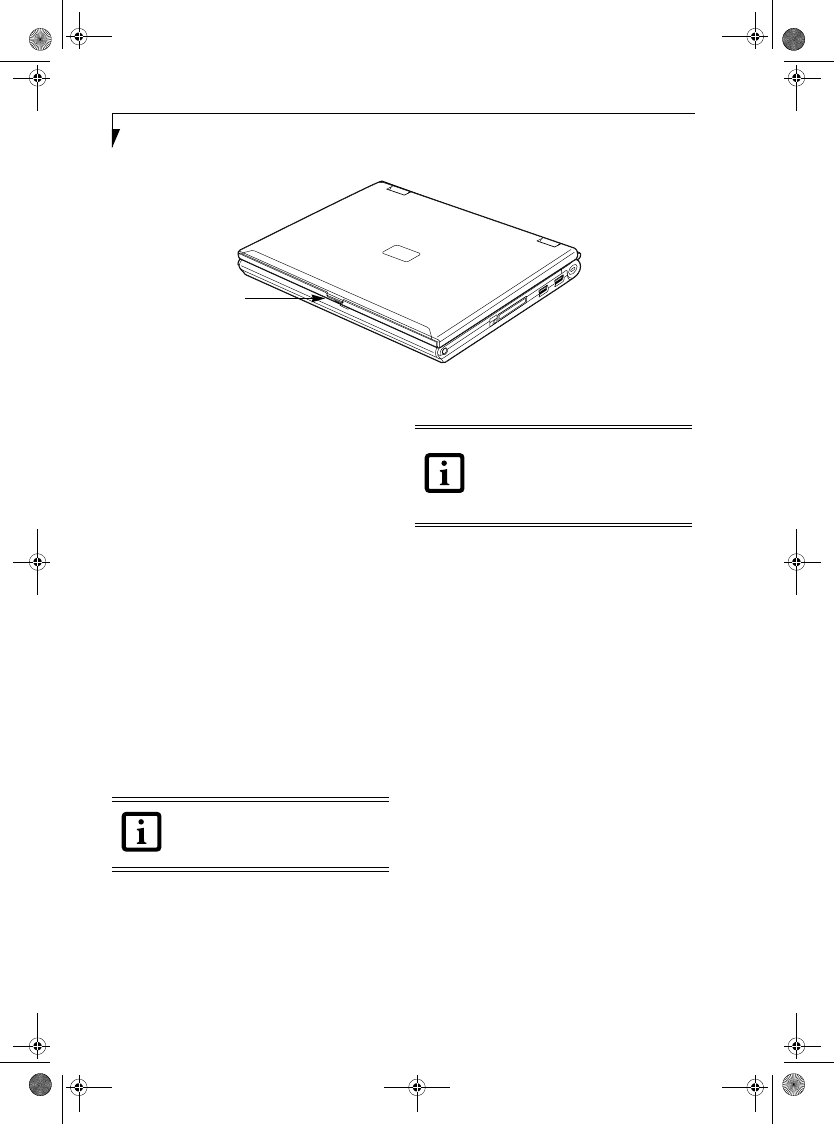
28
LifeBook B Series – Section Three
Figure 3-2. Opening the Display Panel
Display Panel
Your LifeBook notebook contains a display panel that is
backlit for easier viewing in bright environments and
maintains top resolution through the use of active-
matrix technology.
OPENING THE DISPLAY PANEL
1. Press the Display Panel latch in. This releases the
locking mechanism and raises the display slightly.
2. Lift the display backwards, being careful not to
touch the screen, until it is at a comfortable
viewing angle.
ADJUSTING DISPLAY PANEL BRIGHTNESS
Once you have turned on your notebook, you may want
to adjust the brightness level of the screen to a more
comfortable viewing level.
Adjusting the brightness using the keyboard changes the
setting only temporarily.
■[Fn+F6]: Pressing repeatedly will lower the
brightness of your display.
■[Fn+F7]: Pressing repeatedly will increase the
brightness of the display.
CLOSING THE DISPLAY PANEL
1. Holding the edge of your display panel, pull it
forward until it is flush with the body of your note-
book.
2. Push down until you hear a click. This will engage
the locking mechanism and prevent your display
panel from opening unexpectedly.
Display Panel Latch
If using AC power your brightness setting
is set to its highest level by default. If using
battery power your brightness setting is
set to approximately mid-level by default.
The higher the brightness level, the more
power the LifeBook notebook will
consume and the faster your batteries will
discharge. For maximum battery life, make
sure that the brightness is set as low as
possible.
B Series.book Page 28 Tuesday, April 26, 2005 3:08 PM
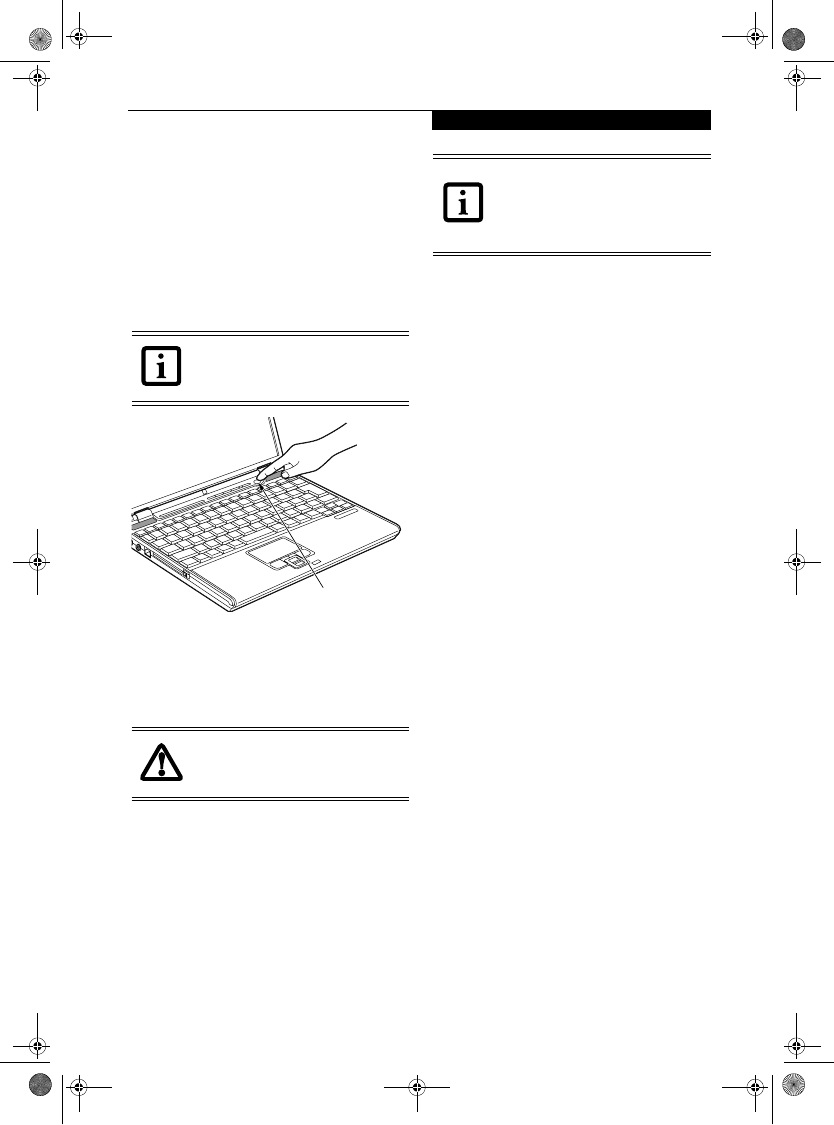
29
Getting Started
Starting Your
LifeBook Notebook
POWER ON
Suspend/Resume On button
The Suspend/Resume button is used to turn on your
LifeBook notebook from its off state. Once you have
connected your AC adapter or charged the internal
Lithium ion battery, you can power on your notebook.
Figure 3-3. Pressing the Suspend/Resume Button
Press the Suspend/Resume button (Figure 3-3). When
you are done working you can either leave your Life-
Book notebook in Suspend mode (See “Suspend/Resume
Button” on page 32.), or you can turn it off (See “Power
Off” on page 34.)
When you turn on your LifeBook notebook, it will
perform a Power On Self Test (POST) to check the
internal parts and configuration for correct functionality.
If a fault is found, your LifeBook notebook will emit an
audio warning and/or an error message will be displayed.
See “Power On Self Test Messages” on page 84.
Depending on the nature of the problem, you may be able
to continue by starting the operating system or by
entering the BIOS setup utility and revising the settings.
After satisfactory completion of the Power On Self Test
(POST), your notebook will load your operating system.
BOOT SEQUENCE
The procedure for starting-up your notebook is termed
the Bootup sequence and involves your LifeBook note-
book’s BIOS. When your notebook is first turned on, the
main system memory is empty, and it needs to find
instructions to start up your notebook. This informa-
tion is in the BIOS program. Each time you power up or
restart your notebook, it goes through a boot sequence
which displays a Fujitsu logo until your operating
system is loaded. During booting, your notebook is
performing a standard boot sequence including a Power
On Self Test (POST). When the boot sequence is
completed without a failure and without a request for
the BIOS Setup Utility, the system displays the operating
system’s opening screen.
The boot sequence is executed when:
■You turn on the power to your notebook.
■You restart your notebook from the Windows
Shut Down dialog box.
■The software initiates a system restart. Example:
When you install a new application.
■You reset the system by pressing the three keys
[CTRL+ALT+DEL].
BIOS SETUP UTILITY
The BIOS Setup Utility is a program that sets up the
operating environment for your notebook. Your BIOS
is set at the factory for normal operating conditions,
therefore there is no need to set or change the BIOS’
environment to operate your notebook.
The BIOS Setup Utility configures:
■Device control feature parameters, such as changing
I/O addresses and boot devices.
■System Data Security feature parameters, such
as passwords.
Entering the BIOS Setup Utility
To enter the BIOS Setup Utility do the following:
1. Turn on or restart your notebook.
2. Press the [F2] key once the Fujitsu logo appears
on the screen. This will open the main menu
of the BIOS Setup Utility with the current
settings displayed.
3. Press the [RIGHT ARROW] or [LEFT ARROW] key
to scroll through the other setup menus to review or
alter the current settings.
When you turn on your LifeBook note-
book be sure you have a battery installed
and charged, or that the AC or Auto/Air-
line adapter is connected and has power.
Do not carry your LifeBook notebook
around with the power on or subject it to
shocks or vibration, as you risk damaging
your notebook.
Suspend/Resume Button
Never turn off your LifeBook notebook
during the Power On Self Test (POST) or it
will cause an error message to be displayed
the next time you turn on your LifeBook
notebook. See “Power On Self Test Mes-
sages” on page 61.
B Series.book Page 29 Tuesday, April 26, 2005 3:08 PM
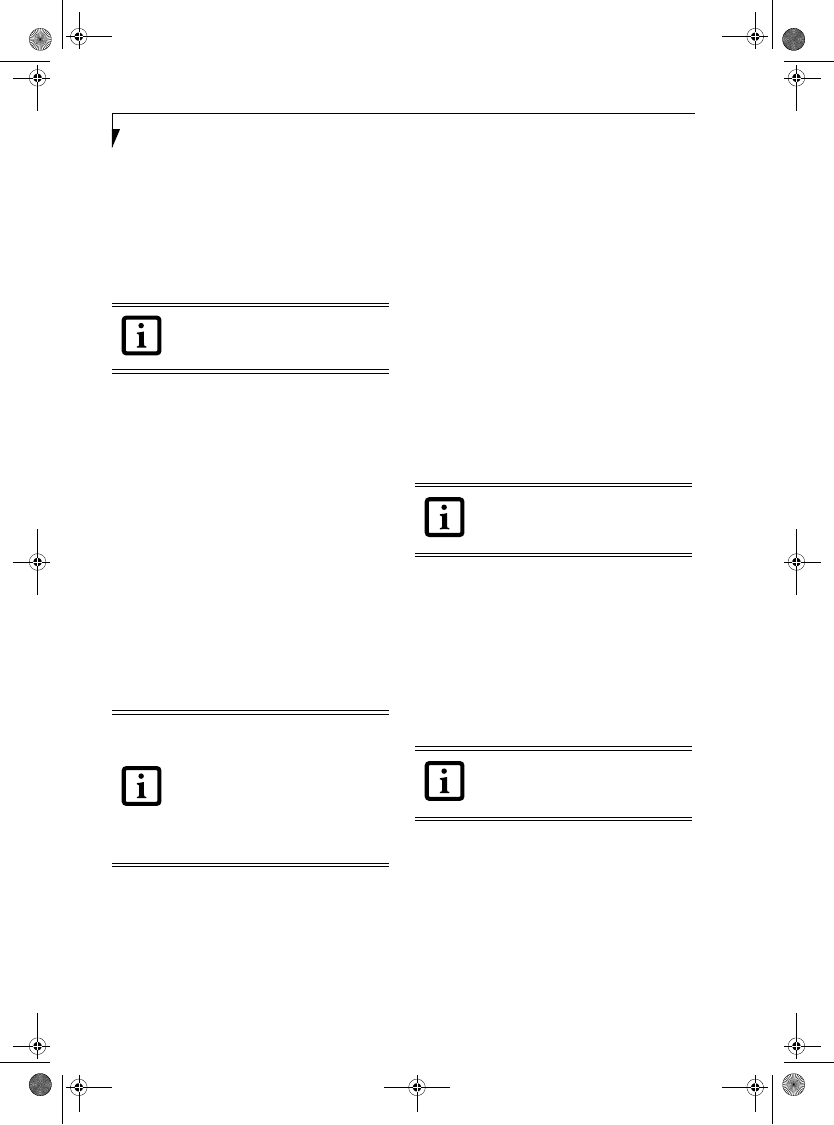
30
LifeBook B Series – Section Three
BIOS Guide
A guide to your notebook’s BIOS is available online.
Please visit our service and support Web site at
http://www.computers.us.fujitsu.com/support. Once
there, select User’s Guides under Notebook/Tablet PC
Support. Select your system model and click [Go]. Select
the BIOS Guide from the menu for your LifeBook series.
If you are unsure of your notebook’s BIOS number, refer
to your packing slip.
BOOTING THE SYSTEM
We strongly recommend that you not attach any external
devices until you have gone through the initial power-on
sequence.
When you turn on your LifeBook notebook for the first
time, it will display a Fujitsu logo on the screen. If you
do nothing the system will load the operating system,
and then the Windows Welcome will begin.
Designed to accommodate the needs of many users, in
many different countries, Windows needs to be config-
ured the first time you use them. Windows has three
parts:
■Getting Started: You have the opportunity to enter
custom information for your configuration file and
setup your modem so that your LifeBook notebook
will be prepared to dial out.
■Windows License Agreement and Final Settings:
You have the opportunity to review the Windows
License Agreement.
Getting Started
Read the instructions on the screens carefully and fill
in the information as directed. You will be asked for such
items as the language you wish to use, the country in
which you live, your first and last name, and about
how you dial out from where you will be using your Life-
Book notebook. For the modem settings, enter your
current location information where you will be using
your LifeBook notebook. If you are not connected to a
phone line and plan to register at a later time, you may
click the Skip button, and you will go directly to the
condition of use page.
Once you have set up your LifeBook notebook to dial
out, Windows will make a free telephone call to test the
settings. If the call is unsuccessful, you will be returned
to the phone settings page where you may try to fix
them. If you are unable to fix the settings, contact Fujitsu
Service and Support. See “Fujitsu Contact Information”
on page 3. If you would simply like to move on, and
register at a later time, you may click the Skip button,
and you will go directly to the Condition of Use page.
Registration
If your connection is successful, you will go to the
Registration Confirmation page. On this page simply
enter the requested information, and then check the box
at the bottom to register your copy of Windows with
Microsoft. Once you have finished, click the Next button
to continue.
You will then go through the Fujitsu registration process.
Follow the instructions on the screens, and enter all of
the necessary information. Be as specific as possible so
that if you need help the service and support team will
be able to serve you better.
Final Settings
The first part of your final settings is the Windows End
User License Agreement. Read the agreement carefully.
When you finish reading you must accept or reject the
terms of the agreement and then click on the Next button.
ACTIVATING ADDITIONAL UTILITIES
In Windows XP systems, the Click Me! icon is in the
Start menu. When you click the Click Me! icon, your
system will automatically build the icon tray in the
bottom right of the screen. These icons provide links to
utilities that you will frequently access.
Although the icon remains on the screen, you need
invoke it only once.
If your data security settings require it, you
may be asked for a password before the
BIOS main menu will appear.
■If you reject the terms of the license
agreement you will be asked to review
the license agreement for information
on returning Windows or to shut down
your LifeBook notebook.
■You cannot use your LifeBook notebook
until you have accepted the License
Agreement. If you stop the process your
notebook will return to the beginning of
the Windows Welcome Process.
If you do not register at this time you can
do it later simply by double-clicking on the
LifeBook Registration icon on your desk-
top and following the instructions.
If you do not register at this time you can
do it later simply by double-clicking on the
LifeBook Registration icon on your desk-
top and following the instructions.
B Series.book Page 30 Tuesday, April 26, 2005 3:08 PM
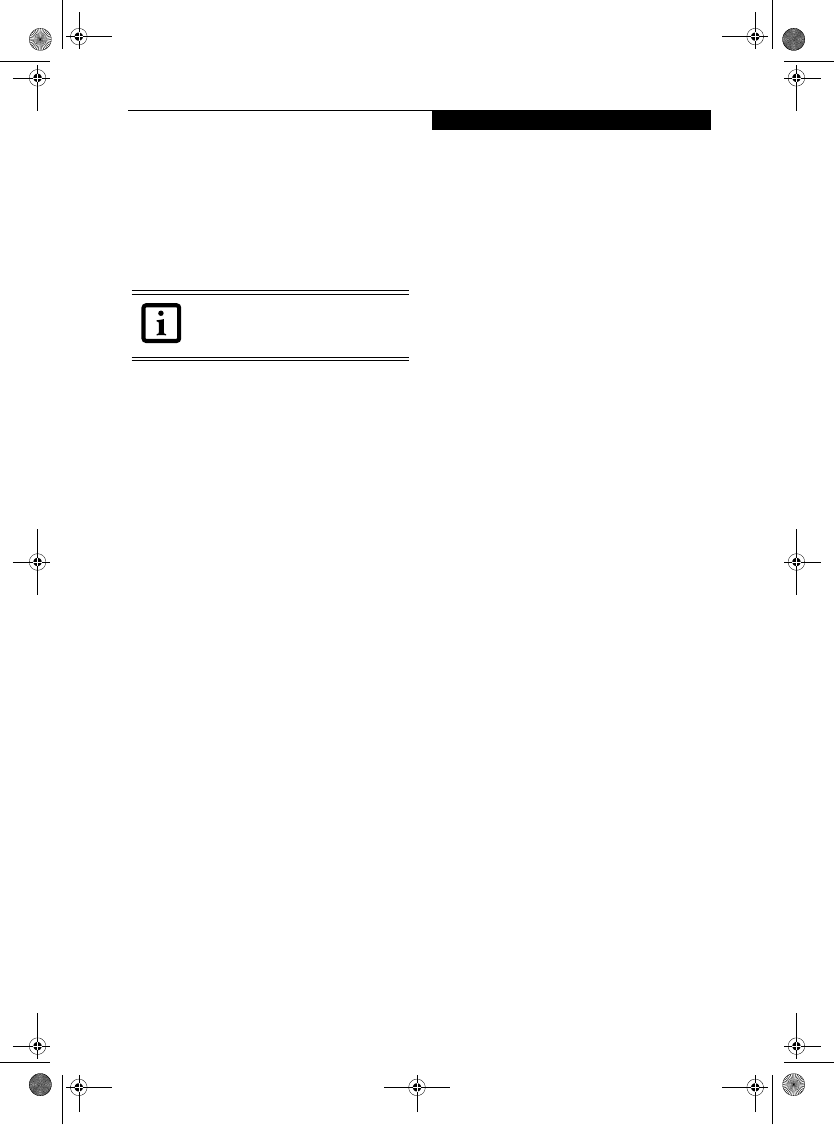
31
Getting Started
REGISTERING YOUR LIFEBOOK NOTEBOOK
How do I register?
With Windows, just follow the on-screen instructions
during the Welcome process. If you do not register
during the Welcome process you can double-click on the
LifeBook Registration icon on your desktop at any time
and follow the instructions.
You may also register on our Web site:
■http://www.computers.us.fujitsu.com/support
You will need to be set up with an Internet Service
Provider (ISP) to use this option.
Make sure you have connected a phone
line to your modem before you use E-
Registration.
B Series.book Page 31 Tuesday, April 26, 2005 3:08 PM
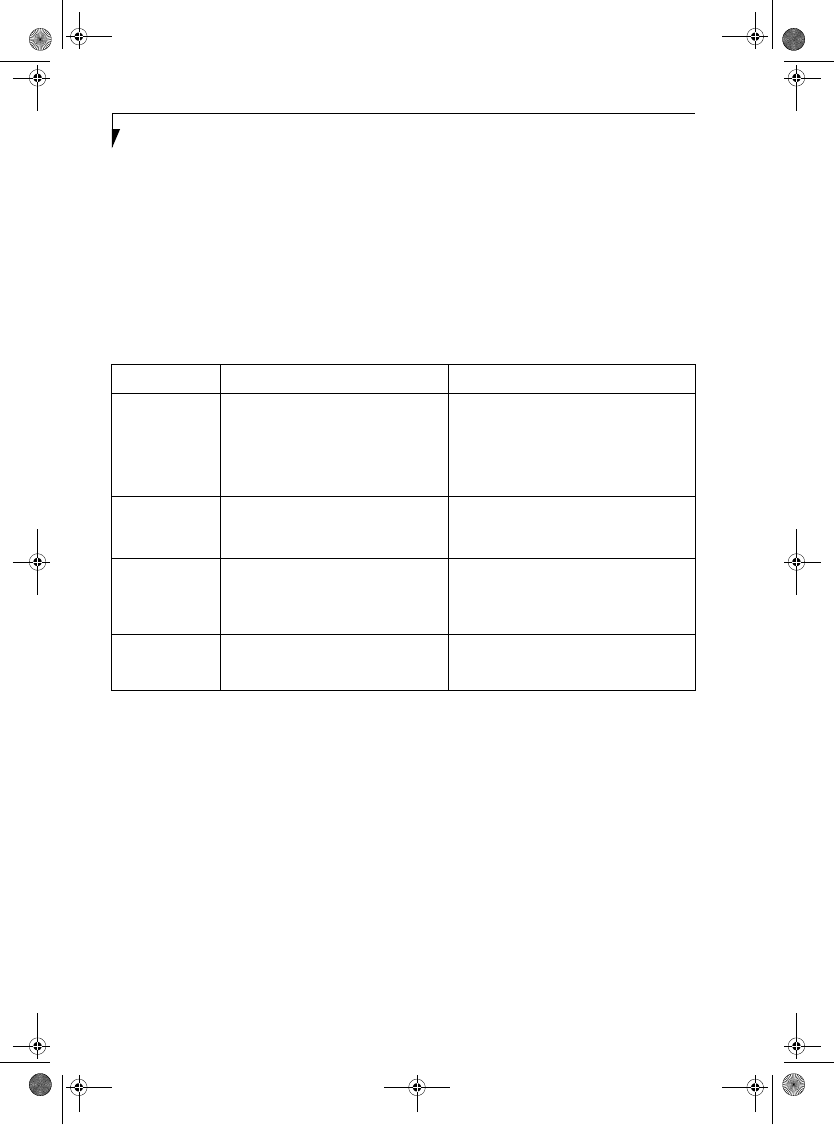
32
LifeBook B Series – Section Three
Power Management
Your LifeBook notebook has many options and features
for conserving battery power. Some of these features are
automatic and need no user intervention, such as those
for the internal modem. However, others depend on the
parameters you set to best suit your operating condi-
tions, such as those for the display brightness. Internal
power management for your notebook may be
controlled from settings made in your operating system,
pre-bundled power management application, or from
settings made in BIOS setup utility.
Besides the options available for conserving battery
power, there are also some things that you can do to
prevent your notebook battery from running down as
quickly. For example, you can create an appropriate
power saving profile, put your notebook into Standby
mode when it is not performing an operation, and you
can limit the use of high power devices. As with all
mobile, battery powered computers, there is a trade-off
between performance and power savings.
Table 3-1. System Power States
SUSPEND/RESUME BUTTON
When your LifeBook notebook is active, the Suspend/
Resume button can be used to manually put your Life-
Book into Standby mode. Push the Suspend/Resume
button when your notebook is active, but not actively
accessing anything, and immediately release the button.
You will hear two short beeps and your system will enter
Standby mode. (See figure 2-5 on page 8 for location).
If your notebook is suspended, pushing the Suspend/
Resume button will return your notebook to active oper-
ation. You can tell whether or not your system is in
Standby mode by looking at the Power indicator. See
“Power Indicator” on page 13. If the indicator is visible
and not flashing, your notebook is fully operational. If
the indicator is both visible and flashing, your notebook
is in Standby mode. If the indicator is not visible at all,
the power is off or your notebook is in Hibernate mode.
STANDBY MODE
Standby mode in Windows saves the contents of your
notebook’s system memory during periods of inactivity
by maintaining power to critical parts. This mode will
turn off the CPU, the display, the hard drive, and all of
the other internal components except those necessary to
maintain system memory and allow for restarting. Your
notebook can be put in Standby mode by:
■Pressing the Suspend/Resume button when your
system is turned on.
■Selecting Standby from Windows Shut Down menu.
■Timing out from lack of activity.
■Allowing the battery to reach the Dead Battery
Warning condition.
Your notebook’s system memory typically stores the
file(s) on which you are working, open application(s)
information, and any other data required to support the
Power Mode System Activity Events causing system to enter mode state
Fully On Mode System is running. CPU, system bus, and all
other interfaces operate at full speed.
■From Standby mode: System operation
resumed (Suspend/Resume button pressed,
resume on modem ring, resume on time).
■From Hibernation mode: Suspend/Resume
button pressed.
■From Off mode: Suspend/Resume button
pressed.
Standby Mode
(Suspend-to-RAM)
Resume system logic remains powered and
RAM remains powered to maintain active
data. All other devices are turned off.
■Standby timeout occurs.
■Suspend request issued by software or by
pressing the Suspend/Resume button.
■Low battery.
Hibernation Mode
(Suspend-to-Disk)
Windows saves desktop state (including
open files and documents) to hard disk. CPU
stops. All other devices are turned off.
■Suspend timeout occurs.
■Clicking Start -> Shut Down -> Hibernate
(It may be necessary to Enable Hibernate
Support from Windows Power Options.)
■Low battery condition
Power Off
System is fully powered off except for logic
components required for Suspend/Resume
button and real-time clock operation.
■System shutdown.
■Low battery condition
B Series.book Page 32 Tuesday, April 26, 2005 3:08 PM
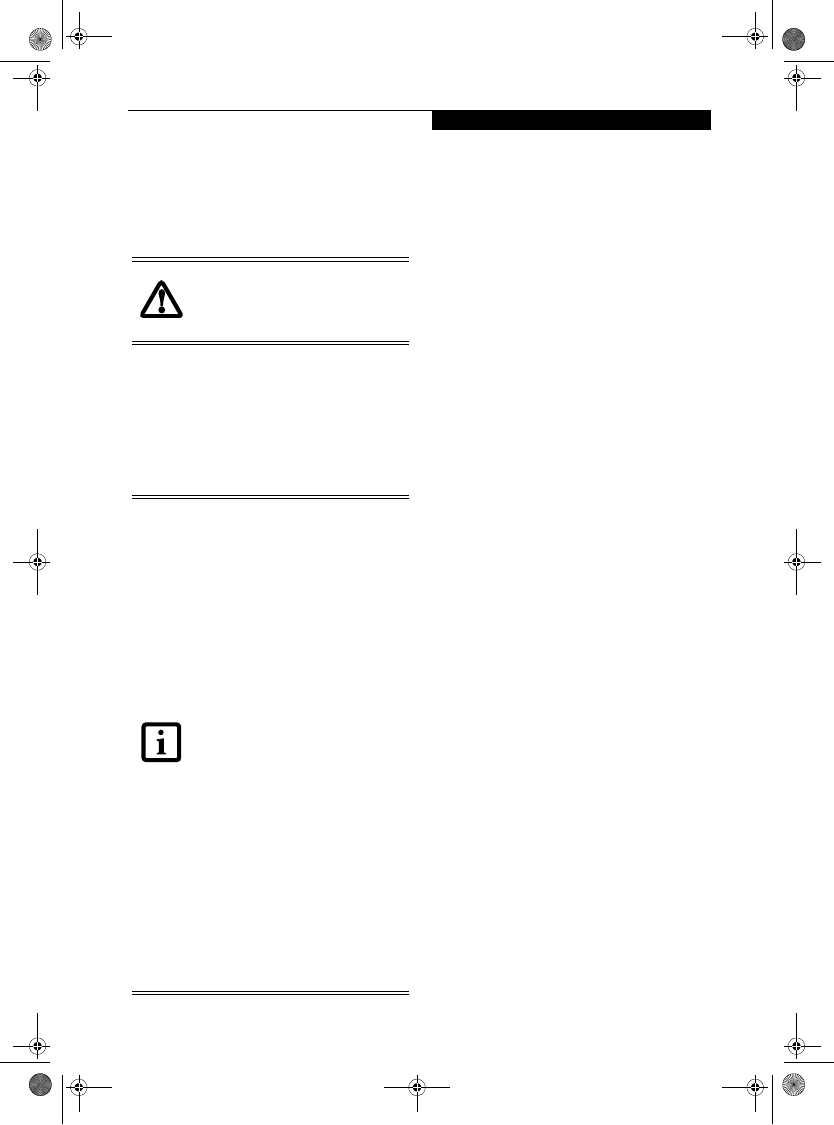
33
Getting Started
operation(s) in progress. When you resume operation
from Standby mode, your notebook will return to the
point where it left off. To resume operation, you must
use the Suspend/Resume button to resume operation,
and there must be an adequate power source available,
or your notebook will not resume.
HIBERNATE MODE
Hibernate mode saves the contents of your
notebook’s system memory to the hard drive as a part of
the Suspend/Resume mode. Your notebook is pre-
configured to perform this function. The Hibernate
mode can also be configured through the system BIOS
to run in other ways depending on what you need to
accomplish. See “BIOS Setup Utility” on page 29.
Using Hibernate Mode
To enable or disable the Hibernation feature follow these
easy steps:
1. From the Start menu, select Settings, and then select
Control Panel --> Power Options.
2. Select the Hibernate tab, and then select the box to
enable or disable this feature.
3. Click [Apply].
To use Hibernate mode:
1. Click the Ctrl-Alt-Del keys.
2. Select Shut Down from the top of the window.
3. Select Hibernate from the drop down list that
appears.
DISPLAY TIMEOUT
The display timeout is a power management feature.
This feature saves power by turning off the display if
there is no keyboard or pointer activity for the user
selected timeout period. Any keyboard or pointer
activity will cause the display to restart automatically.
This feature is independent of the Suspend/Resume
button and can be enabled and disabled in Windows
Power Management and BIOS setup utility (APM only).
See “BIOS Setup Utility” on page 29.
HARD DISK TIMEOUT
The hard disk timeout is another one of the power
management parameters. This feature saves power by
turning off the hard drive if there is no hard drive
activity for the user selected timeout period. Any
attempt to access the hard drive will cause it to restart
automatically. This feature is independent of the
Suspend/Resume button and can be enabled and
disabled in Windows and BIOS setup utility (APM
only). See “BIOS Setup Utility” on page 29.
WINDOWS POWER MANAGEMENT
The Power Management icon located in the Windows
Control Panel allows you to configure some of the power
management settings. For example, you can use the
Power Management to set the timeout values for turning
off the display and hard disks whether you are running
the notebook on battery power or one of the adapters.
The settings may also be changed in the BIOS (APM
only). See “BIOS Setup Utility” on page 29.
RESTARTING THE SYSTEM
If your system is on and you need to restart it, be sure
that you use the following procedure.
1. Click the Start button, and then click Turn Off
Computer.
2. Select the Restart option from within the Windows
Turn Off Computer dialog box.
If you are running your LifeBook notebook
on battery power, be aware that the
battery continues to discharge while your
notebook is in Standby mode, though not
as fast as when fully operational.
■The Standby or Hibernate modes should
not be used with certain PC Cards.
Check your PC Card documentation for
more information.
■Disabling the Suspend/Resume button
prevents it from being used to put your
notebook in Standby or Hibernate
mode. The resume function of the
button cannot be disabled.
■If your notebook is actively accessing
information when you enter the Standby
or Hibernate mode, changes to open
files are not lost. The files are left open
and memory is kept active during
Standby mode or the memory is trans-
ferred to the internal hard drive during
Hibernate mode.
■When PC Cards or external devices are
in use, Save-to-Disk mode cannot return
to the exact state prior to suspension,
because all of the peripheral devices will
be re-initialized when the system
restarts.
■The main advantage of using the Hiber-
nate function is that power is not
required to maintain your data. This is
particularly important if you will be leav-
ing your notebook in a suspended state
for a prolonged period of time. The
drawback of using Hibernate mode is
that it lengthens the power down and
power up sequences and resets periph-
eral devices.
B Series.book Page 33 Tuesday, April 26, 2005 3:08 PM
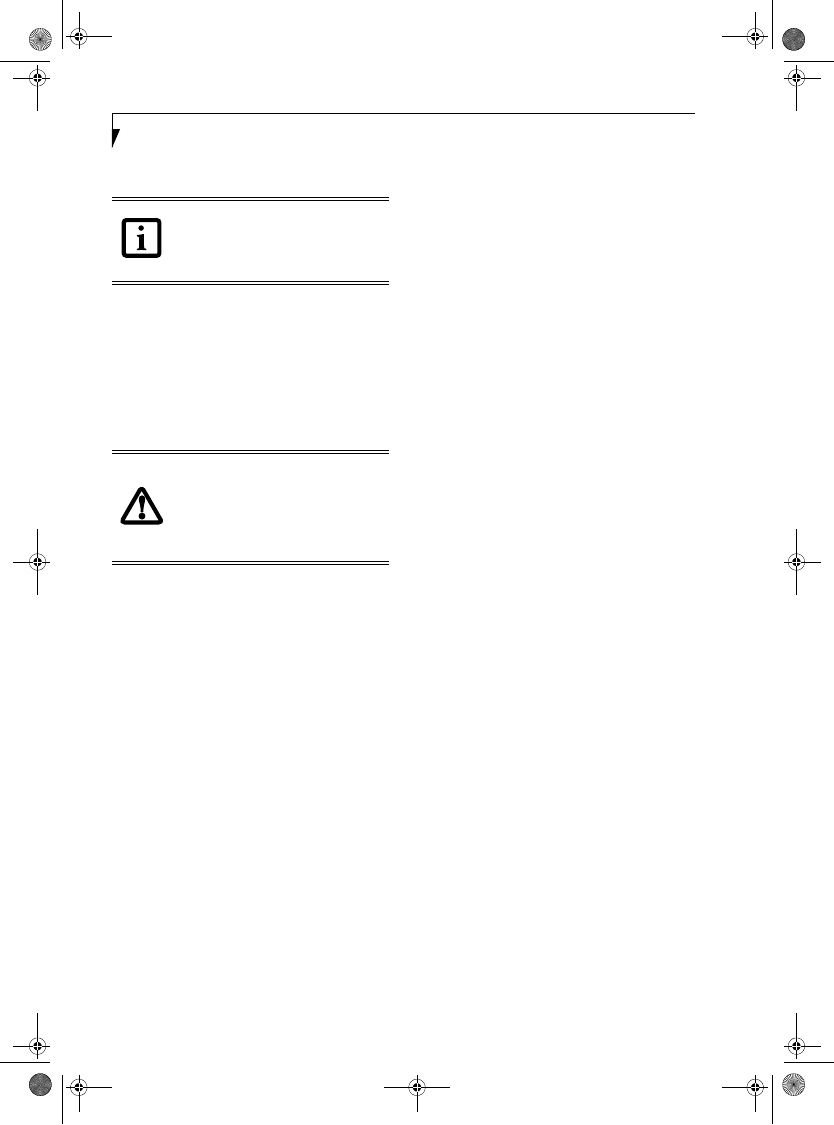
34
LifeBook B Series – Section Three
3. Click OK. Your notebook will shut down and then
reboot.
POWER OFF
Before turning off the power by choosing Turn Off
Computer from the Windows Start menu, check that the
Hard Drive, PC Card and the Floppy Disk Drive Access
indicators are all Off. (See Figure 2-5 on page 8) If you
turn off the power while accessing a disk or PC Card
there is a risk of data loss. To ensure that your notebook
shuts down without error, use the Windows shut down
procedure.
Using the correct procedure to shut down from
Windows, allows your notebook to complete its opera-
tions and turn off power in the proper sequence to avoid
errors. The proper sequence is:
1. Click the Start button, and then click Turn Off
Computer.
2. Select the Turn Off option from within the dialog
box.
If you are going to store your notebook for a month or
more see the Care and Maintenance section.
Turning off your LifeBook notebook
without exiting Windows or turning on
your notebook within 10 seconds of the
notebook being shut off may cause an
error when you start the next time.
Be sure to close all files, exit all
applications, and shut down your
operating system prior to turning off the
power. If files are open when you turn the
power off, you will lose any changes that
have not been saved, and may cause disk
errors.
B Series.book Page 34 Tuesday, April 26, 2005 3:08 PM

35
4
User-Installable
Features
B Series.book Page 35 Tuesday, April 26, 2005 3:08 PM

36
LifeBook B Series
B Series.book Page 36 Tuesday, April 26, 2005 3:08 PM
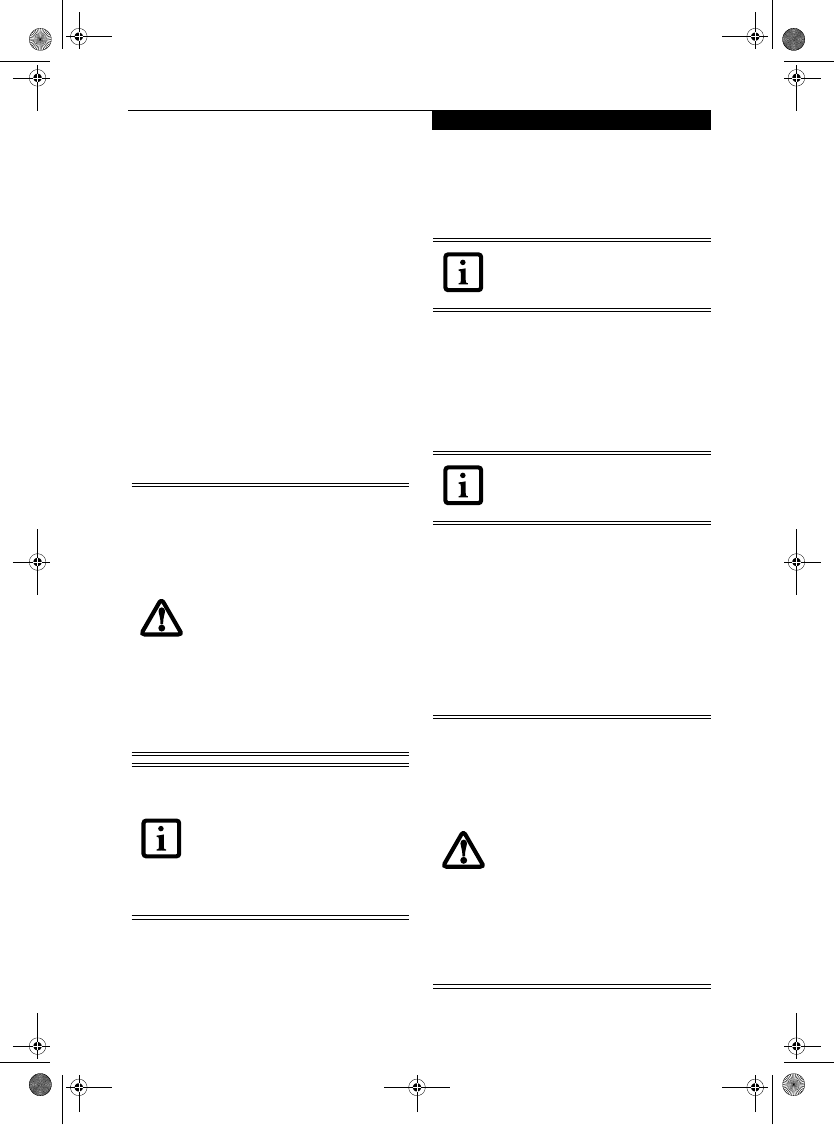
37
User Installable Features
Lithium ion Battery
Your LifeBook notebook has a Lithium ion battery that
provides power for operating your notebook when no
external power source is available. The battery is durable
and long lasting, but should not be exposed to extreme
temperatures, high voltages, chemicals or other hazards.
The Lithium ion battery operating time may become
shorter if it is used under the following conditions:
■When used at temperatures that exceed a low of 40°F
(5°C) or a high of 95°F (35°C). Extreme temperatures
not only reduce charging efficiency, but can also cause
battery deterioration. The Charging icon on the Status
Indicator panel will flash when you try to charge a
battery that is outside its operating temperature range.
See “Battery Charging Indicator” on page 14.
■When using a high current device such as a modem,
CD-ROM drive, or the hard drive. Using the AC
adapter when operating such devices will help to
conserve your battery life.
RECHARGING THE BATTERIES
If you want to know the condition of the primary
Lithium ion battery, check the Battery Level indicator
located on the Status Indicator panel. The indicator
changes as the battery level changes.
The Lithium ion battery is recharged internally using
the AC adapter or Auto/Airline adapter. To recharge the
battery make sure the battery that needs to be charged
is installed in your notebook and connect the AC or
Auto/Airline adapter.
There is no memory effect on the Lithium ion battery
therefore you do not need to discharge the battery
completely before recharging. The charge times will be
significantly longer if your notebook is in use while the
battery is charging. If you want to charge the battery
more quickly, put your notebook into Standby mode,
or turn it off while the adapter is charging the battery.
See “Power Management” on page 32.
Low Battery State
When the battery is running low, your notebook will
beep every 15 seconds and the Battery Level indicator
will flash. If you do not respond to the low battery
alarm, the batteries will continue to discharge until they
are too low to operate. When this happens there will be a
multiple beep alarm and the Battery Level indicator will
show a dead battery. Your LifeBook will then go into
Standby mode to try and protect your data for as long as
possible. There is no guarantee that your data will not be
lost once the notebook reaches this point.
■Do not leave a faulty battery in your
notebook. It may damage your AC
adapter, optional Auto/Airline adapter,
another battery or your notebook
itself. It may also prevent operation of
your notebook by draining all avail-
able current into the bad battery.
■Under federal, state, or local law it
may be illegal to dispose of batteries
by putting them in the trash. Please
take care of our environment and
dispose of batteries properly. Check
with your local government authority
for details regarding recycling or
disposing of old batteries. If you
cannot find this information else-
where, contact your support represen-
tative at 1-800-8Fujitsu.
Actual battery life will vary based on
screen brightness, applications, features,
power management settings, battery
condition and other customer preferences.
CD-ROM drive or hard drive usage may
also have a significant impact on battery
life. The battery charging capacity is
reduced as the battery ages. If your
battery is running low quickly, you should
replace it with a new one.
Make sure that the Battery Charging
indicator and the percentage charge is
shown inside the Battery Level icon on the
Status Indicator Panel.
Using heavy current devices such as a
modem or frequent CD-ROM and
PCMCIA powered external devices
accesses may prevent charging completely.
■You may not be able to hear the audio
alarm if the volume control is set too low
or is turned off by either the hardware or
software. However, you will still be able
to see the Battery Level indicator flash.
Once the low battery alarm occurs you
must save all your active data and put
your notebook into Standby mode until
you can provide a new power source.
You should provide a charged battery, an
AC power adapter, or Auto/Airline as
soon as possible.
■When you are in Standby mode there
must always be at least one power
source active. If you remove all power
sources while your notebook is in
Standby mode, any data that has not
been saved to the hard drive will be lost.
B Series.book Page 37 Tuesday, April 26, 2005 3:08 PM
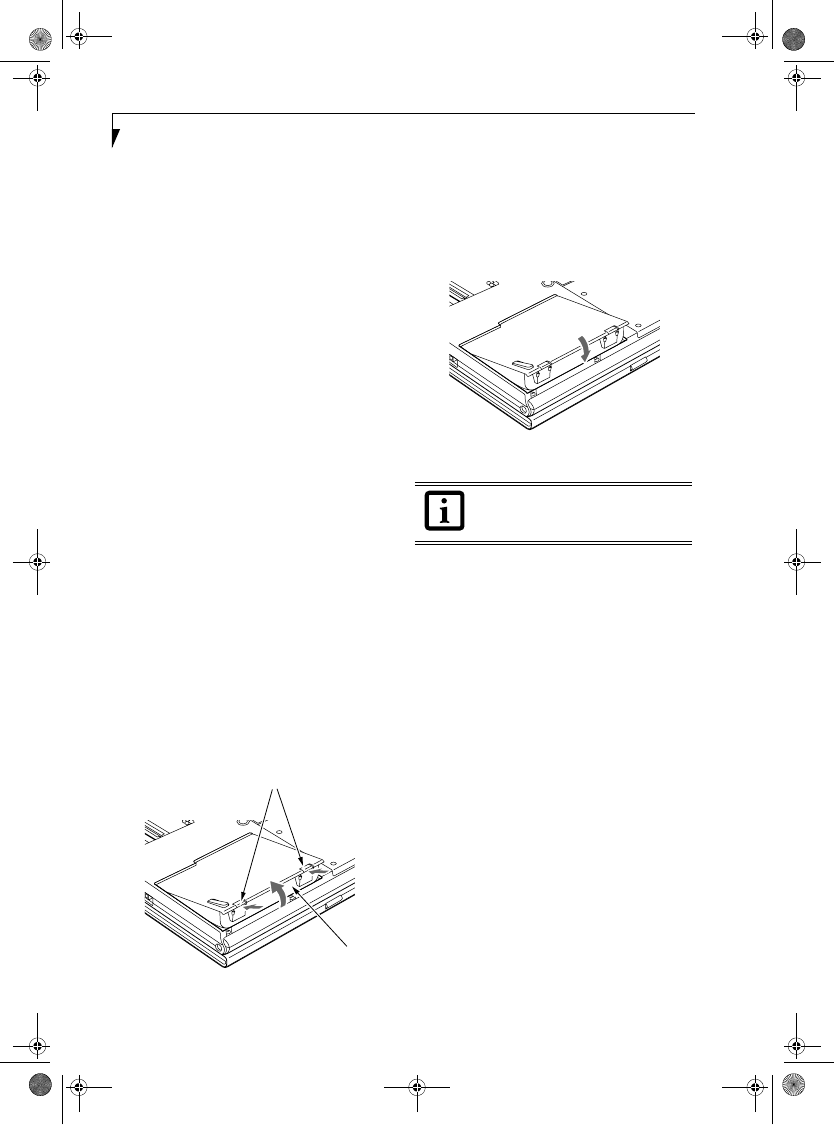
38
LifeBook B Series – Section Four
Dead Battery Suspend mode shows on the Status indi-
cator just like the normal Standby mode. Once your
notebook goes into Dead Battery Suspend mode you will
be unable to resume operation until you provide a
source of power either from an adapter, or a charged
battery. Once you have provided power, you will need to
press the Suspend/Resume button to resume operation.
In the Dead Battery Suspend mode, your data can be
maintained for some time, but if a power source is not
provided promptly, the Power indicator will stop
flashing and go out, meaning that you have lost the data
that was not stored. Once you provide power, you can
continue to use your notebook while an adapter is
charging the battery.
Shorted Batteries
The Status Indicator panel uses a symbol inside the
battery outline of the Battery Level indicator to display
the operating level available in that battery.
(See figure 2-11 on page 13) If this display shows a
Shorted Battery, it means that the battery is damaged
and must be replaced so it does not damage any other
parts of your notebook.
REPLACING THE BATTERY
Your LifeBook B Series notebook comes with one battery
pack, but it’s a good idea to purchase a second one. By
keeping a spare battery fully charged, you can immedi-
ately swap with one that is not charged. The battery can
only be replaced by cold-swapping; doing otherwise
could result in loss of data. (Cold swapping means swap-
ping batteries when the system has been powered down.)
Cold-swapping Batteries
To cold-swap batteries in your battery bay follow these
easy steps: (Figure 4-1)
1. Have a charged battery ready to install.
2. Shut down your notebook and disconnect the AC
adapter.
Figure 4-1. Removing the Battery
3. Push the battery bay release latches inward, then lift
the front of the battery away from the battery bay
and remove it from the bay.
4. Position the new battery in the bay and carefully lay
it into the tray. (Figure 4-2) Press it down so that the
latches click into place to secure the battery.
5. Turn the power on.
Figure 4-2. Installing the Battery
Battery Bay Release Latches
Battery
If the Lithium ion battery connector is not
fully seated, you may not be able to use
your notebook or charge your battery.
B Series.book Page 38 Tuesday, April 26, 2005 3:08 PM
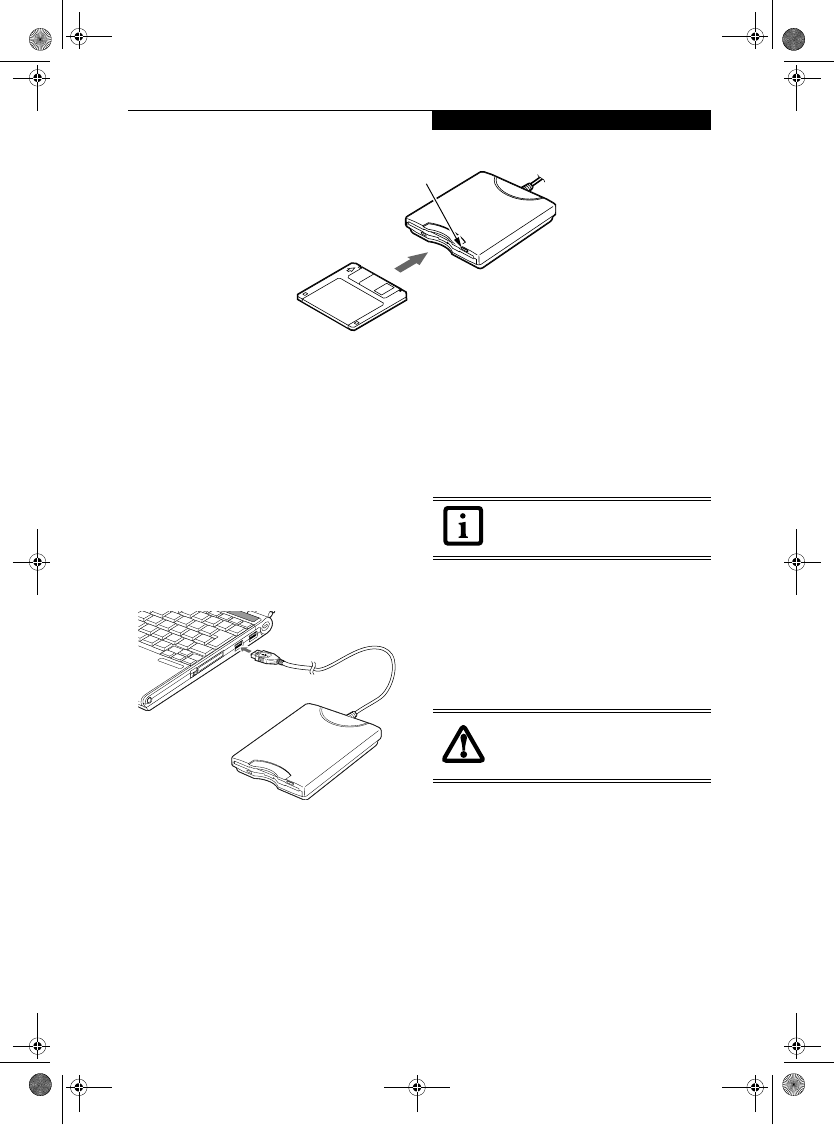
39
User Installable Features
Figure 4-3. Loading/Ejecting a 3.5” Floppy Disk
External Floppy
Disk Drive*
*Optional device
CONNECTING AN OPTIONAL
EXTERNAL FLOPPY DISK DRIVE
Your LifeBook notebook may have an optional external
floppy disk drive which can read and write information
on removable 1.44MB and 720KB floppy disks.
The USB floppy disk drive can be installed while your
system is in a suspended state (“warm” connection),
while the system is running (“hot” connection), or when
the system is off (“cold” connection).
Figure 4-4. USB floppy disk drive cable and connection
Attach the external USB floppy disk drive by inserting
the end of the cable connector into the USB port. See the
figure above.
See your computer’s User’s Guide to determine the loca-
tion of the USB port.
Your computer will automatically detect the floppy disk
drive and activate it within your system. The drive letters
associated with the floppy disk drive will be created and
listed under My Computer and Windows Explorer.
LOADING A DISK
To load a disk into your disk drive, follow these steps:
1. Orient the disk so that its label is facing upwards
and the shutter side is pointing towards the drive.
(Figure 4-3)
2. Push the disk into the drive until the Eject button
pops out and you hear a click.
EJECTING A DISK
To eject a disk from the disk drive, follow these steps:
1. Check that the Floppy Disk Drive Access indicator
is inactive.
2. Press the Eject button. This will push your disk
partially out of the drive.
3. Remove the disk.
PREPARING A DISK FOR USE
Before you can use a new disk, it needs to be prepared
so your notebook knows where to store information.
This preparation is called formatting or initializing a
disk. You will need to format new disks, unless they are
preformatted. (Please refer to your operating system
manual for step-by-step instructions on formatting a disk)
To prevent accidental erasure of the data stored on a
disk, slide the “write protect” tab until a small hole is
exposed. This sets the disk into a protected state where
nothing can be added or removed. If you want to add or
remove data on a protected disk, slide the “write
protect” tab to close the small hole. (Figure 4-5)
Eject Button
When there is no disk in the drive, the
Eject button is flush with your LifeBook
notebook.
If you eject the disk while the Floppy Disk
Drive Access indicator is active, there is a
risk of damaging the data on the disk, the
disk itself or even the disk drive.
B Series.book Page 39 Tuesday, April 26, 2005 3:08 PM
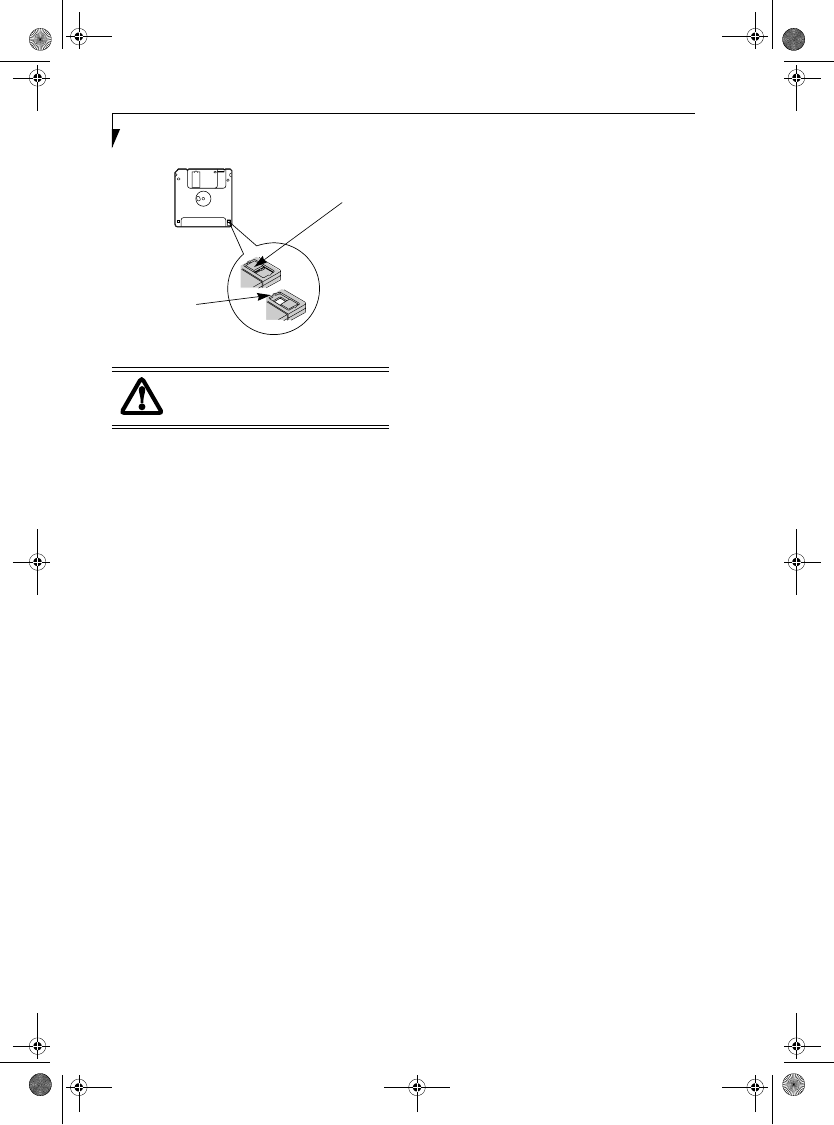
40
LifeBook B Series – Section Four
Figure 4-5. Floppy Disk Write Protect
Formatting a floppy disk that already
contains data will erase all of the
information on the disk.
Write Protected
Write Enabled
B Series.book Page 40 Tuesday, April 26, 2005 3:08 PM
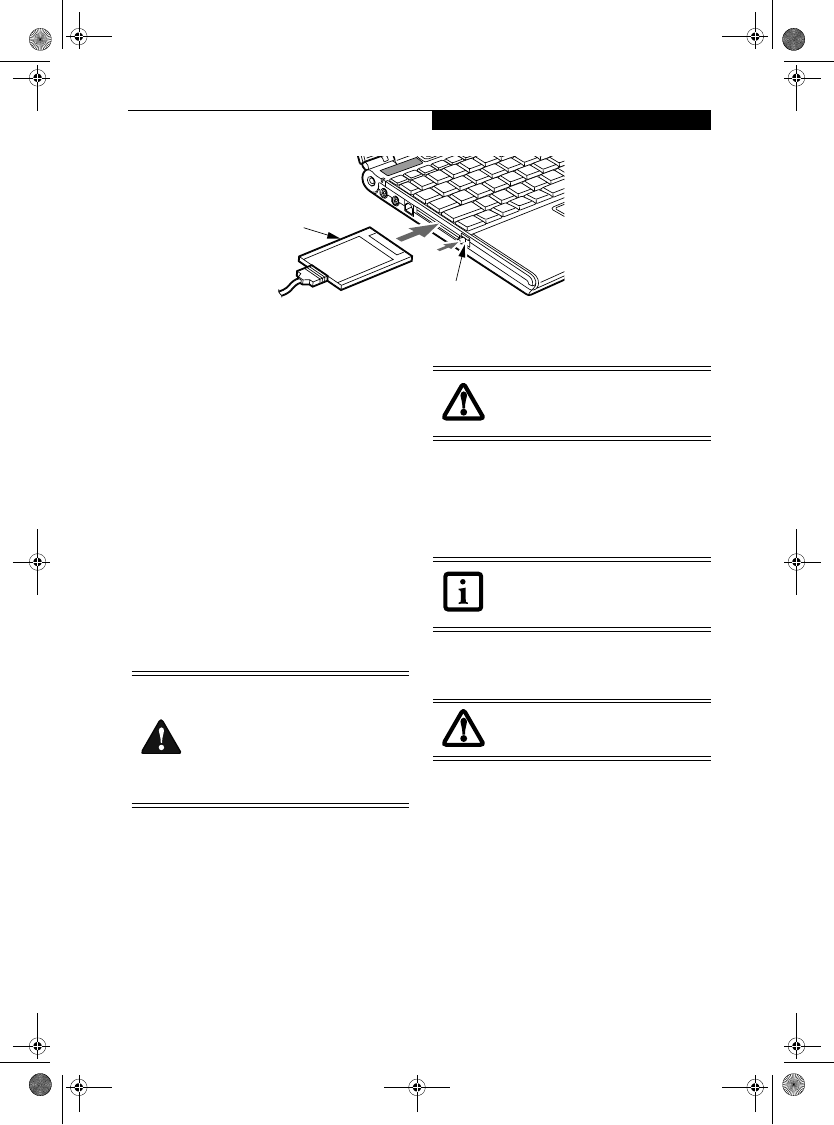
41
User Installable Features
Figure 4-6. Installing/Removing PC Cards
PC Cards
Your LifeBook notebook supports Type I and Type II PC
Cards, which can perform a variety of functions.
Some available PC Cards:
■Fax/data modem cards.
■Local area network (LAN) cards.
■IDE solid-state disk cards.
■SCSI cards.
■Other PC Cards that conform to PCMCIA 2.1 or
CardBus standards.
■Optional SmartCard adapter
For further information, refer to the instructions
supplied with your PC Card.
INSTALLING PC CARDS
PC Cards are installed in the PC Card slot. To install a
PC Card, follow these easy steps: (Figure 4-6)
1. See your PC Card manual for specific instructions
on the installation of your card. Some PC Cards
may require your notebook to be Off while
installing them.
2. Make sure there is no PC Card currently in the slot.
If there is, see Removing PC Cards.
3. Insert your PC Card into the slot, with the product
label facing up.
4. Push the card into the slot firmly until it is seated in
the opening.
REMOVING PC CARDS
To remove a PC Card, follow these easy steps:
1. See your PC Card manual for specific instructions
on removing your card. Some PC Cards may require
your notebook to be in Standby Mode or Off while
removing them.
2. Push the Eject button until it pops out, and then
push it in to eject the card. This will allow you to
remove the card.
SMART CARD READER
An embedded Smart Card Reader is provided on your
LifeBook notebook. Smart Cards are the same size and
shape as credit cards, but they contain an integrated
microprocessor chip. The chip can hold a variety of
information, and provides the user with many possible
options, such as allowing them to make secure
purchases, pay for phone calls, store security informa-
tion, and provide identification and information.
In order to use the embedded Smart Card Reader, you
must purchase an optional Smart Card holder for instal-
lation into an available Type II PC Card slot.
Eject Button
PC Card
■Installing or removing a PC Card during
your notebook’s shutdown or bootup
process may damage the card and/or
your notebook.
■Do not insert a PC Card into a slot if
there is water or any other substance on
the card as you may permanently dam-
age the card, your notebook, or both.
Windows has a shutdown procedure for
PC Cards that must be followed before
removing a card. (Review your operating
system manual for the correct procedure)
If the dialog box states that the device
cannot be removed, you must save all of
your open files, close any open
applications and shut down your LifeBook.
If the PC Card has an external connector
and cable, do not pull the cable when
removing the card.
B Series.book Page 41 Tuesday, April 26, 2005 3:08 PM
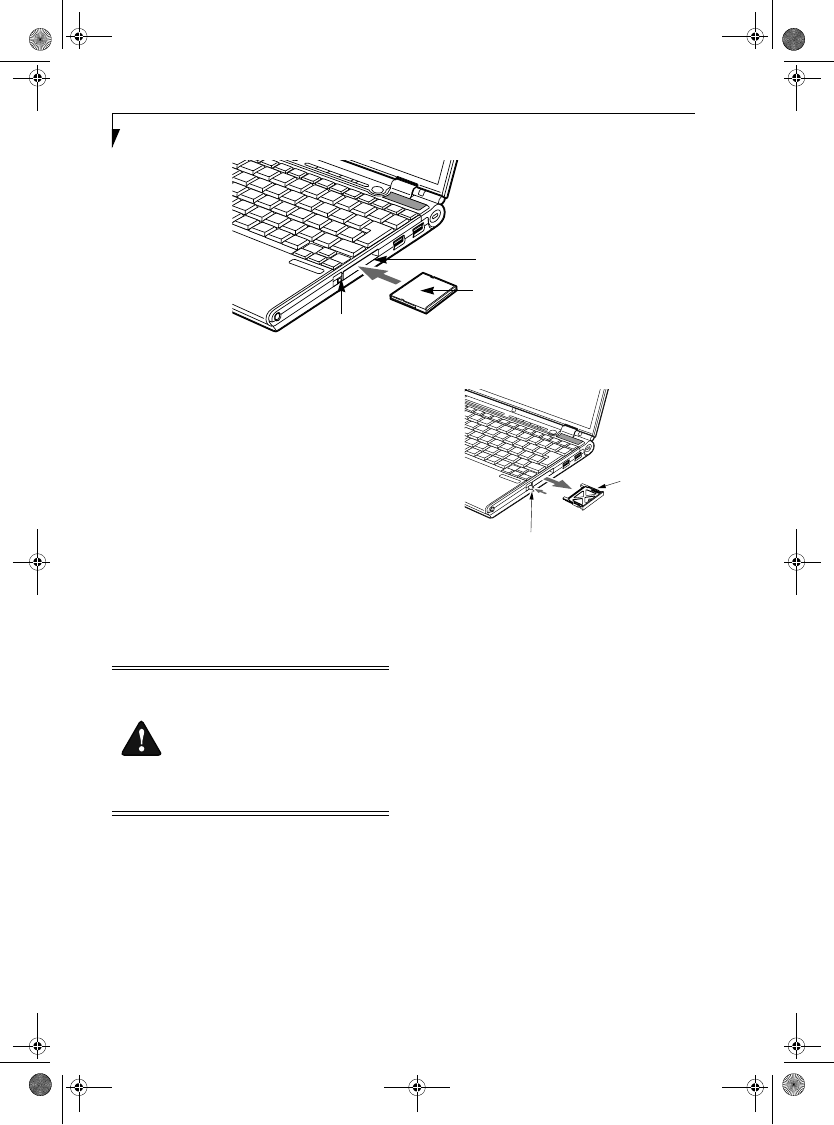
42
LifeBook B Series – Section Four
Figure 4-7. Compact Flash Card Slot
Compact Flash Cards
Your Fujitsu LifeBook notebook supports Compact
Flash (CF) cards, which can perform a variety of func-
tions.
Some available Compact Flash Cards:
■Memory cards
■Fax/data modem cards
■Local area network (LAN) cards
For further information, refer to the instructions
supplied with your PC Card.
INSTALLING COMPACT FLASH CARDS
Compact Flash Cards are installed in the Compact Flash
Card slot. To install a Compact Flash Card, follow these
steps: (Figure 4-7)
1. See your Compact Flash Card manual for specific
instructions on the installation of your card. Some
Compact Flash Cards may require your notebook to
be Off while installing them.
2. When you receive your LifeBook, there will be a
protective plug installed in the slot. Whenever you
don’t have a Compact Flash Card installed, be sure
to replace the plug to prevent system contamination.
To remove the plug, press the Compact Flash Card
eject button. (Figure 4-8)
Figure 4-8. Removing Compact Flash Slot plug
3. When the Compact Flash Slot plug is ejected,
remove it from the slot.
4. Insert your Compact Flash Card into the slot, with
the product label facing up.
5. Push the card into the slot firmly until it is seated
in the opening. You will hear a click and the Eject
button will pop away from your notebook.
Compact Flash Card Eject Button
Compact Flash Card Slot
Compact Flash Card
■Installing or removing a Compact Flash
Card during your LifeBook notebook’s
shutdown or bootup process may dam-
age the card and/or your notebook.
■Do not insert a Compact Flash Card into
a slot if there is water or any other sub-
stance on the card as you may perma-
nently damage the card, your LifeBook
notebook, or both.
Compact Flash
Slot Plug
Compact Flash
Card Eject Button
B Series.book Page 42 Tuesday, April 26, 2005 3:08 PM
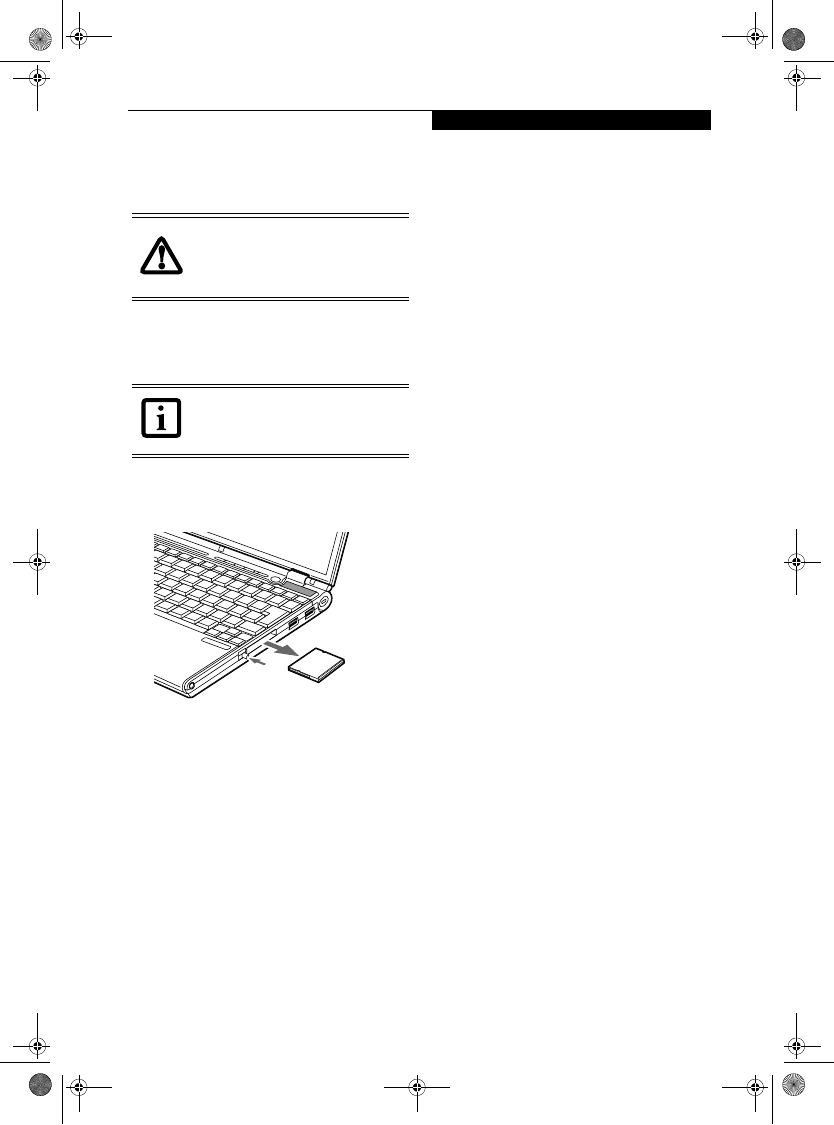
43
User Installable Features
REMOVING COMPACT FLASH CARDS
To remove a Compact Flash Card, follow these easy
steps:
1. See your Compact Flash Card manual for specific
instructions on removing your card. Some Compact
Flash Cards may require your notebook to be in
Suspend Mode or Off while removing them.
2. Push the eject button in until it is flush with the
notebook. This will push the Compact Flash Card
slightly out of the slot allowing you to remove the
card.
Figure 4-9. Removing a Compact Flash Card
Windows has a shutdown procedure for
Compact Flash Cards that must be fol-
lowed before removing a card. (Please
review your operating system manual for
the correct procedure).
If the dialog box states that the device
cannot be removed, you must save all of
your open files, close any open applica-
tions and shut down your notebook.
B Series.book Page 43 Tuesday, April 26, 2005 3:08 PM
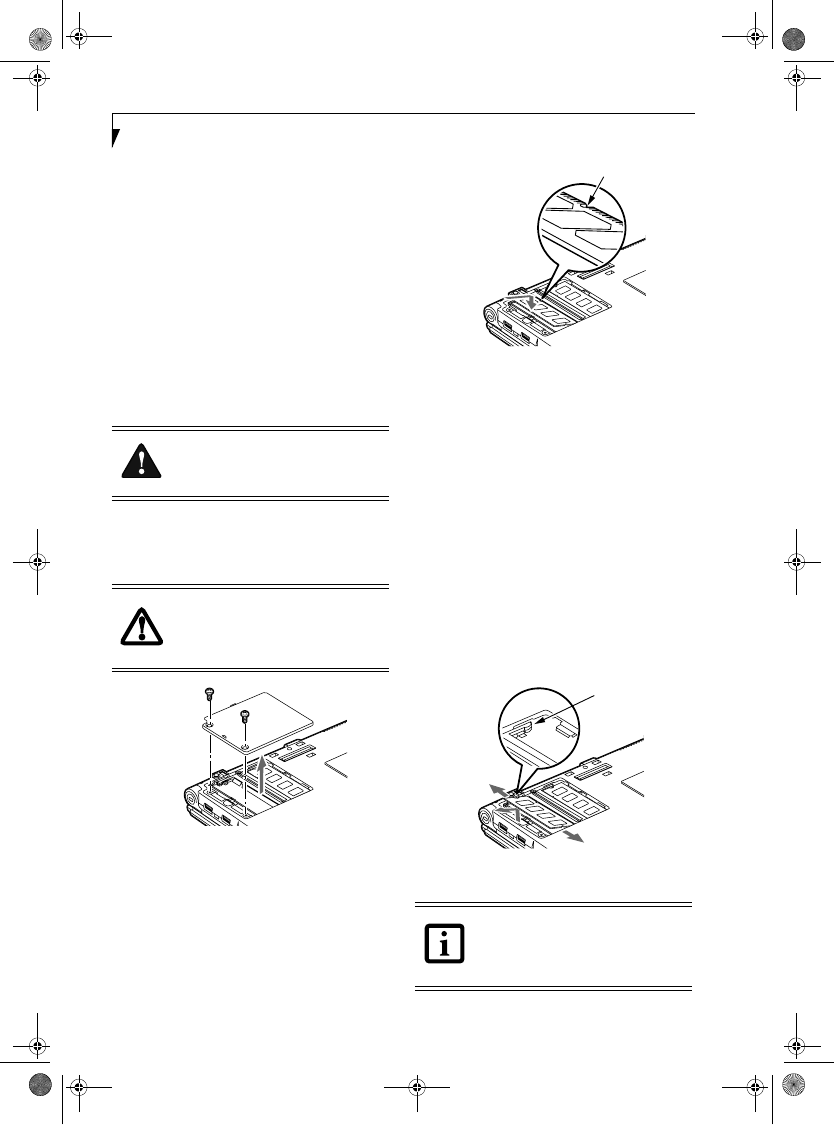
44
LifeBook B Series – Section Four
Memory Upgrade Module
Your notebook has been configured with a minimum of
256 MB of high speed DDR2 400 MHz RAM factory
installed. In addition to the installed memory, there is a
second DIMM slot in which you can install a second
module. You can also increase your notebook’s memory
capacity by replacing the original module with a higher
capacity module (2 GB maximum). The memory upgrade
must be a dual-in-line 400 MHz DDR2 module. (To be
certain the correct module is used, you should only use
Fujitsu memory modules. To order, go to the Fujitsu Web
site: http://us.fujitsu.com/computers).
INSTALLING A MEMORY MODULE
1. Turn off power to your notebook and remove any
attached power adapter (AC or auto/airline).
2. Make sure that all connector covers are closed.
3. Turn the notebook bottom side up.
4. Remove the memory upgrade compartment screws,
then remove the cover. (Figure 4-10)
Figure 4-10. Removing the Memory Module Cover
5. Align the new memory upgrade module with the
part side up. Align the connector edge of the
memory upgrade module with the empty connector
slot in the compartment (Figure 4-11).
6. Insert the memory upgrade module at a 45° angle.
Press the connector edge of the module firmly down
and into the connector until it lodges under the
retaining clip. You will hear a click when it is prop-
erly in place. (Figure 4-11)
8. Replace the memory compartment cover.
Figure 4-11. Installing a Memory Module
REMOVING A MEMORY MODULE
1. Turn off power to your notebook and remove any
attached power adapter (AC or auto/airline).
2. Make sure you are properly grounded.
3. Make sure that all connector covers are closed.
4. Turn the notebook bottom side up, with the battery
toward you.
5. Remove the memory upgrade module compartment
screws and remove the cover (Figure 4-10).
6. Pull the clips sideways away from each side of the
memory upgrade module at the same time
(Figure 4-12).
7. While holding the clips out, remove the module
from the slot by lifting it up and pulling towards the
rear of your notebook.
8. Store the memory module in a static guarded sleeve.
9. Install a new memory module as instructed in
“Installing a Memory Upgrade Module”.
Figure 4-12. Removing a Memory Upgrade Module
10. Replace the cover and the screws.
A memory module can be severely
damaged by electrostatic discharge (ESD).
Be sure you are properly grounded when
handling and installing the module.
Do not remove any screws from the
memory upgrade module compartment
except those specifically shown in the
directions for installing and removing the
memory upgrade module.
The memory upgrade module is not
something you routinely remove from
your notebook. Once it is installed, you
should leave it in place unless you want
to change system memory capacity.
Alignment Key
Module Clip
B Series.book Page 44 Tuesday, April 26, 2005 3:08 PM
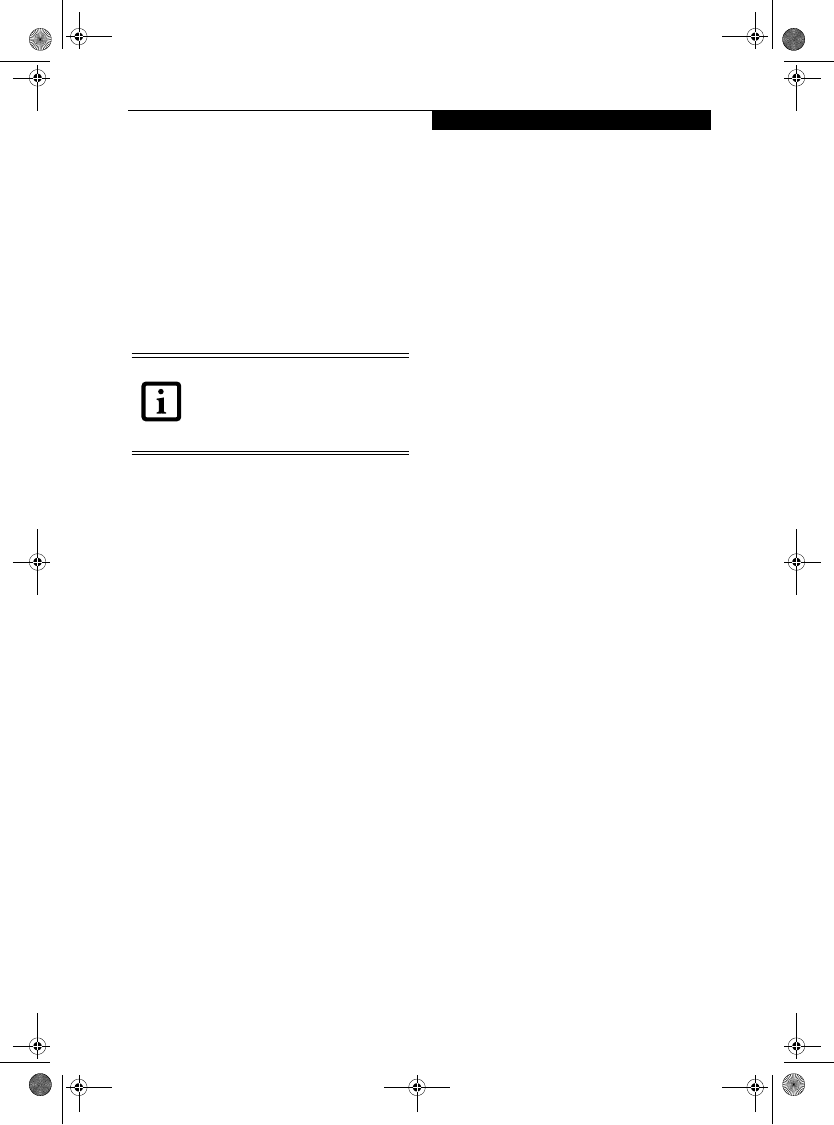
45
User Installable Features
CHECKING THE COMPUTER RECOGNITION
OF NEW MEMORY CAPACITY
Once you have changed the system memory capacity, be
sure to check that your notebook has recognized the
change.
You can check the memory capacity by looking at the
main menu of the BIOS setup:
1. Turn on the power to your notebook.
2. Right-click on My Computer.
3. Under the General tab, the amount of memory is
displayed towards the bottom right of the window.
If the total memory displayed is incorrect,
check that your memory upgrade module
is properly installed. If the module is
properly installed and the capacity is still
not correctly recognized, see
“Troubleshooting” on page 53.
B Series.book Page 45 Tuesday, April 26, 2005 3:08 PM
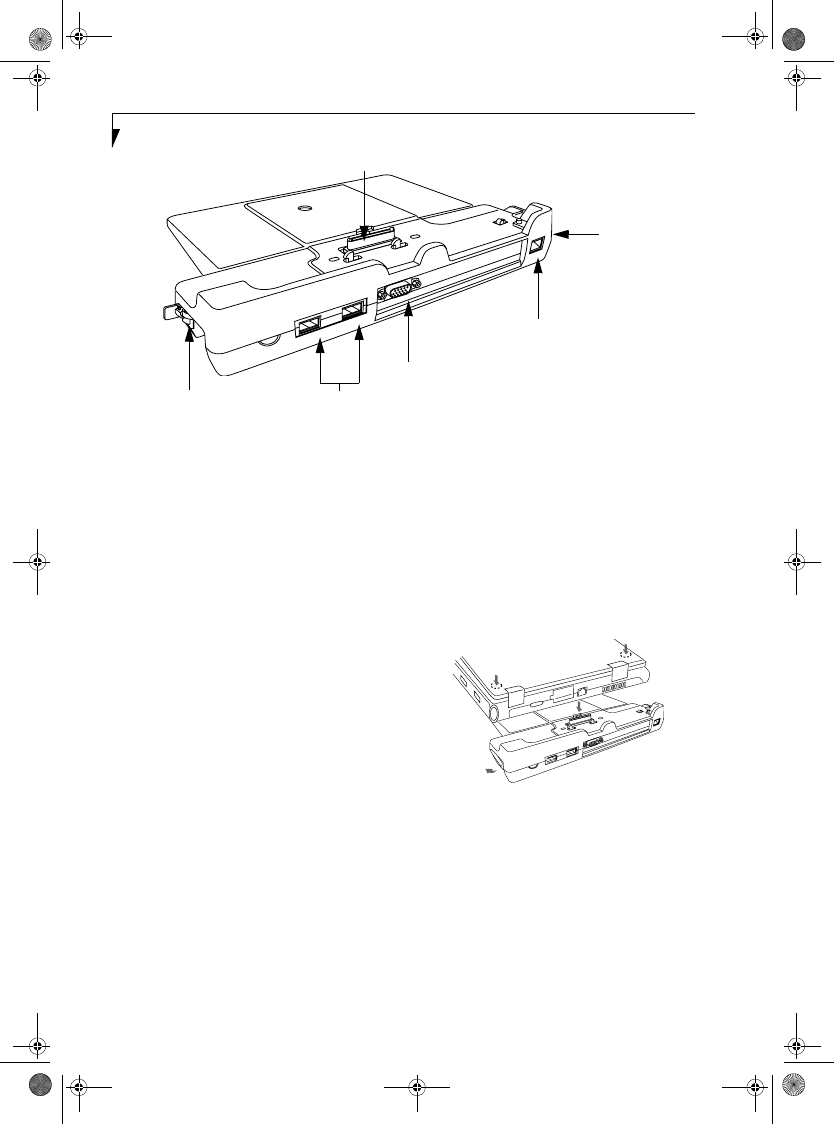
46
LifeBook B Series – Section Four
Figure 4-13. Optional Port Replicator rear panel
Port Replicator*
Ideal for quick connect/disconnect of peripheral devices,
the optional Port Replicator extends the functionality of
your LifeBook notebook by providing ports to connect a
LAN (RJ-45) cable, an external monitor, two USB 2.0
devices, and DC power.
The Port Replicator connects to the bottom of your
notebook. See “Device Ports” on page 48.
PORT REPLICATOR COMPONENTS
Following is a description of the Port Replicator components.
(Figure 4-13)
DC Power Jack
The DC power jack allows you to plug in the AC adapter
to power your notebook and charge the internal Lithium
ion battery. The DC power jack is located on the end of
the port replicator.
USB 2.0 Ports (Qty. 2)
Universal Serial Bus (USB) 2.0 ports allow you to
connect USB devices. USB 2.0 ports are backward-
compatible with USB 1.1 devices.
External Monitor Port
The external monitor port allows you to connect an
external VGA or SVGA monitor. Note that if a Port
Replicator is attached, you must use the external
monitor port on the Port Replicator, not the one on
your system.
LAN (RJ-45) Jack
The LAN jack allows you to connect a LAN to the Port
Replicator. Note that when the system is attached to the
Port Replicator, the LAN Jack on the Port Replicator
should be used, not the one on the system.
* Optional device
Docking Port
The docking port connects the Port Replicator to your
LifeBook notebook.
Port Replicator Release Latch
Pull the Port Replicator Release latch away from the Port
Replicator to remove it from your notebook.
ATTACHING PORT REPLICATOR
To attach the Port Replicator, align the Port Replicator
connector on the bottom of your notebook with the
connector on the Port Replicator and push the corners
down simultaneously. (Figure 4-14)
Figure 4-14. Attaching the Port Replicator
DETACHING PORT REPLICATOR
To detach the Port Replicator:
1. Pull the Port Replicator’s release latch away from the
Port Replicator to release it from your notebook.
(Figure 4-15)
USB Ports
External Monitor Port
LAN (RJ-45) Jack
DC Power Jack
Docking Port
Port Replicator Release Latch
B Series.book Page 46 Tuesday, April 26, 2005 3:08 PM
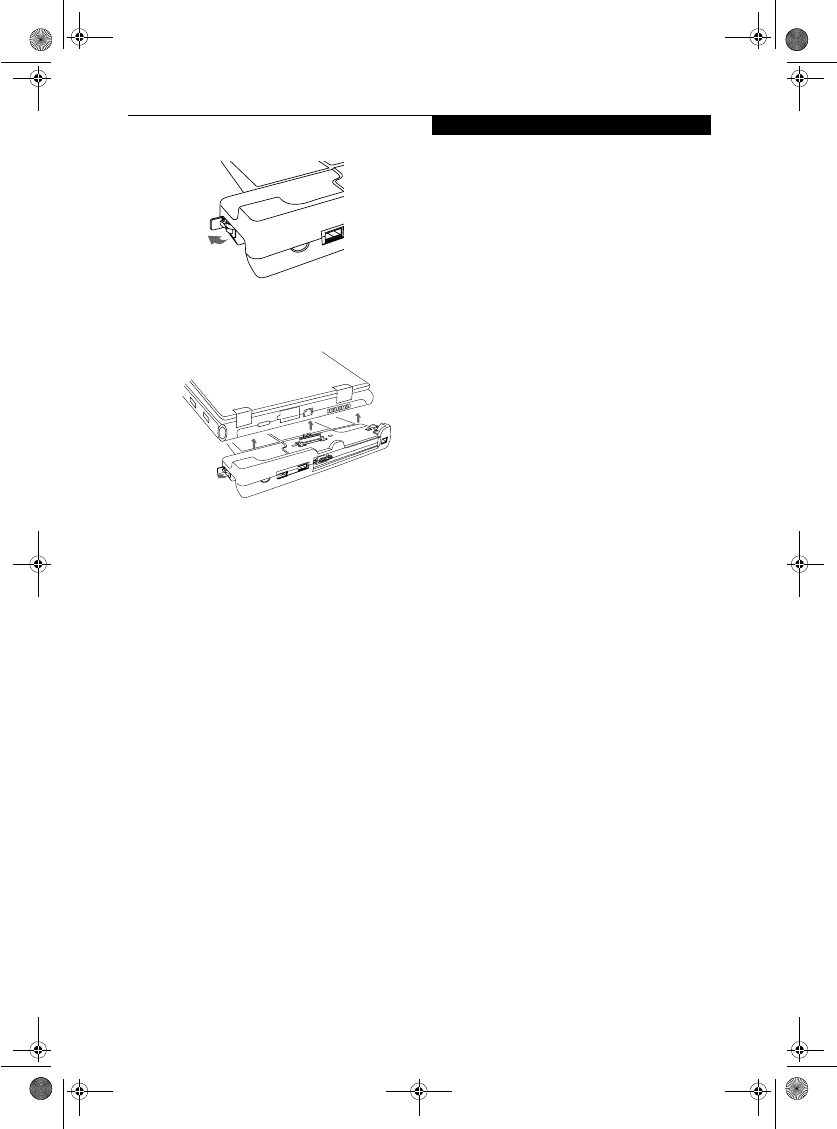
47
User Installable Features
Figure 4-15. Unlatching the Port Replicator
2. Pull the notebook away from the Port Replicator to detach
it from your notebook. (Figure 4-16)
Figure 4-16. Removing the Port Replicator
B Series.book Page 47 Tuesday, April 26, 2005 3:08 PM
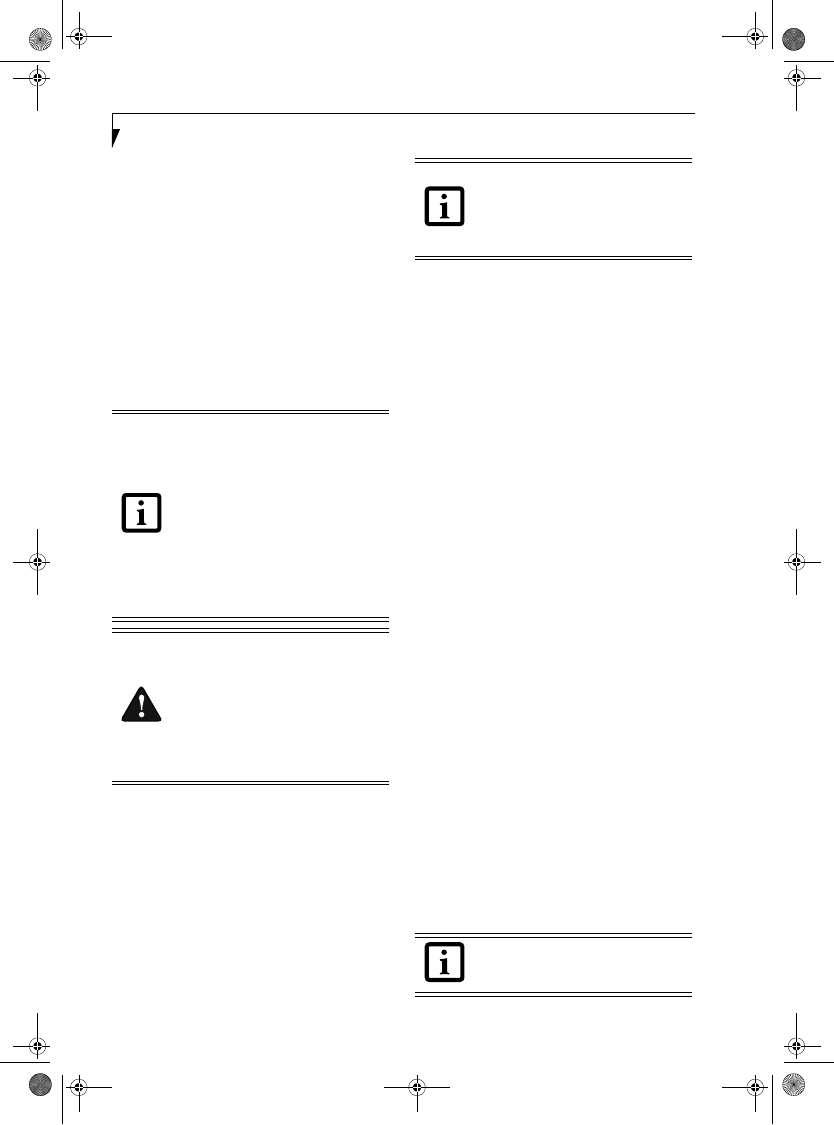
48
LifeBook B Series – Section Four
Device Ports
Your LifeBook notebook and the optional Port Repli-
cator come equipped with multiple ports to which you
can connect an external device including: disk drives,
keyboards, modems, printers, etc.
MODEM (RJ-11) JACK
The modem (RJ-11) jack is used for an internal modem.
To connect the telephone cable follow these easy steps:
See “LifeBook notebook left-side panel” on page 9.
1. Align the connector with the jack opening.
2. Push the connector into the jack until it is seated.
3. Plug the other end of the telephone cable into a
telephone outlet.
INTERNAL LAN (RJ-45) JACK
The internal LAN (RJ-45) jack is used for an internal
Fast Ethernet (10/100 /1000 Base-T/Tx) connection. If
your notebook has been configured with internal LAN
capability you will need to configure your notebook
to work with your particular network. (Please refer to
your network administrator for information on your
network configuration.) To connect the LAN cable
follow these steps: See “LifeBook notebook rear panel” on
page 12.
1. Align the connector with the jack opening.
2. Push the connector into the jack until it is seated.
3. Plug the other end of the cable into a LAN outlet.
DOCKING PORT
The docking port is used for the connection of your Life-
Book notebook to an optional port replicator. In order
to connect your notebook to one of these devices follow
the instructions that came with your docking port.
UNIVERSAL SERIAL BUS 2.0 PORTS
The two Universal Serial Bus (USB) 2.0 ports allow you
to connect USB devices such as external floppy disk
drives, game pads, pointing devices, keyboards and/or
speakers. In order to connect a USB device follow these
easy steps: See “LifeBook notebook right-side panel” on
page 10.
1. Align the connector with the port opening.
2. Push the connector into the port until it is seated.
MICROPHONE/LINE-IN JACK
The microphone/line-in jack allows you to connect an
external stereo microphone. Your microphone must be
equipped with a 1/8” (3.5 mm) mono mini-plug in
order to fit into the microphone jack of your notebook.
In order to connect a microphone follow these easy
steps: See “LifeBook notebook left-side panel” on page 9.
1. Align the connector with the port opening.
2. Push the connector into the port until it is seated.
HEADPHONE/LINE-OUT JACK
The stereo headphone/line-out jack allows you to
connect stereo headphones or powered external speakers
to your notebook. Your headphones or speakers must be
equipped with a 1/8” (3.5 mm) stereo mini-plug. In
order to connect headphones or speakers follow these
easy steps: See “LifeBook notebook left-side panel” on
page 9.
1. Align the connector with the port opening.
2. Push the connector into the port until it is seated.
■The internal modem is designed to the
ITU V.90 standard. Its maximum speed
of 53000bps is the highest allowed by
FCC, and its actual connection rate
depends on the line conditions. The
maximum speed is 33600bps at upload.
■The internal modem on all LifeBook
notebooks from Fujitsu Computer
Systems Corporation are certified for use
in the United States and Canada.
■Depending upon the configuration of
your system, your LifeBook notebook
may have either a LAN jack or an IEEE
1394 jack.
The internal modem is not intended for
use with Digital PBX systems. Do not
connect the internal modem to a Digital
PBX as it may cause serious damage to the
internal modem or your entire LifeBook
notebook. Consult your PBX
manufacturer’s documentation for details.
Some hotels have Digital PBX systems. Be
sure to find out BEFORE you connect your
modem.
Note that the optional Port Replicator is
designed to cover the LAN jack located on
the system. This design ensures that the
LAN jack on the Port Replicator is the only
one used when the Port Replicator is
installed.
If you plug headphones into the
headphone jack, the built-in stereo
speakers will be disabled.
B Series.book Page 48 Tuesday, April 26, 2005 3:08 PM
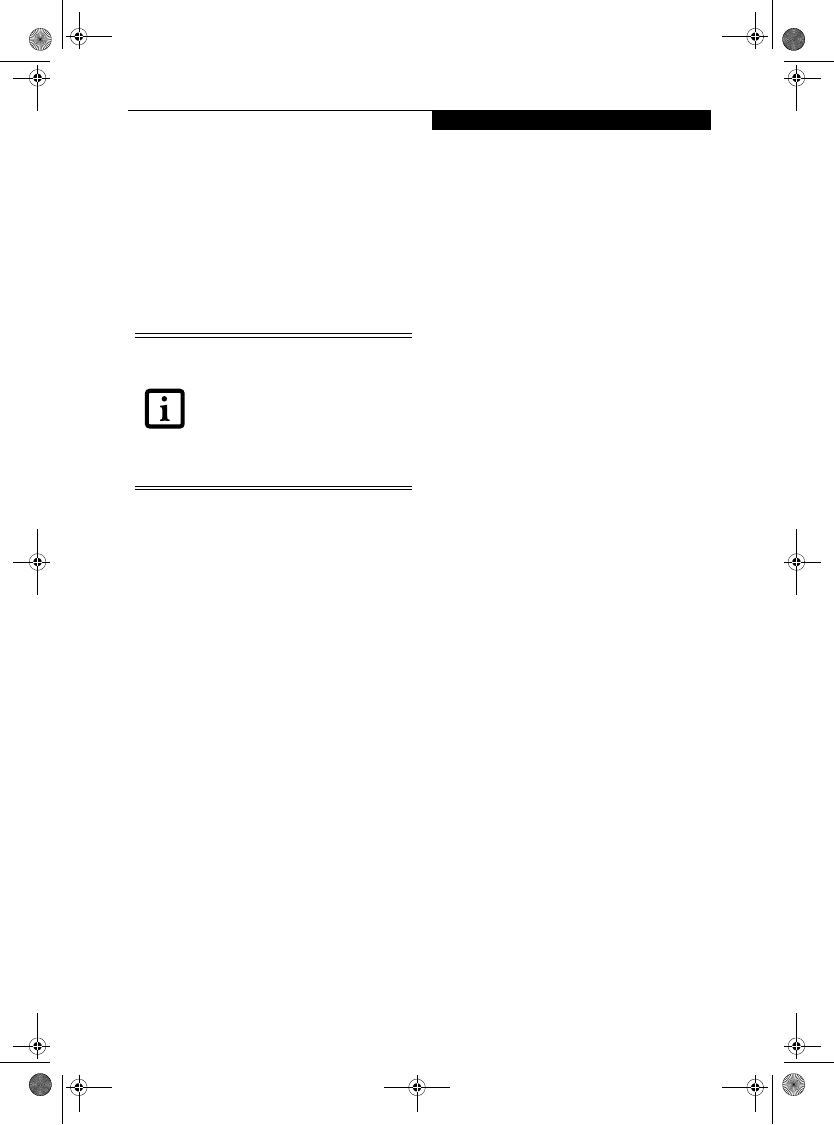
49
User Installable Features
EXTERNAL MONITOR PORT
The external monitor port allows you to connect an
external monitor. In order to connect an external
monitor follow these easy steps: See “LifeBook notebook
rear panel” on page 12.
1. Remove the cover from the port opening, if present.
2. Align the connector with the port opening.
3. Push the connector into the port until it is seated.
4. Tighten the two hold-down screws, located on
each end of the connector.
When a Port Replicator is attached and an
external monitor is plugged in, pressing
the [Fn] + [F10] keys allows you to change
your selection of where to send your
display video. Each time you press the key
combination, you will step to the next
choice, starting with the built-in display
panel only, moving to the external monitor
only, finally moving to both the built-in
display panel and an external monitor.
B Series.book Page 49 Tuesday, April 26, 2005 3:08 PM

50
LifeBook B Series – Section Four
B Series.book Page 50 Tuesday, April 26, 2005 3:08 PM